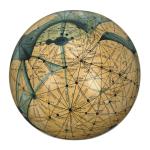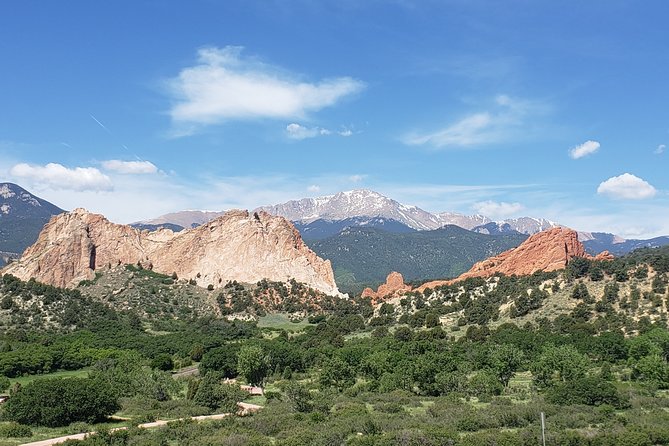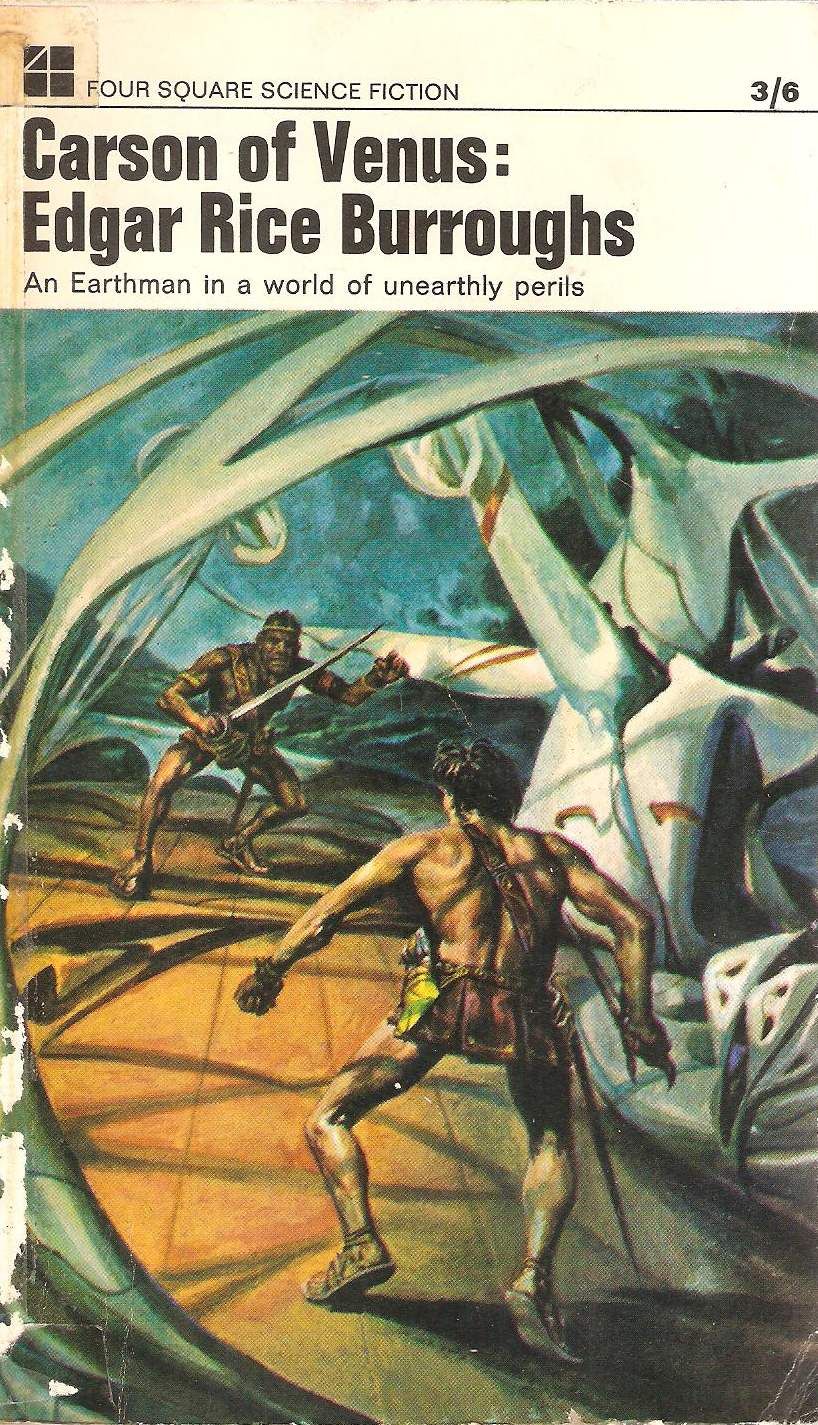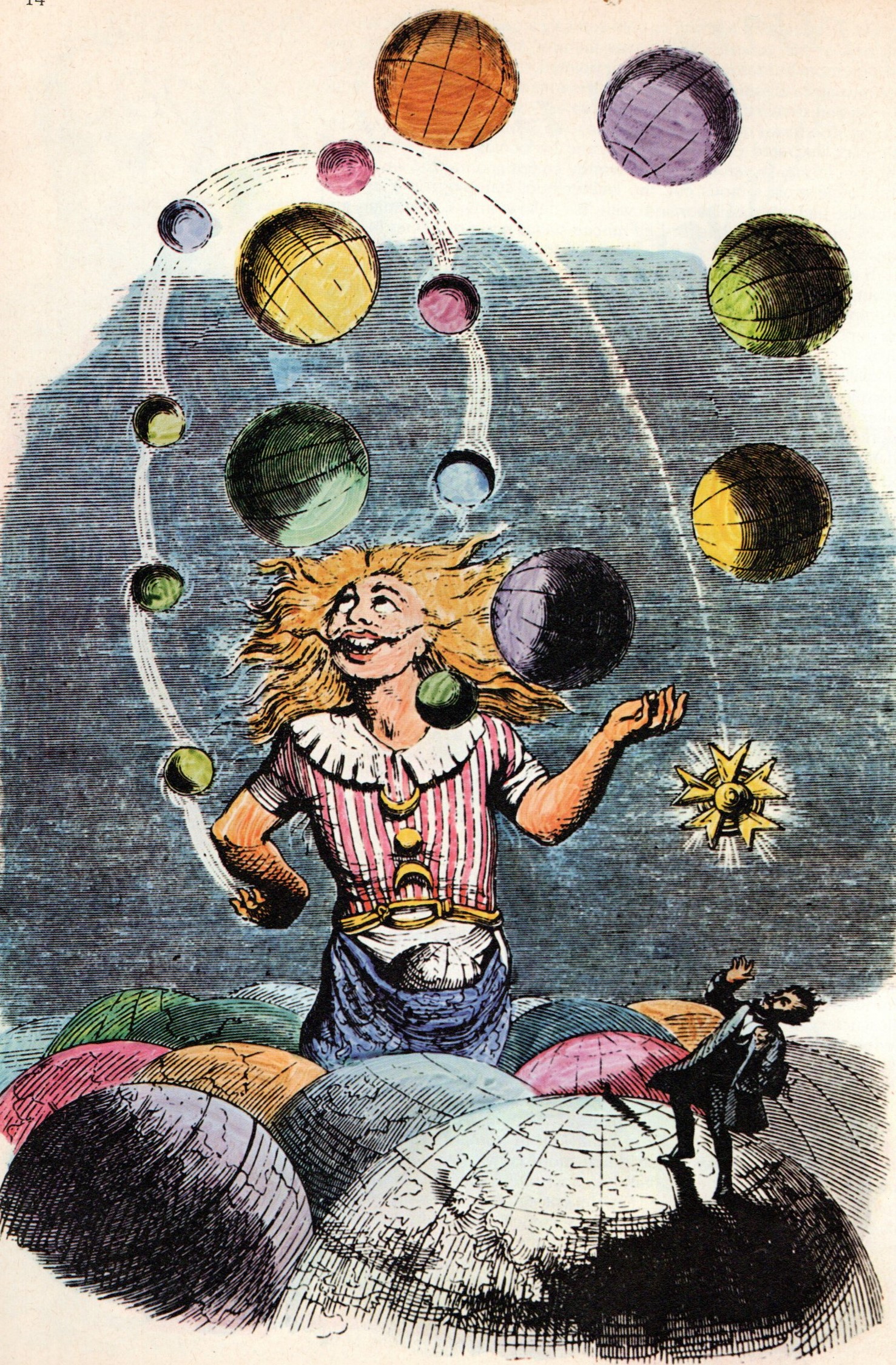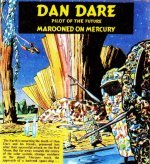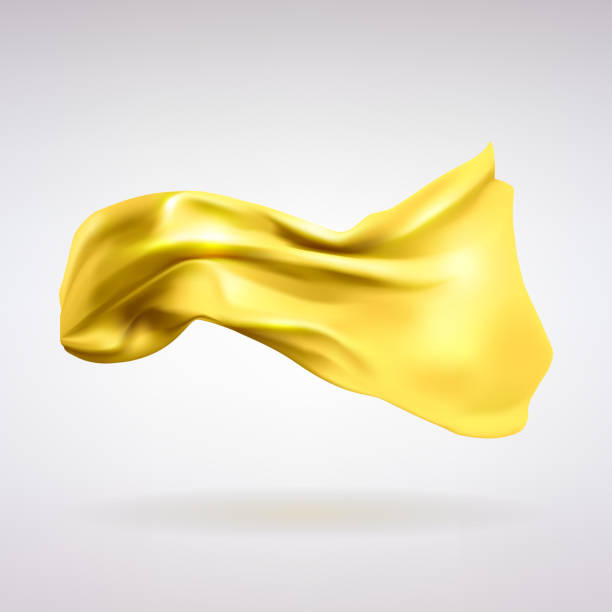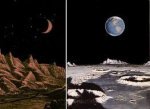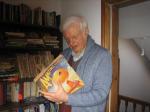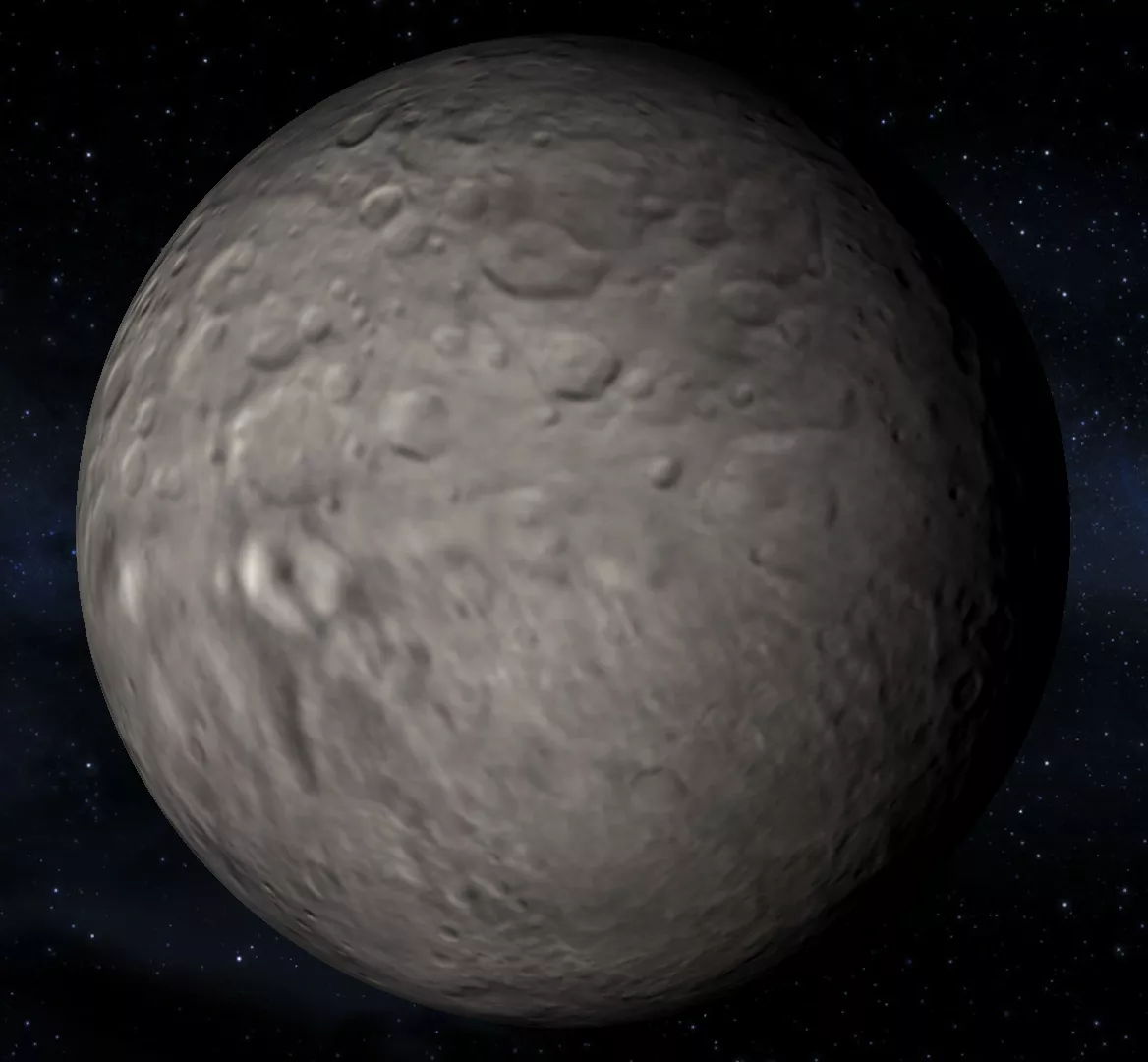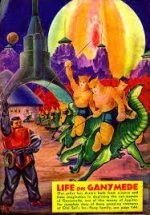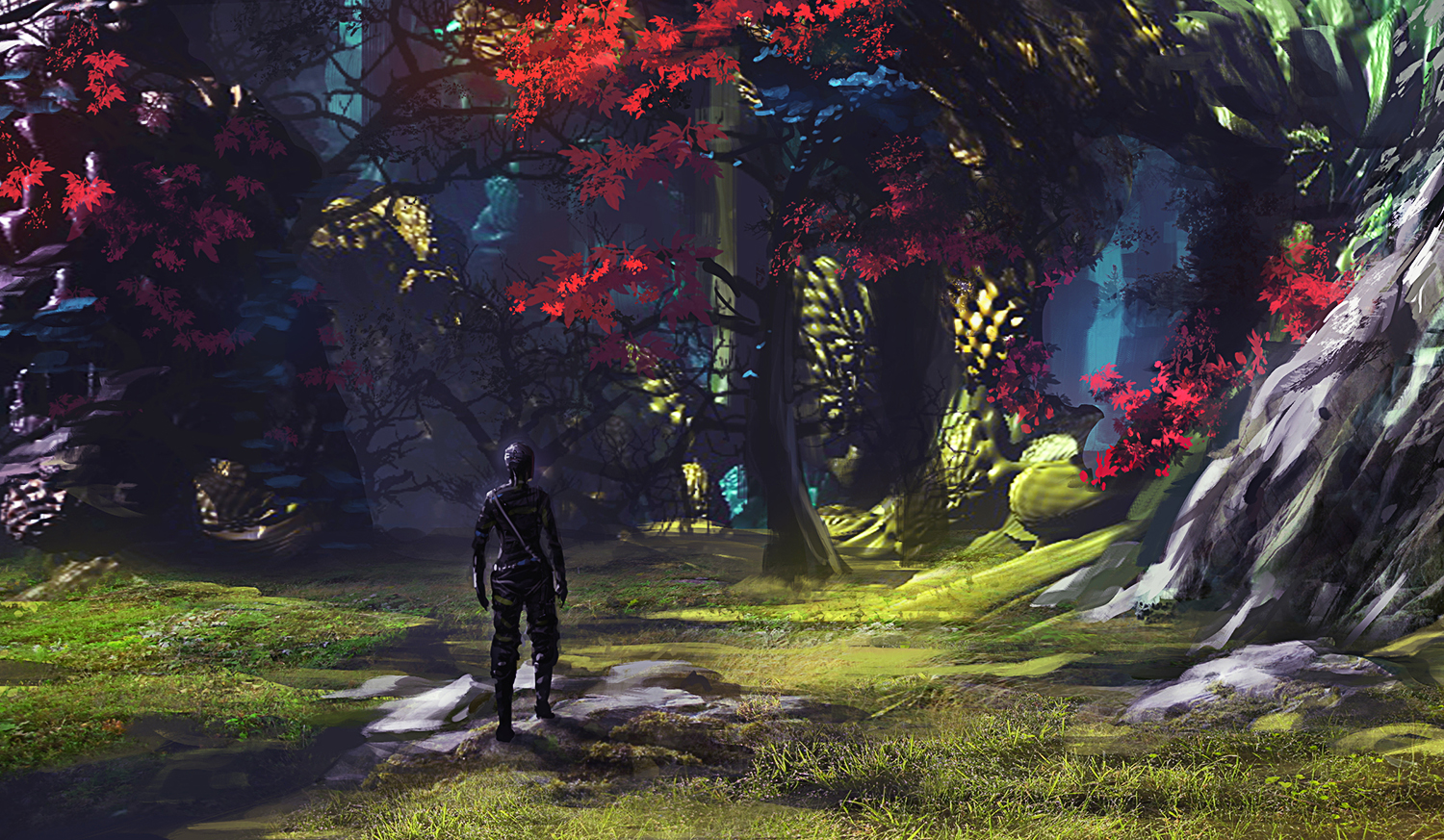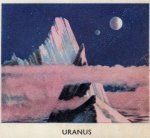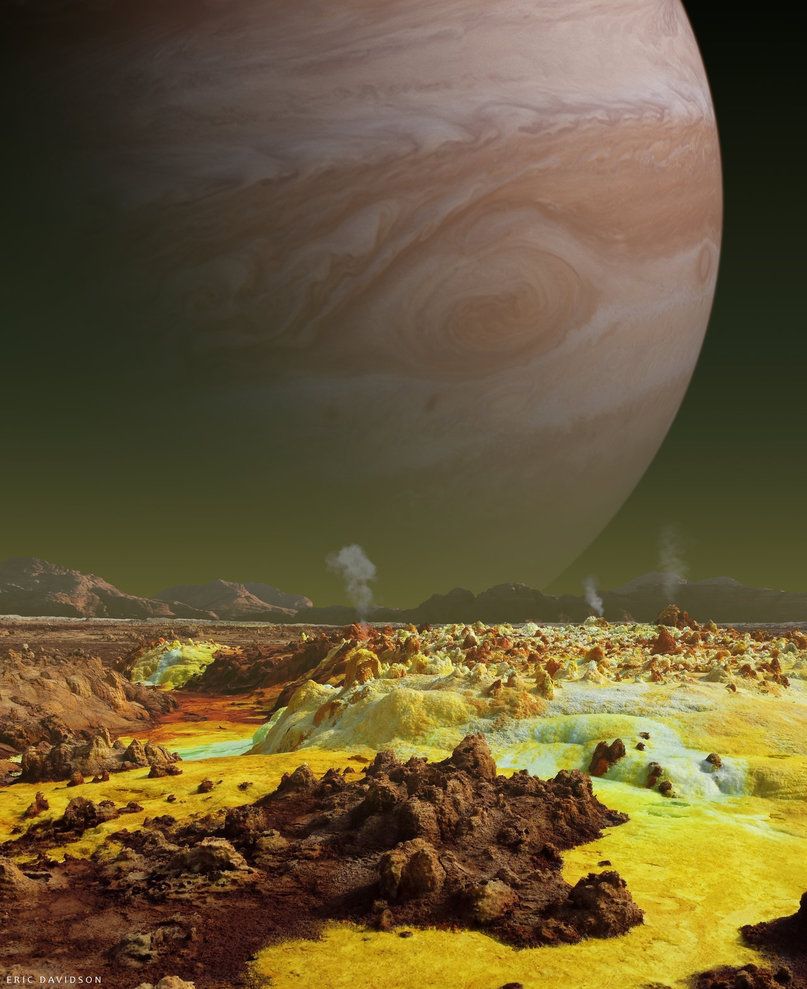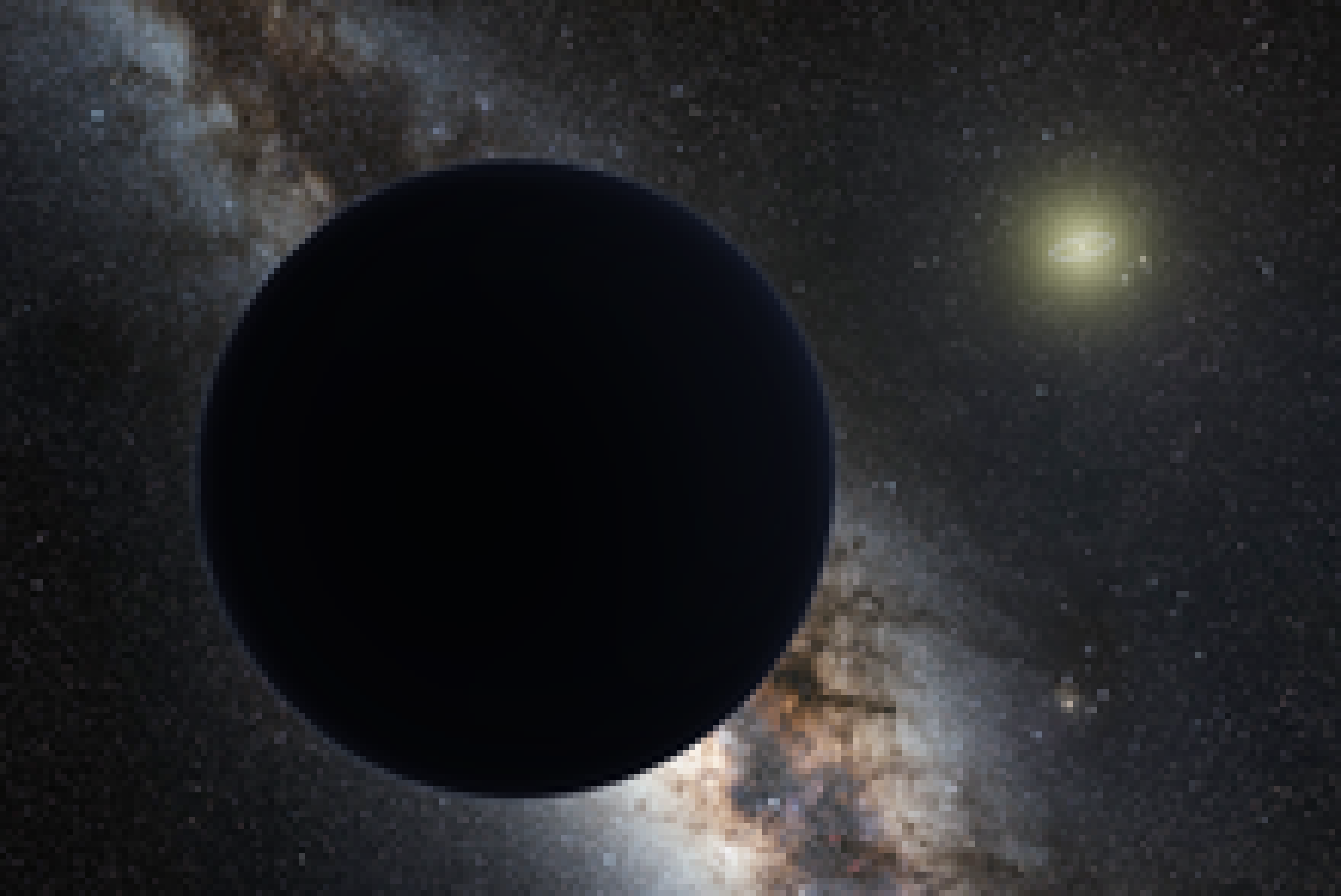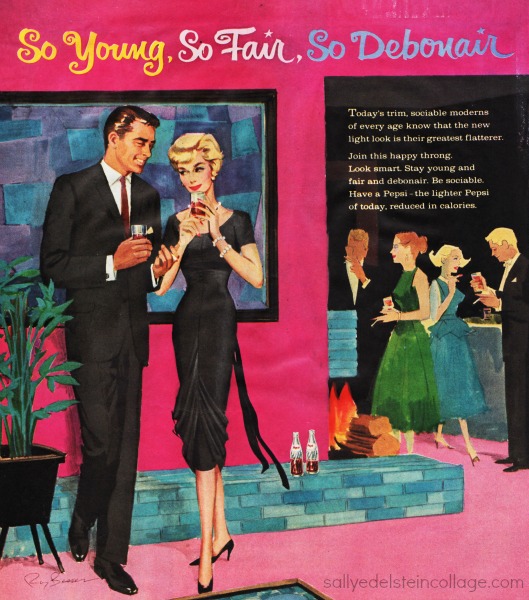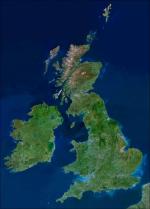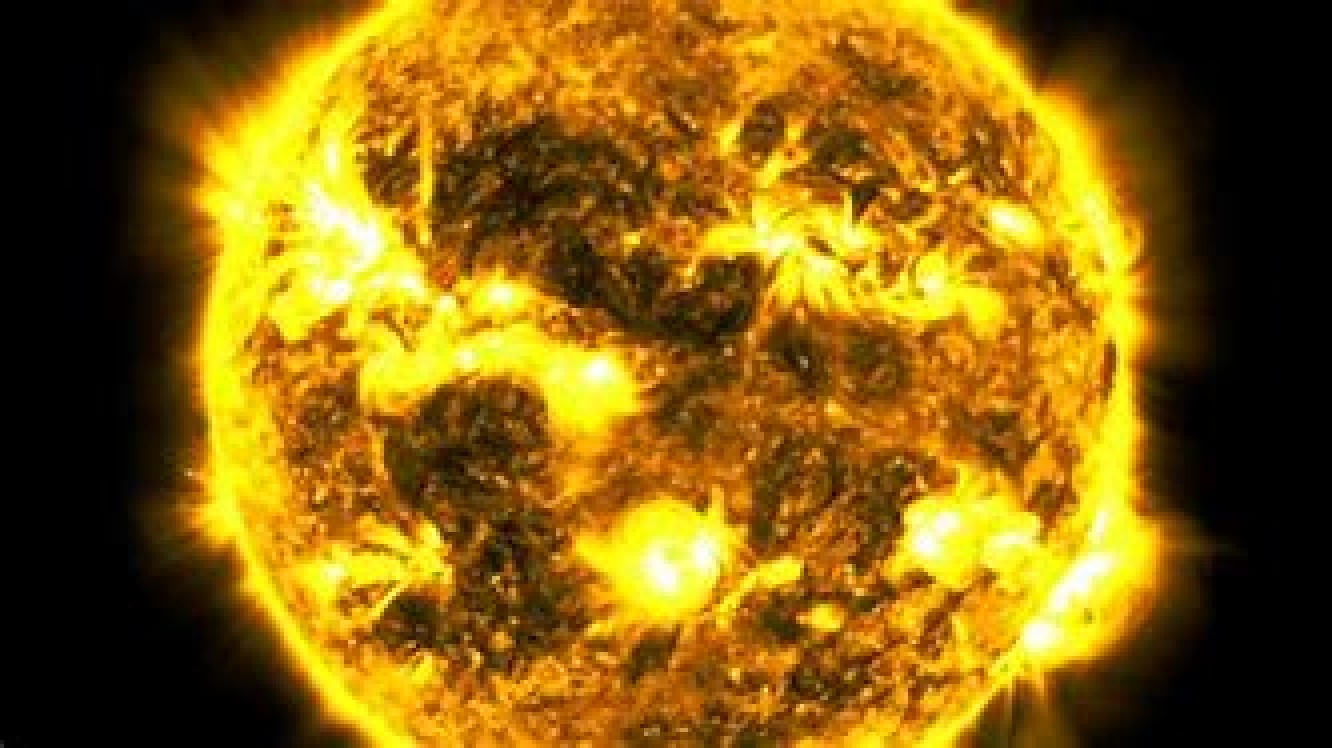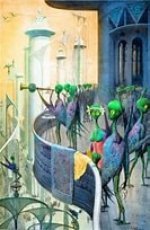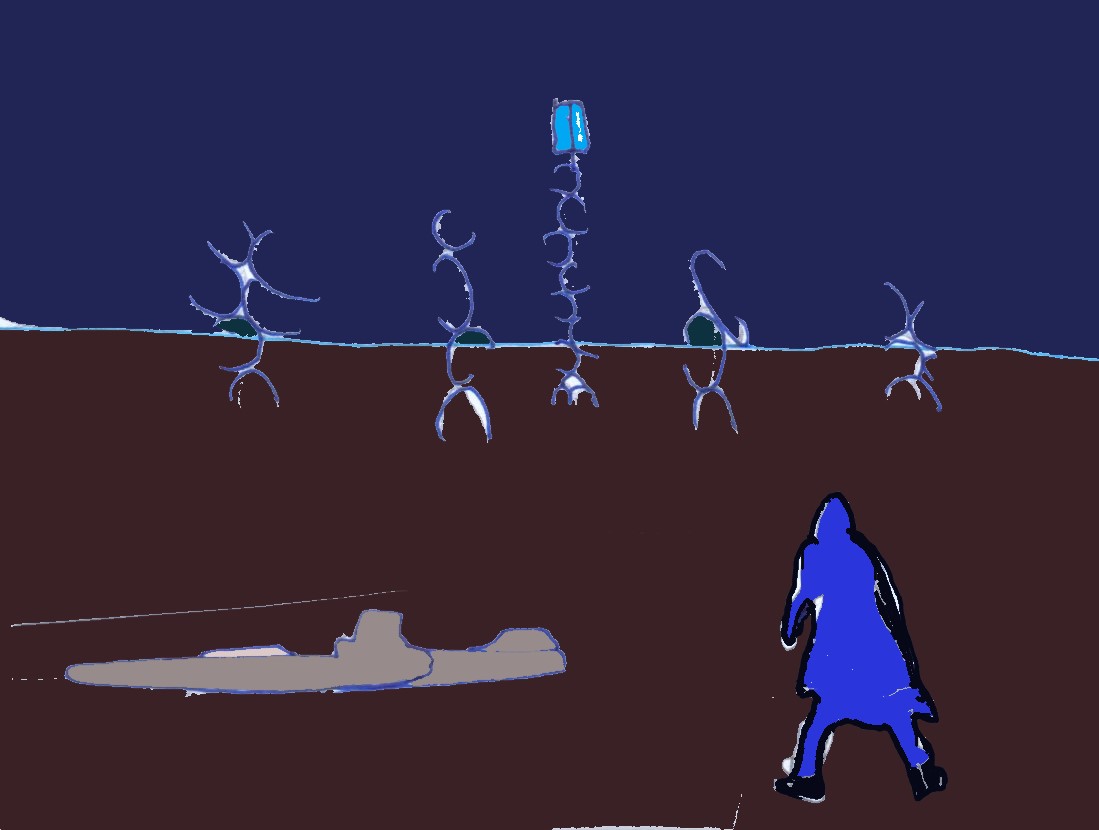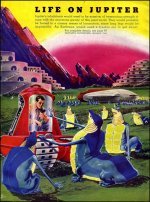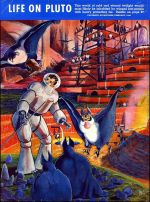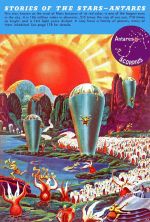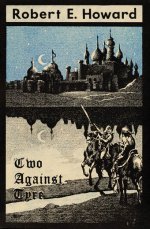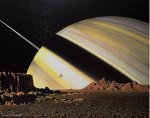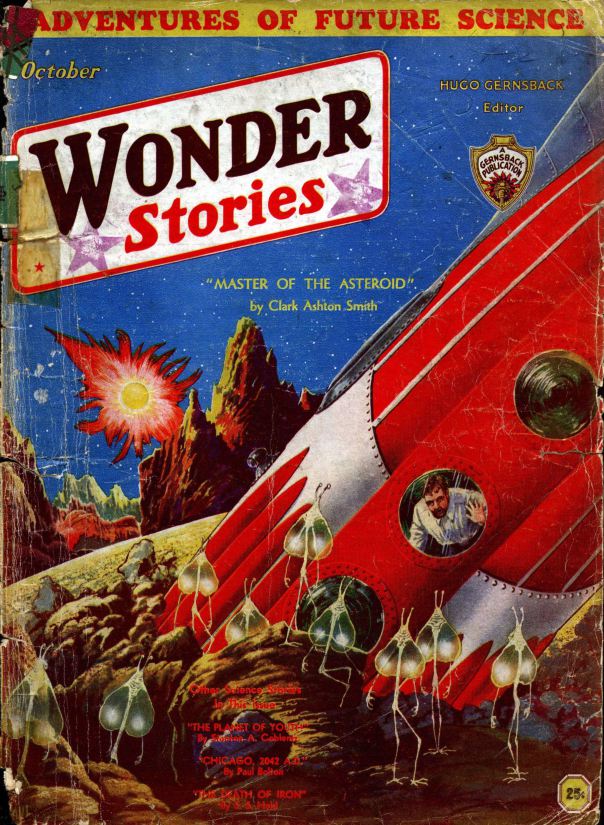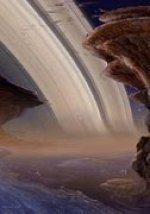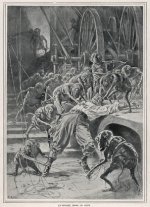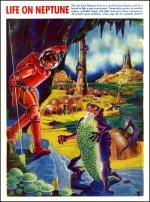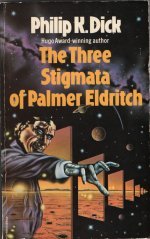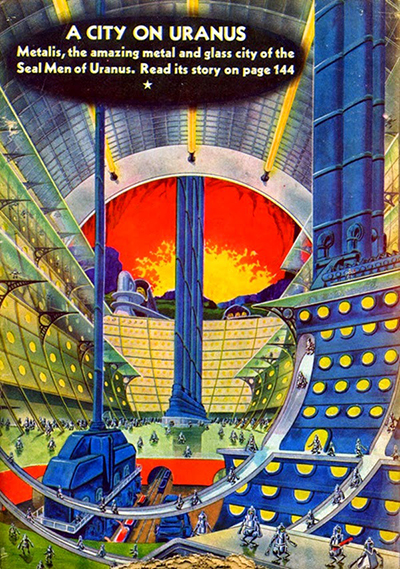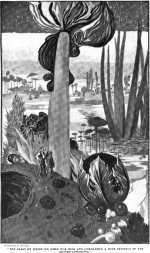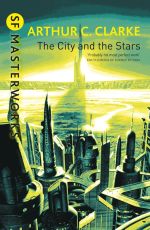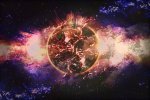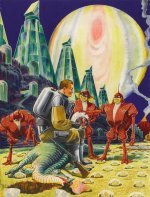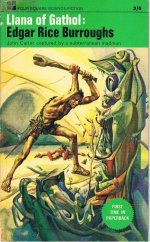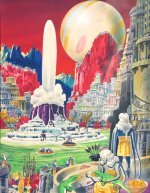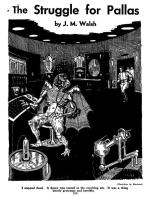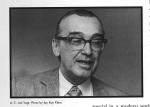- Home
- >
gazeteer
of the
haunted worlds:
fictional auras of really mapped places
on the earth, the moon and mars
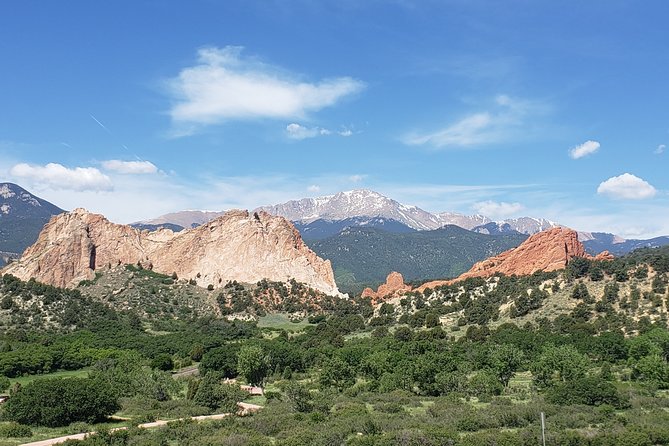 Pike's Peak - Harriman's catapult launch to the Moon
Pike's Peak - Harriman's catapult launch to the MoonNote from Zendexor, 19th November 2023: This page, begun today, was conceived in the hope that it might encourage readers to appreciate the double dimensions of our two-world system, which is replete with names that are mentioned both in story and in fact, and thus shimmers with the glorious, limitless iconography of the sf imagination. The further decision to include some Martian references is discussed in Extending the Gazetteer to cover Mars.
[ + link to: America's own haunting ]
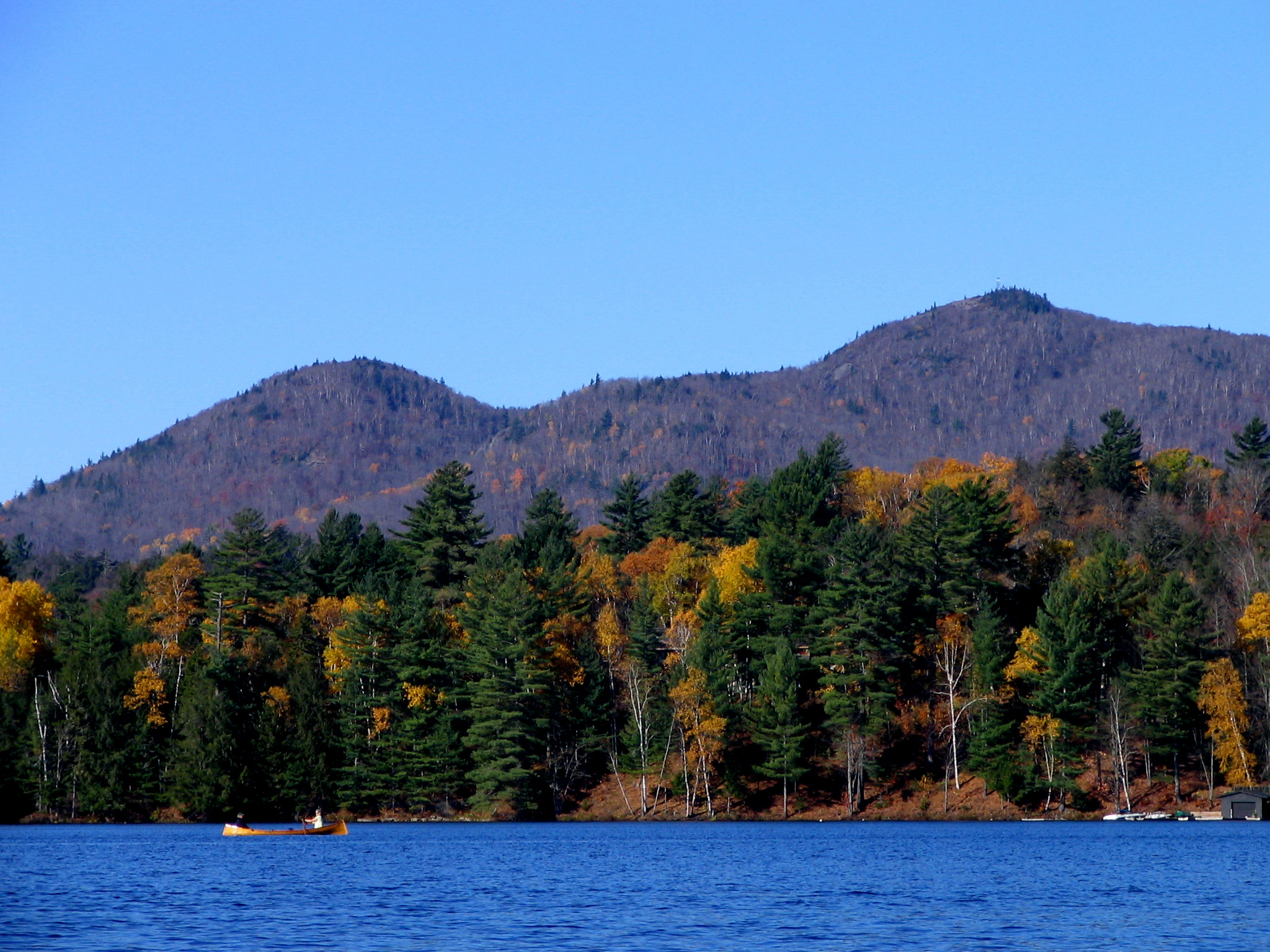 Upper St.Regis Lake
Upper St.Regis Lakethe Adirondacks, New York, USA:
While on a fishing holiday in the St Regis range of lakes in this mountain range, the narrator of Howard Fast's The Large Ant (Fantastic Universe, February 1960) sees an alien and instantaneously kills it in a fear-response.
...I keep trying to think back, to recreate the moment when I saw it standing at the foot of my bed in the fishing shack. I keep trying to dig out of my memory a clear picture of what it looked like...
Aeria: See Sinus Sabaeus.
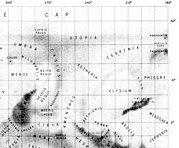 In the middle. South of Utopia and north-west of Elysium.
In the middle. South of Utopia and north-west of Elysium.Aetheria:
The region in which the protagonist's plane crash-lands, leading to an accidental discovery of vital importance fauna, in Arthur C Clarke's 1951 novel The Sands of Mars.
"There seem to be hills all around us: we were lucky to get down in one piece. Good Lord - there's a cliff here on this side - another few metres and we'd have gone smack into it!"
"Any idea where we are?" Gibson called to the pilot.
This tactless remark earned him a very stony stare.
"About 120 east, 20 north. The storm can't have thrown us very far off course."
"Then we're somewhere in the Aetheria," said Gibson, bending over the maps. "Yes - there's a hilly region marked here. Not much information about it."
"It's the first time anyone's ever landed here - that's why. This part of Mars is almost unexplored: it's been thoroughly mapped from the air, but that's all."
[Note that you won't find Aetheria on the official map of Mars' albedo features by using the co-ordinates mentioned in the above extract. Instead, the region is to be found at longitude 240. In other words, it appears one must subtract the 120 from 360, which suggests to me that some time between the 1950s and about 1970 there was a switch away from E and W figures and to a single-measure 0-360 longitude; somewhat analogous to a change from a.m./p.m. to a 24-hour clock.]
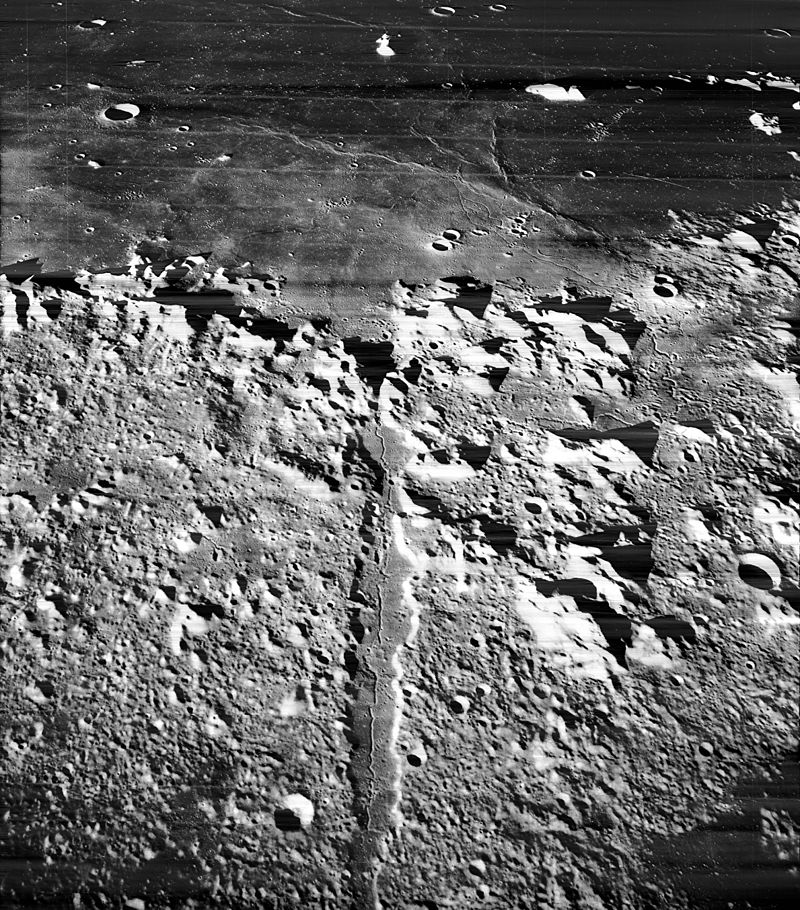 from Lunar Orbiter 5
from Lunar Orbiter 5the Alpine Valley:
Location of the lunar base of far-future Earth's corrupt Overseer, in The Fury Out of Time (1965), by Lloyd Biggle Jr.
The moon base was enormous. A gigantic dome pimpled with observation bubbles, it lay at the jagged edge of the Mare Imbrium, in the yawning mouth of the great Alpine Valley gorge. At the other end of a connecting tube was a smaller dome, the landing dome, and the complex viewed from above gave the impression of a lopsided dumbbell. Nearby were a number of lesser domes, surmounting a complex network of underground tunnels.
The base was enormous - and virtually empty. At some time in the distant past it had been a thriving city, perhaps a crucial steppingstone in man's first awkward lurch toward the stars...
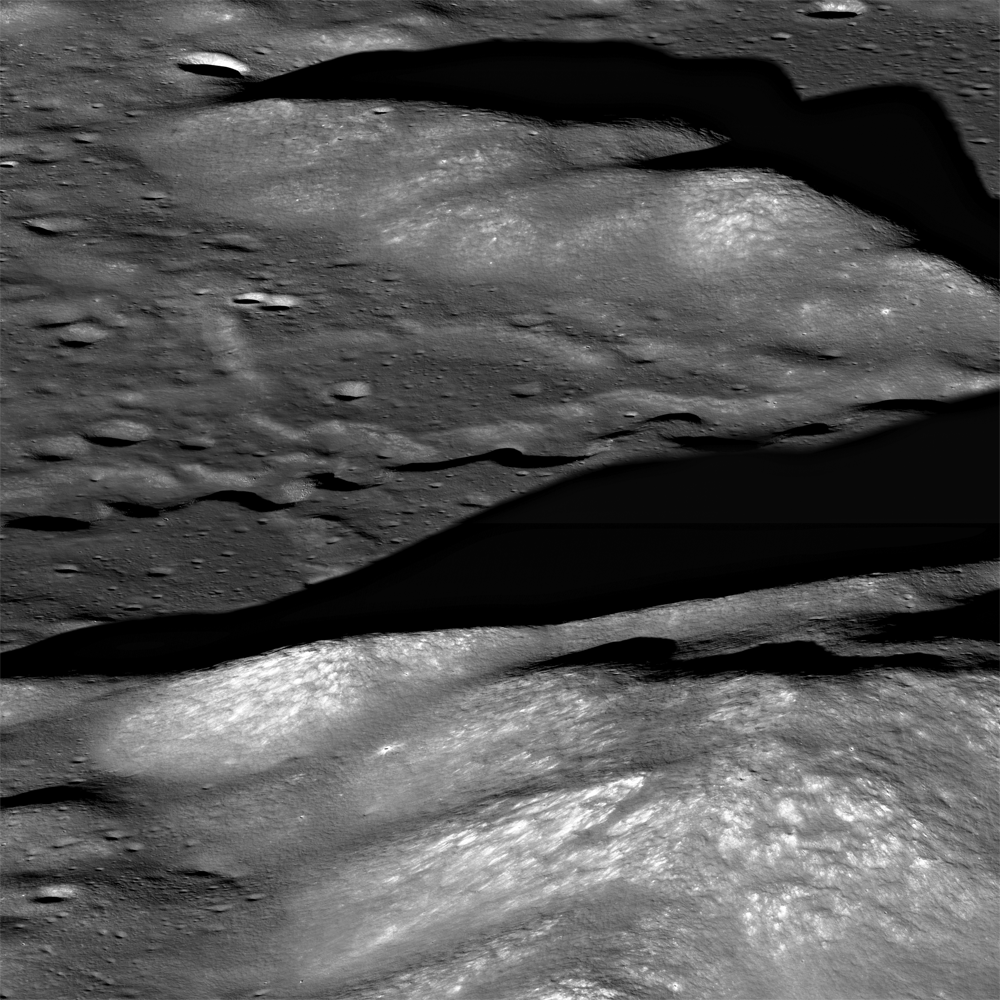
the lunar Alps:
In Poul Anderson's short story The Light (Galaxy, March 1957) the narrator, one of a crew of astronaunts who think they are first on the Moon, says:
...we landed at the foot of the Lunar Alps, not far from the crater Plato. It was rugged country, but our gear had been designed for such a place...
...It was eerie. I've been in deserts on Earth, but they don't blaze so bright, they aren't so absolutely dead, and the rocks aren't so huge and razor-cornered. The southern horizon was hear; I thought I could see the surface curve away and tumble off into a foam of stars...
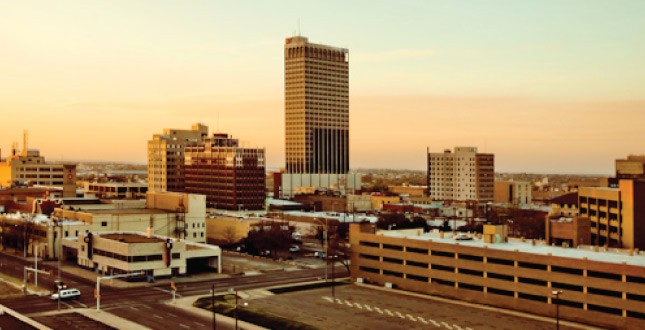
Amarillo, Texas, USA:
Miss Perth, secretary to Dr Eric Sweetscent in Philip K Dick's Now Wait for Last Year (1966), came from this city to work in Tijuana.
...this time she had sprayed herself a shiny blue, inlaid with sparkling fragments that reflected the outer office's overhead lighting... Miss Perth smiled at him engagingly, showing spotless ebony teeth, a chilling affectation which had migrated with her from Amarillo, Texas, a year ago...
Amazonis Planitia, Mars: see Strymon.
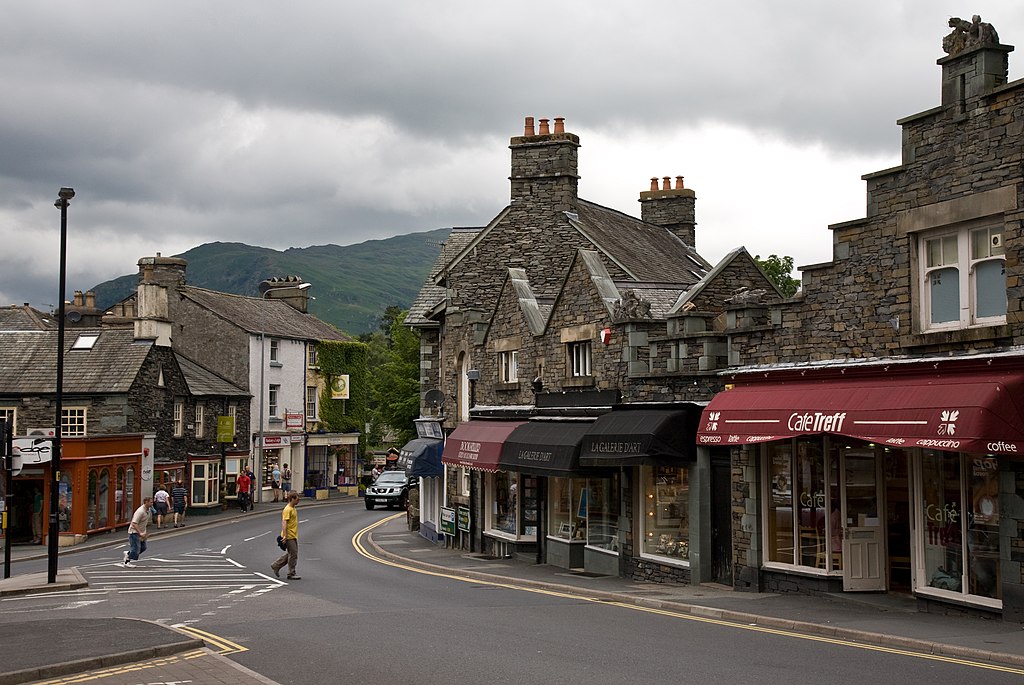
Ambleside, Westmorland, England:
One of the Lake District's most extremely beautiful towns, which I have often visited.
Somewhat strangely, it is also the fictional location of a secret government computer (a hundred feet underground) in the sf novel The Doomsday Brain (1967) by Paul Tabori.
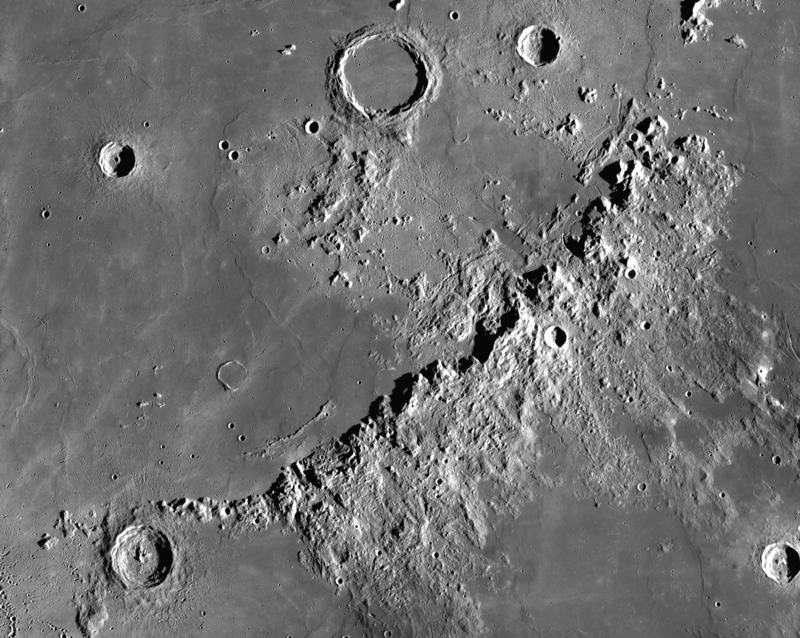
the lunar Apennines:
In the opening chapter of Earthlight (1955) by Arthur C Clarke, the protagonist is travelling by monorail from Sinus Medii to Plato at a time when the long lunar night is approaching. As the car emerges from behind a cliff his eyes are smitten by a sudden view of the mountain range whose summits are lit by the gradually setting Sun.
...There, marching across the sky in flaming glory, were the peaks of the Apennines, incandescent in the last rays of the hidden sun. The abrupt explosion of light left Sadler almost blinded; he shielded his eyes from the glare, and waited until he could safely face it again. When he looked once more the transformation was complete. The stars, which until a moment ago had filled the sky, had vanished. His contracted pupils could no longer see them: even the glowing Earth now seemed no more than a feeble patch of greenish luminosity. The glare from the sunlit mountains... had eclipsed all other sources of light.
The peaks floated in the sky, fantastic pyramids of flame. They seemed to have no more connection with the ground beneath them than do the clouds that gather above a sunset on Earth. The line of shadow was so sharp, the lower slopes of the mountains so lost in utter darkness, that only the burning summits had any real existence...
Archimedes (crater):
See the extract from Ray Cummings' Brigands of the Moon (1930).
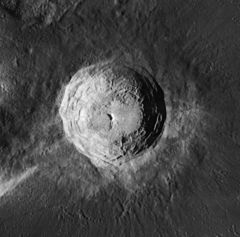
Aristarchus (crater):
This is the most active site on the Moon for observations of TLPs (Transient Lunar Phenomena), and thus a ripe candidate for tales unwritten about native lunar life. In published fiction, we have the following reference (of a different kind) in Imperial Earth (1975) by Arthur C Clarke:
"What about the Bank of Selene? Isn't it supposed to be more adventurous?"
"Don't believe all you've read about the Gnomes of Aristarchus; they're as careful as anyone else. They have to be. Bankers on Earth can still go on breathing if they make a bad investment..."
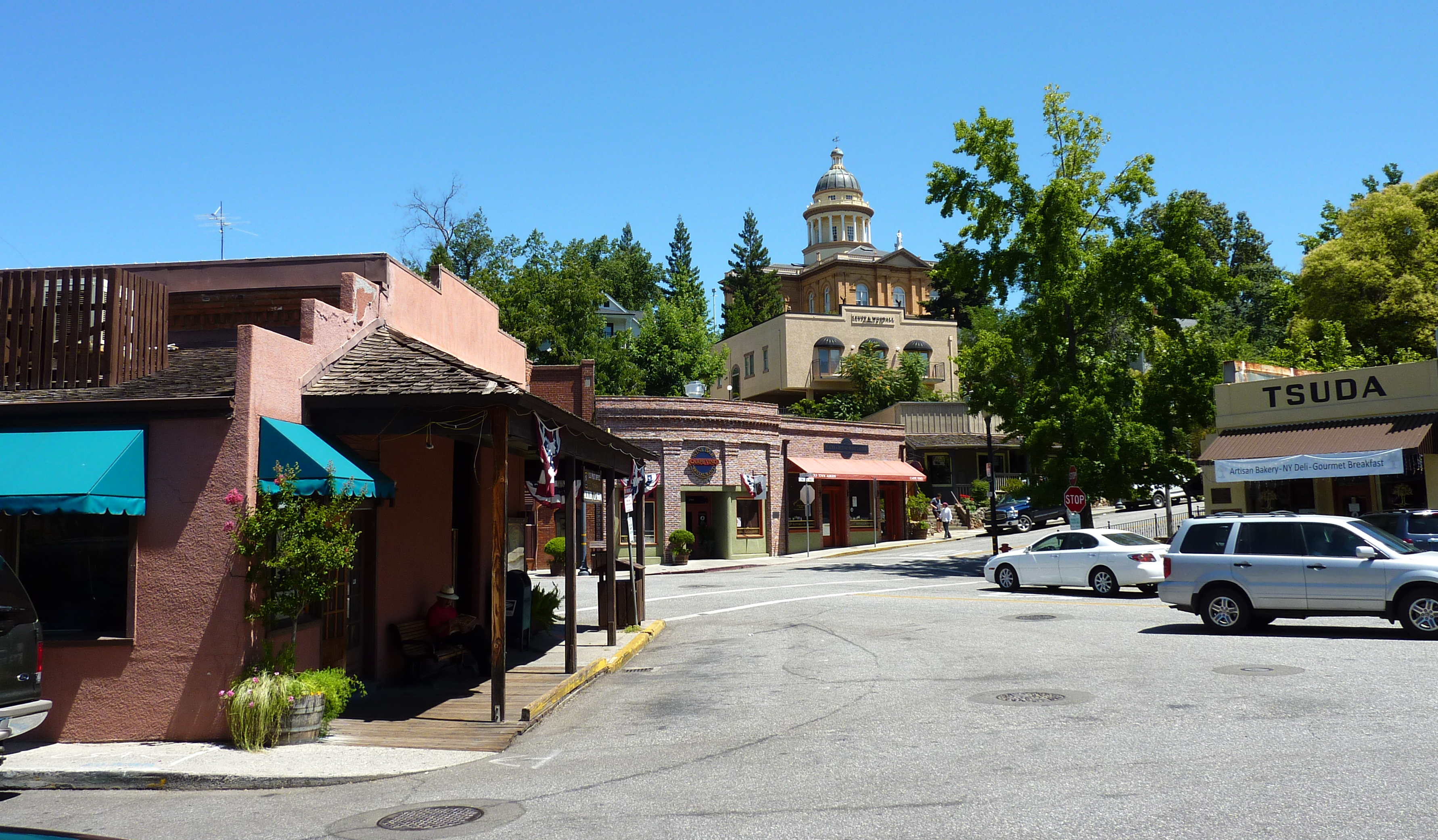
Auburn, California, USA:
This is where Clark Ashton Smith lived most of his life.
The town features in the opening of his story The Root of Ampoi (The Arkham Sampler, Spring 1949; Tales of Science and Sorcery, 1964):
A circus had arrived in Auburn. The siding at the station was crowded with long lines of cars from which issued a medley of exotic howls, growls, snarls and trumpetings...
...And then I saw the giant, who was slightly more than eight feet tall and magnificently built, with no sign of the disproportion which often attends gigantism...
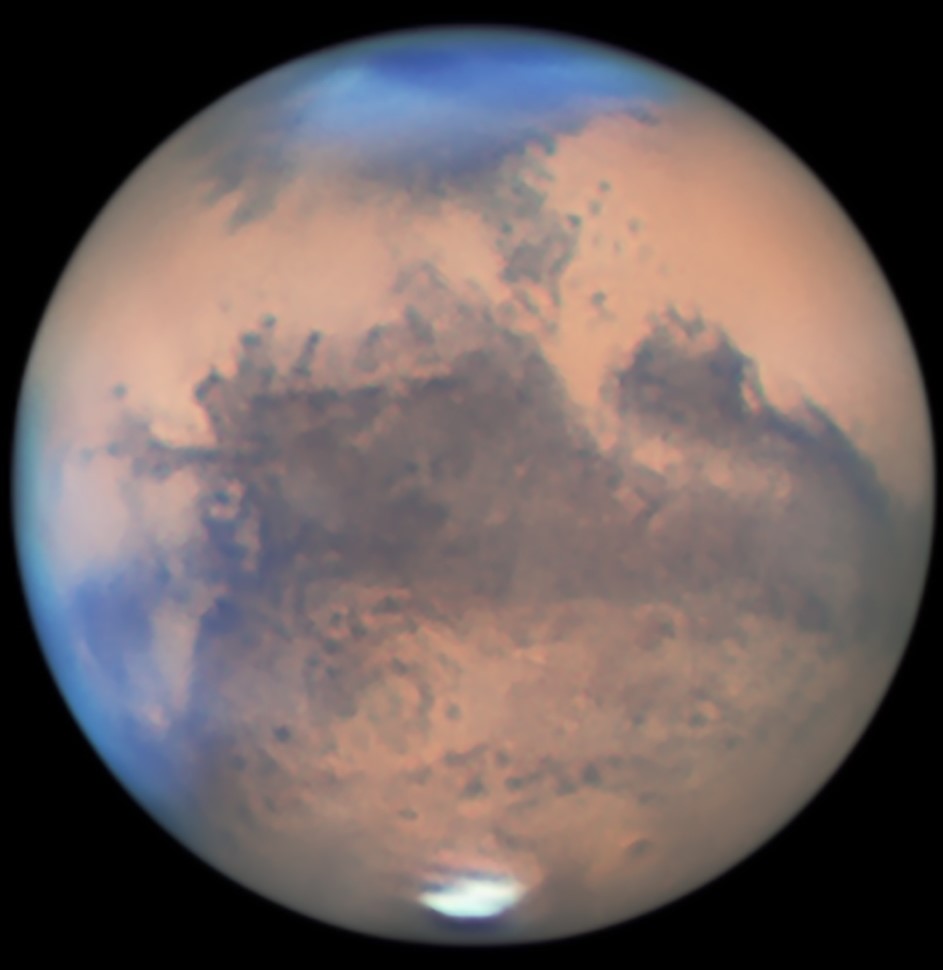 In the middle: Lat. 15 South, Long. 310.
In the middle: Lat. 15 South, Long. 310.Aurorae Sinus:
The site of the larger of the two colonies in Arthur C Clarke's 1951 novel, The Sands of Mars, this is where the protagonist lands on the Red Planet.
Gibson first glimpsed the settlement as a tiny white patch on the horizon, against the dark background of the Aurorae Sinus. The pilot swung the ship round in a great whistling arc to the south, losing altitude and shedding his surplus speed. As the rocket banked, Gibson had a momentary picture of half a dozen large, circular domes, clustered closely together. Then the ground was rushing up to meet him, there was a series of gentle bumps, and the machine rolled slowly to a standstill.
He was on Mars. He had reached what to ancient man had been a moving red light among the stars, what to the men of only a century ago had been a mysterious and utterly unattainable world - and what was now the frontier of the human race.
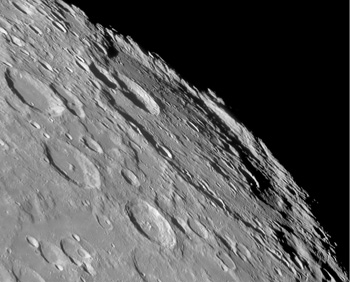
Bailly (crater):
From R W Mackleworth's Starflight 3000 (1972):
"I'm standing on the edge of the Bailly Crater: the southern wall." He pointed to the southeast. "Milcon have their fortress in the Doerful Mountains. In the old days this was called the Third Quadrant. I come from an island called Riphaen in the Mare Nubium."
Hart looked irritated. "These names are known to everyone."
Boldre laughed at him. "But how many know they were given long before this planet was inhabitable? How many know it was barren and airless - a dead world until some genius on Earth bred an organism that could break down rock to form an atmosphere?"
Hart nodded slowly. "That's little enough but sufficient for Milcon."
The threat was clear...
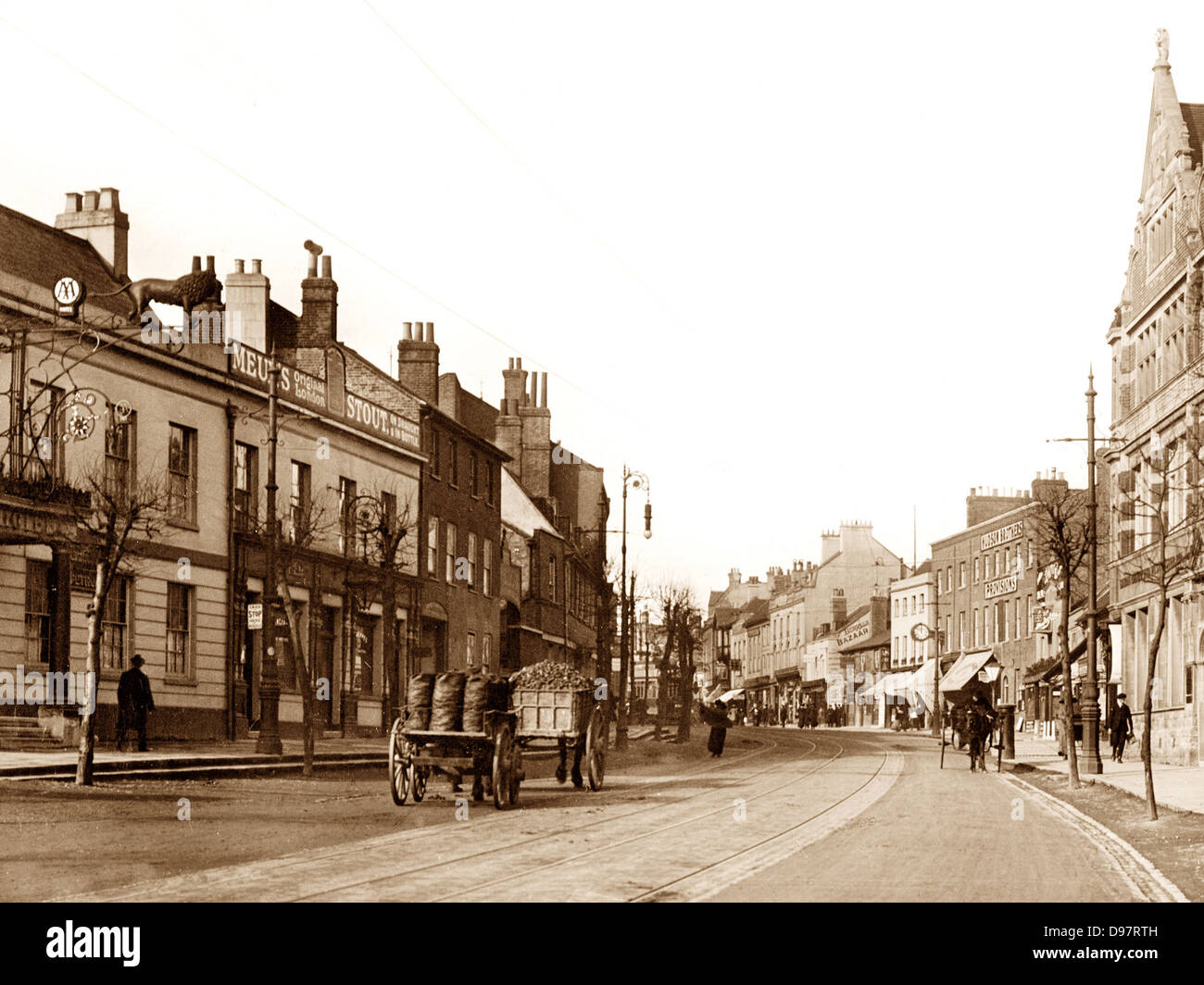 around 1900
around 1900Barnet, Hertfordshire, England:
Fugitives from the invading Martians crowd the area in H G Wells' The War of the Worlds (1898).
...The main road was a boiling stream of people, a torrent of human beings rushing northward, one pressing on another. A great bank of dust, white and luminous in the blaze of the sun, made everything within twenty feet of the ground grey and indistinct, and was perpetually renewed by the hurrying feet of a dense crowd of horses and men and women on foot, and by the wheels of vehicles of every description.
"Way!" my brother heard voices crying. "Make way!"
It was like riding into the smoke of a fire to approach the meeting-point of the lane and road; the crowd roared like a fire, and the dust was hot and pungent. And, indeed, a little way up the road a villa was burning and sending rolling masses of black smoke across the road to add to the confusion...
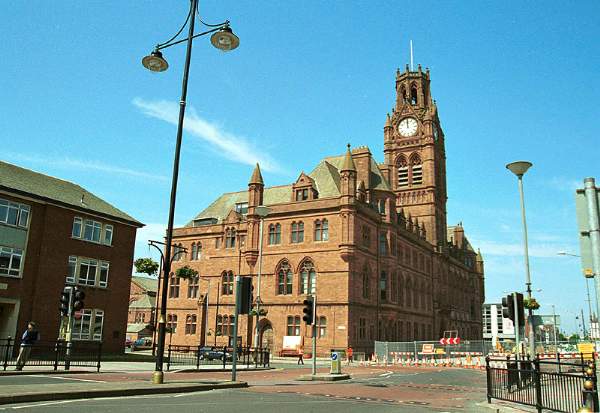
Barrow-in-Furness, Lancashire, England:
The mind of Ray Jerome, in an alien body on Mercury, meeting another transferred Terran, in Bob Shaw's Fire Pattern (1984):
"Name's Joe Thwaite," the stranger said. "Spinster of this parish for the last eleven years, but before that resident in the beautiful township of Barrow-in-Furness."
"Barrow-in-Furness?" Jerome began to feel lost. "Isn't that in England?"
"Certainly is. Best town in the whole ruddy country."
Jerome was still adrift between two worlds. "But you don't have an English accent."
"And you don't have an American one. Not any more." Thwaite produced a gnomish grin. "Accents are mainly a matter of muscle development, and you've got Dorrinian speech centres now..."
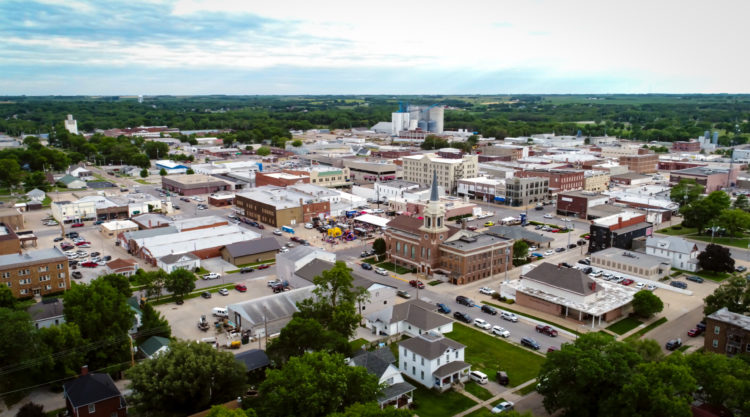
Beatrice, Nebraska, USA:
In Keith Laumer's classic invasion-novel The House in November (1969), the protagonist awakes from a trance to find that all the other inhabitants of his home town are mentally in thrall.
...Gillian shrank away from him as he came down the steps. "Jeff, you look sick. You're having some kind of attack. Lie down, and I'll call Dr. Everet - "
"I've never felt better in my life - " Mallory started and broke off abruptly. Through the window on the landing he saw the familiar street, clear of fog now, the big, old-fashioned houses, steep-gabled, the leafless trees above them. But beyond, where the steeple of the Methodist church should have been, a tower rose up and up into the morning sky. It was big, his engineer's eye told him: hundreds of feet in diameter, and so tall that its flaring top was lost in the high haze. The material was pale green, glassy, translucent. An incredible structure, sprung up overnight like an enchanted mushroom.
"Gill - what is it?"
"The Star Tower, of course." She stared into his face. Her eyes had a glazed, remote look...
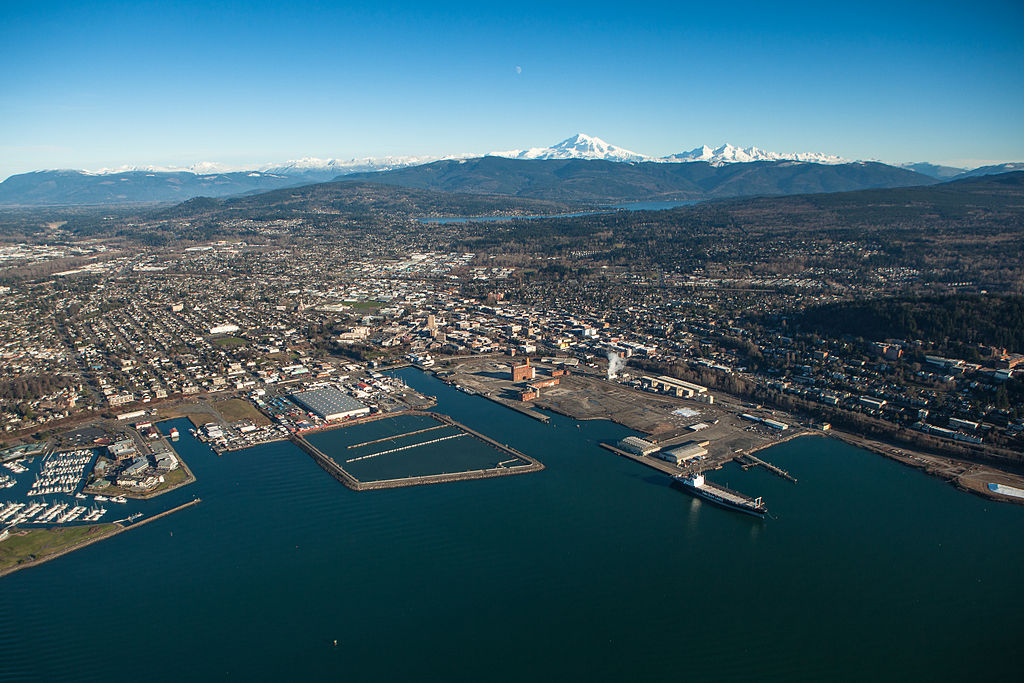
Bellingham, Washington State, USA:
Secret construction site and eventual launch site of the nuclear-bomb-powered spaceship Michael, in Niven and Pournelle's alien-invasion epic Footfall (1985). When the reader is introduced to the area,
...It was a bright clear spring day, with brilliant sunshine, the kind of day that made it worth while living through Bellingham's rainy seasons. The snow-covered peaks of Mount Baker and the Twin Sisters stood magnificently above the foothills to the east. The view was impressive even to a native; it was enough to have Angelenos gawking. They stood near the old Bellingham city hall, a red brick castle complete with towers and Chuckanut granite, and alternately looked out across the bay to the San Juan Islands, then back to the mountains...
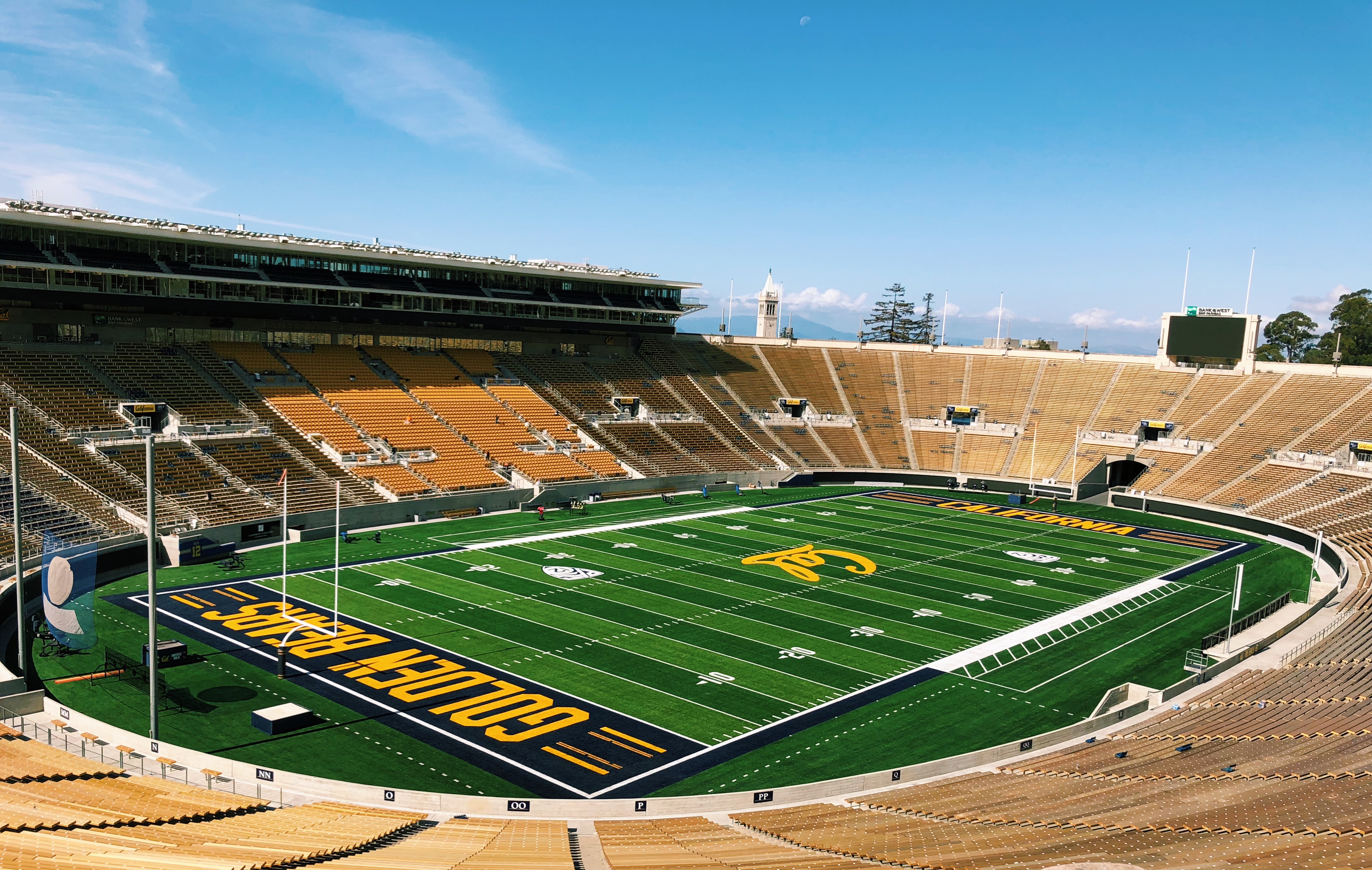 the stadium at Berkeley
the stadium at BerkeleyBerkeley, California, USA:
From Seedling of Mars by Clark Ashton Smith (Wonder Stories Quarterly, Fall 1931, as The Planet Entity):
It was in the fall of 1947, three days prior to the annual football game between Stanford and the University of California, that the strange visitor from outer space landed in the middle of the huge stadium at Berkeley where the game was to be held.
Descending with peculiar deliberation, it was seen and pointed out by multitudes of people in the towns that border on San Francisco Bay...
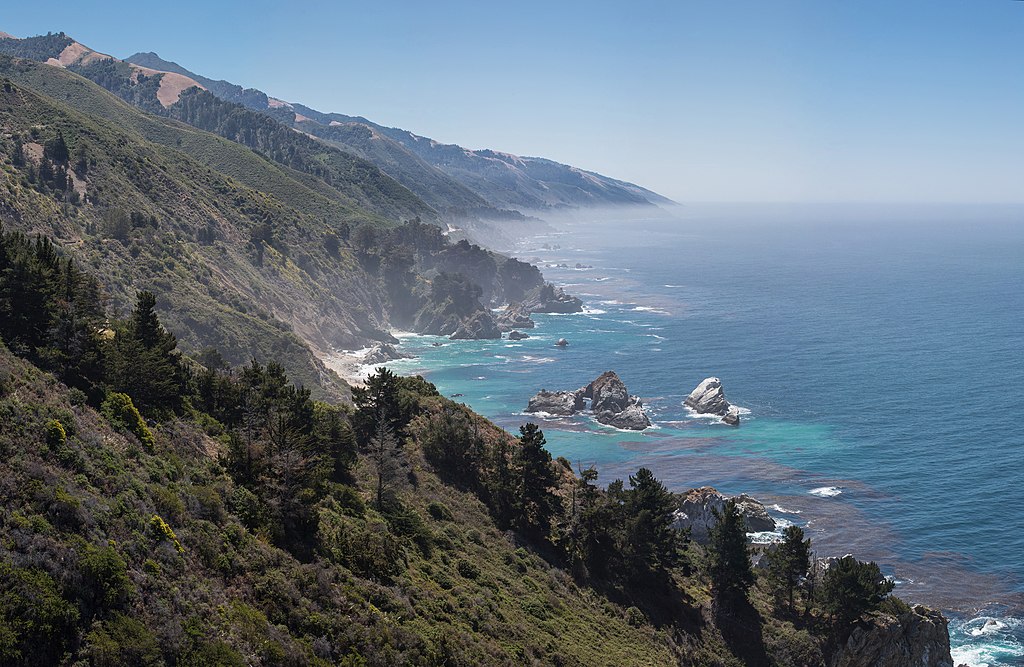
Big Sur, California, USA:
On the run from the State, from the mob and from a lab-grown monster, Travis Cornell and the genetically-engineered genius-dog "Einstein" hide out in sparsely populated countryside, at the start of part two of Watchers (1987) by Dean R Koontz.
...Travis and Einstein went for a walk across the grassy hills and through the woods behind the house they had bought in the beautiful California coastal region called Big Sur.
On the treeless hills, the autumn sun warmed the stones and cast scattered cloud shadows. The breeze off the Pacific drew a whisper from the dry golden grass. In the sun, the air was mild, neither hot nor cool. Travis was comfortable in jeans and a long-sleeved shirt.
He carried a Mossberg short-barreled pistol-grip pump-action 12-gauge shotgun. He always carried it on his walks. If he ever encountered someone who asked about it, he intended to tell them he was hunting rattlesnakes...
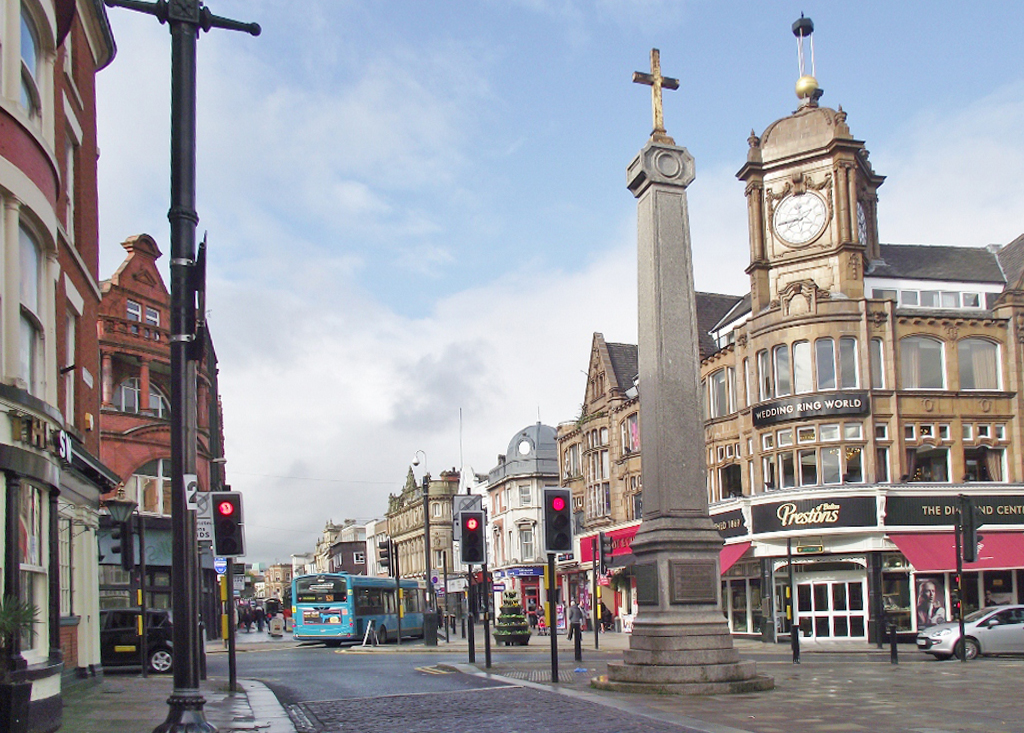
Bolton, Lancashire, England:
Mathematician Lucas Hutchman, on the run, looking for a place to hide, decides against the Lake District:
...It would be better to lose himself in a population centre and - if he did not want to arrive conspicuously in the dead of night - to pick one fairly near at hand. He pulled off the highway and consulted a road map.
The nearest town of any size was Bolton which, to Hutchman's mind, was the epitome of the traditionally humdrum life of provincial England...
- from Bob Shaw's The Peace Machine (1971, 1985).
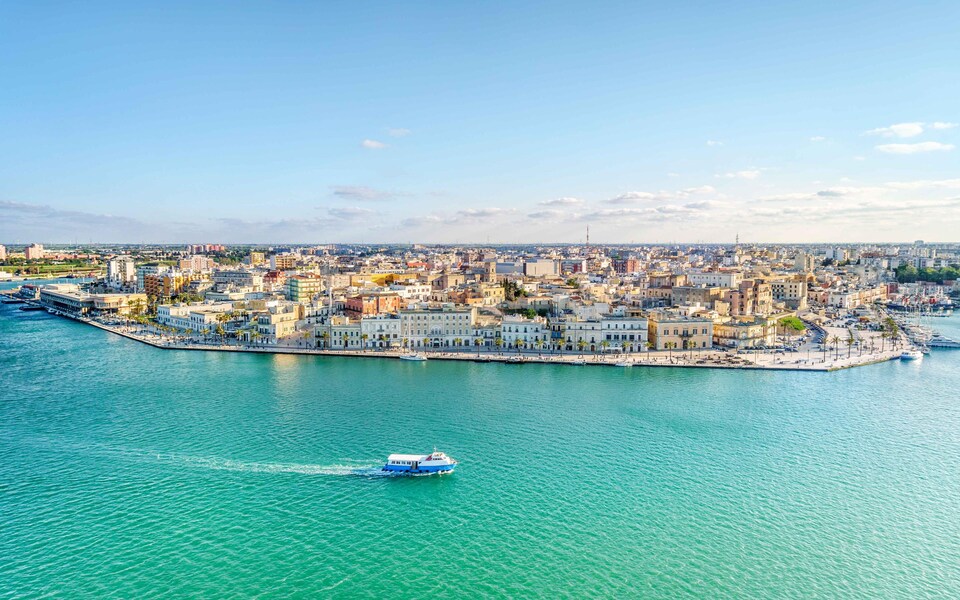
Brindisi, Apulia, Italy:
Chapter 1 of the final novel in the Starwolf trilogy, World of the Starwolves (1968) by Edmond Hamilton, shows us the old star-captain John Dilullo in what he thinks is retirement.
...He sat on the browned, sun-warmed grass on the side of the low hill, hunched with his knees drawn up, looking in his gray coverall like an old rock set in the slope. And Dilullo's face had something rock-like in it too, a roughly carved face of harsh planes, his hair graying at the edges.
He looked down at the streets and buildings of Brindisi, at the cape and the mole and the little islands, with beyond them the blue Adriatic shimmering in the hot Italian sun. He knew the old city very well, but it had changed since he had hurried through it as a boy on his way to school.
Working and studying, to get to be a starman, he thought. And what did the stars give me when I got to them? Danger and worry and sweat, and when I went out to them once too often I came back to find that everybody and everything I had was gone...
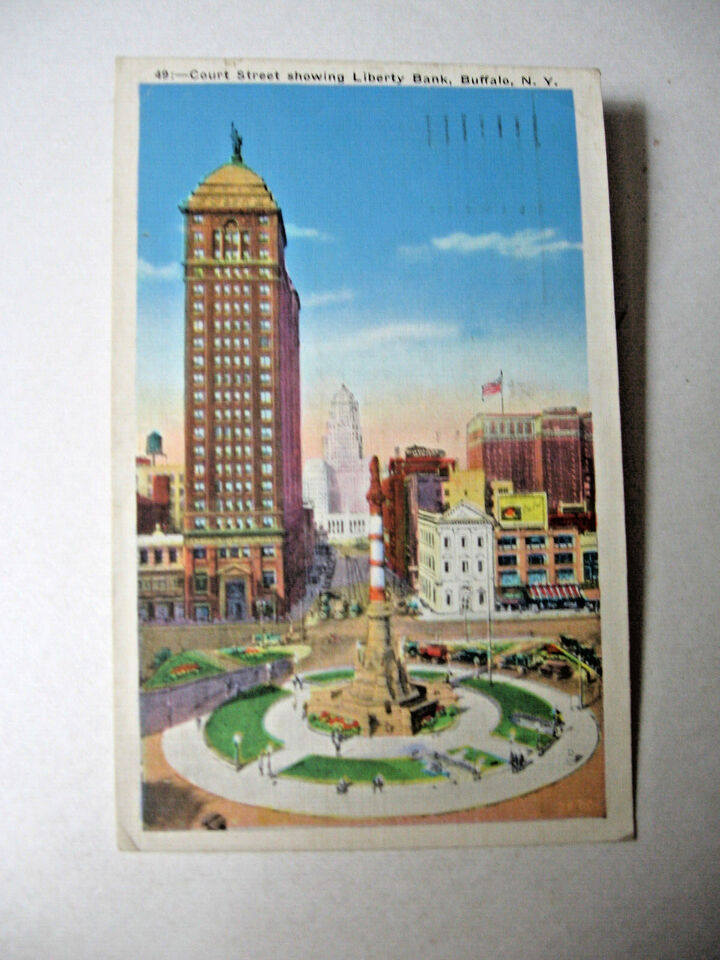 1936 postcard
1936 postcardBuffalo, New York, USA:
At the start of the rather mind-boggling novel Dinosaur Beach (1971) by Keith Laumer, "Time-sweeper" agent Ravel is living happily in this city in 1936, when he starts to remember who he really is and that he must leave on a mission to save reality.
It was a pleasant summer evening. We were sitting on the porch swing, Lisa and I, watching the last of the pink fade out of the sky and listening to Fred Hunnicut pushing a lawn mower over his weed crop next door. A cricket in the woodwork started up his fiddle, sounding businesslike and full of energy. A car rattled by, its weak yellow headlights pushing shadows along the brick street and reflecting in the foliage of the sycamores that arched over the pavement. Somewhere a radio sang about harbor lights.
A pleasant evening, a pleasant place. I hated to leave it...
Bullialdus:
For a reference in William F Temple's Shoot at the Moon (1966) see Mare Nubium.
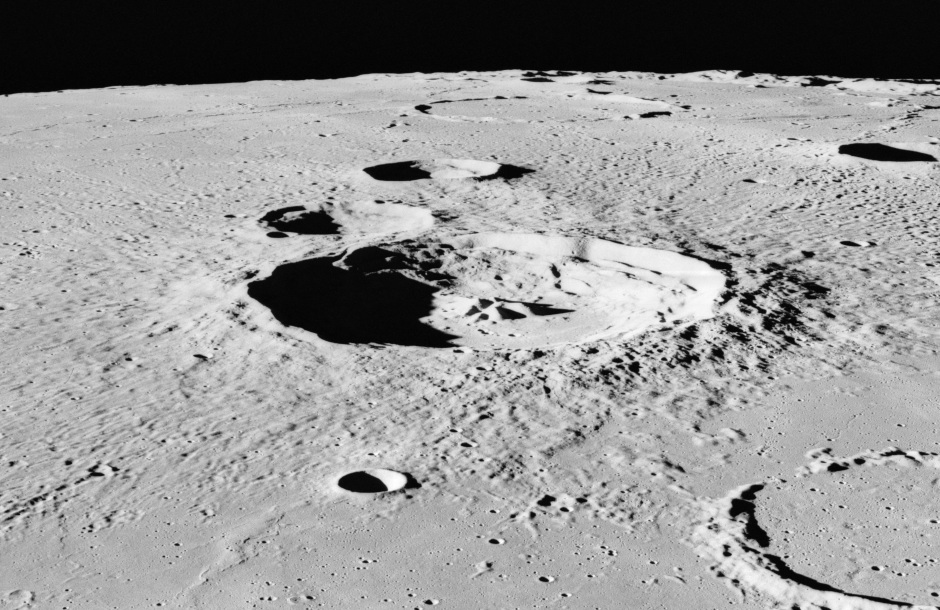 Bullialdus from Apollo 16
Bullialdus from Apollo 16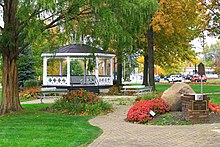
Canfield, Ohio, USA:
Leigh Brackett's post-disaster novel The Long Tomorrow (1955) opens at Canfield (or what's left of it - cities now being forbidden):
Len Colter sat in the shade under the wall of the horse barn, eating pone and sweep butter and contemplating a sin. He was fourteen years old, and he had lived all of the m on the farm at Piper's Run, where opportunities for real sinning were comfortably few. But now Piper's Run was more than thirty miles away, and he was having a look at the world, bright with distractions and gaudy with possibilities. He was at the Canfield Fair...
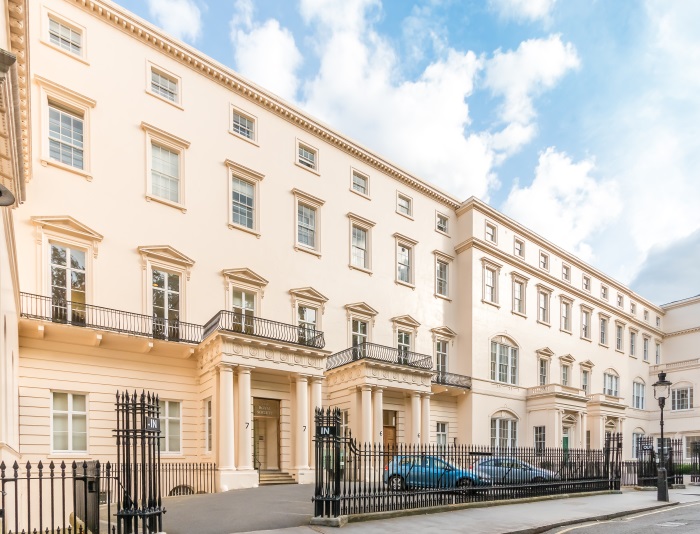 the Royal Society
the Royal SocietyCarlton House Terrace, London, England:
In the opening chapter of Fred and Geoffrey Hoyle's cosmic disaster novel Inferno (1973), in which (spoiler alert) the galactic centre becomes a quasar and the radiation fries most of the Earth's mid-latitudes, the Scottish hero is about to be given the job in Australia which leads to the terrible discovery.
...dinner over, he set off walking again, out along Shaftesbury Avenue, Piccadilly Circus, Lower Regent Street, into Carlton House Terrace. At No.6 he pressed the 'night porter' button, announced himself into a small microphone and opened the door as soon as the electrically operated lock came free.
He slept like a log in the countryside, especially out of doors, but sleep never came easily in big cities and he wondered how he would fare tonight. The Royal Society, here in Carlton House Terrace, was commendably far from the heavy traffic. Even so he could hear a general outside hum...
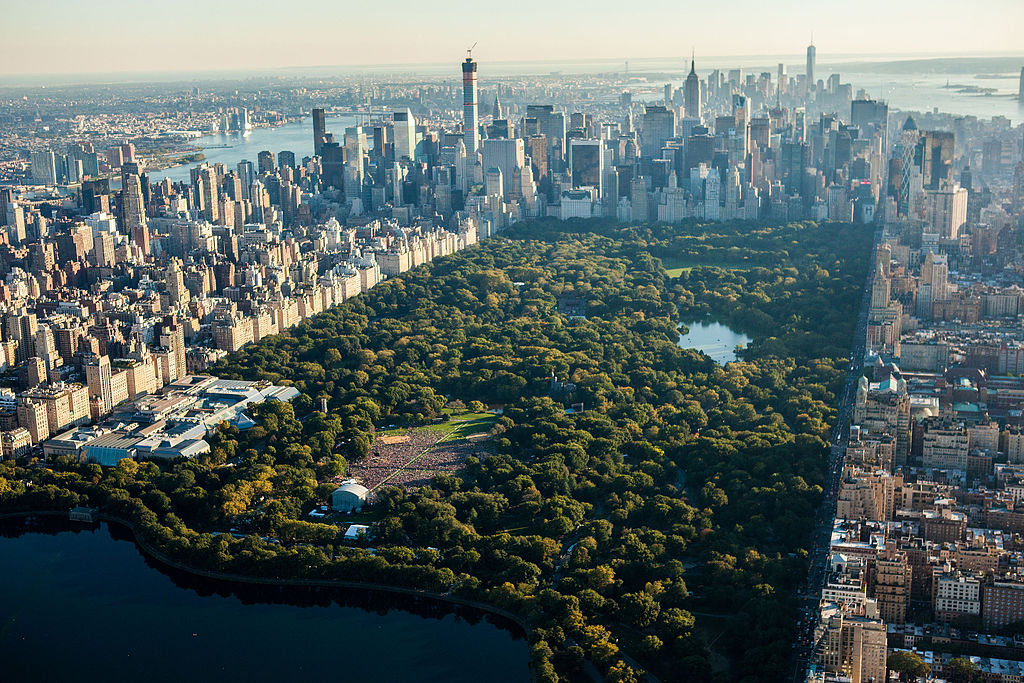
Central Park, New York City, USA:
After a global pandemic has wiped out most of humanity, Isherwood Williams wanders across the USA looking for other survivors, in George R Stewart's Earth Abides (1949). The passages in italics are reflections either by the protagonist (who is a geographer) or by the author.
An island within an island, the green oblong of the Park will remain. It has open soil where the rain penetrates. The sun shines upon it. In the first season the grass grows tall; the seeds fall from the trees and buses, the birds bring in more seeds. Give it two seasons, three seasons, and the eager saplings are sprouting. Give it twenty years, and it is a jungle of second growth with each tree straining upward to gain light above its fellows, and the hardy natives, fast-growing ash and maple, crowding out the soft exotics which man once planted there. You hardly see the bridle path any more; leaf-litter lies thick on the narrow roads. Give it a hundred years, and you walk in full-grown forest, scarcely knowing that man was ever there except where the stone arch still spans the under-pass, making a strange cave. The doe walks in the woods, and the wild-cat leaps upon the rabbit, and the bass jumps in the lake...
[see also Manhattan]
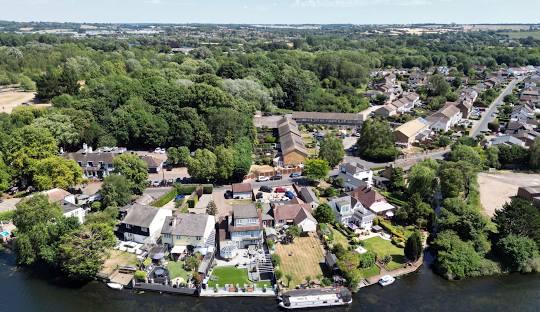
Cheshunt, Hertfordshire, England:
The narrator of John Wyndham's alien-contact novel Chocky (1968), David Gore, is a man with few close relatives, who marries one Mary Bosworth, from a family so numerous that "...I had a feeling of being engulfed". He moves with his new wife after their honeymoon to
...a small house in Cheshunt - a strategic position for easy contact with most elements of the Bosworth ganglion...
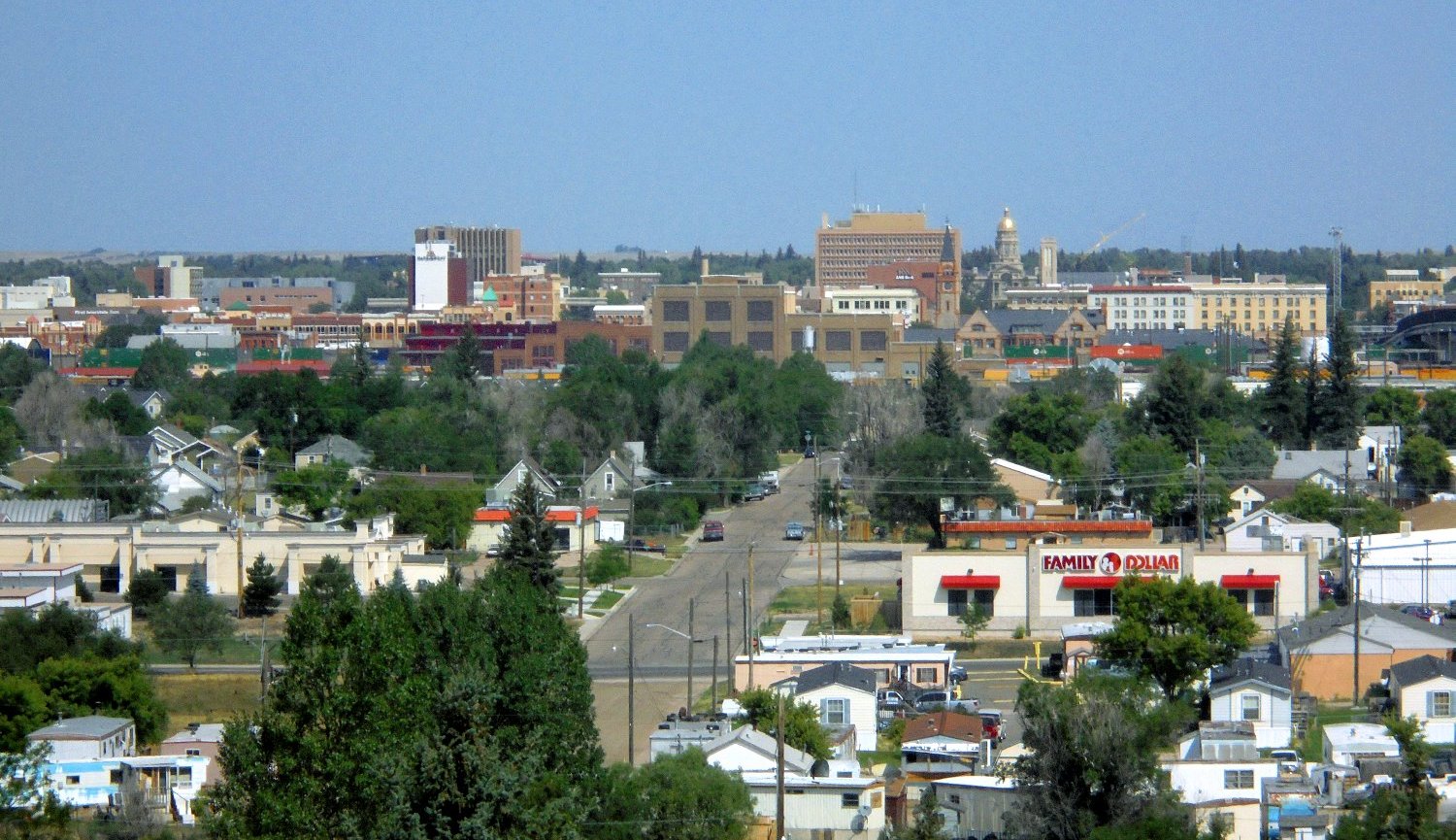
Cheyenne, Wyoming, USA:
Currently a state capital, this city will undergo a further rise in status in the future described by Philip K Dick's Now Wait For Last Year (1966), in which Earth, in the year 2055, is at war with an arthropodal species from the Proxima Centauri system:
...On Terra at the UN capital city, Cheyenne, Wyoming, in addition to those in POW camps, there existed a herd of captured, defanged reegs, maintained on public exhibition by the Terran military establishment. Citizens could file past and gawk and ponder at length the meaning of these exoskeletoned beings with six extremities in all, capable of progressingly linearly at a great rate on either two or four legs. The reegs had no audible vocal apparatus; they communicated beewise by elaborate, dancelike weavings of their sensory stalks...
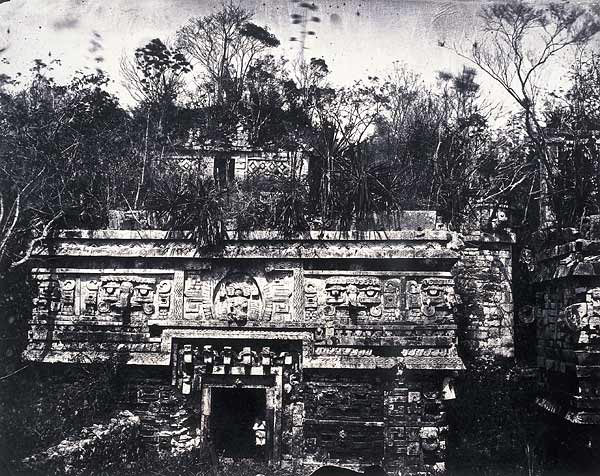
Chichen Itza, Yucatan, Mexico:
The mystery of this Mayan site is woven into the Lovecraft-inspired novel The Philosopher's Stone (1969) by Colin Wilson.
...no power of adaptation. They stayed in their cities until the land that fed them was exhausted: then there was no alternative to a mass migration.
This was not the whole explanation. There was something more sinister here. Why was the social structure so rigid? Why was the priesthood so dominant? Behind Maya civilization lay the conception of the Great Secret, a mystery symbolized by the enormous heads of serpents in their temples. The priests held a secret that was so terrifying that the world might be destroyed if it was ever revealed. It was the priests who had ordered the mass migration. And they believed they were under orders from Someone Else...
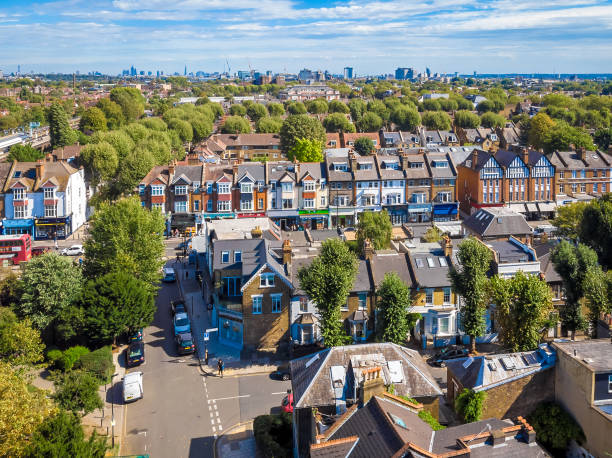
Chiswick, Hounslow, London, England:
In John Christopher's climate-change novel The World In Winter (1962)
an African nation, intending to lay claim to frozen Britain, sends an expedition which explores the Thames area.
...They found human life again at Chiswick. At first there were odd figures on the banks of the frozen river, some retreating, as the Hovercraft approached, into the hinterland of buildings, others - bolder or more curious - staring and gesticulating...
...By Chiswick Bridge the activity was greater and more purposive. A mob that had gathered on the left bank spilled out on to the bridge itself... They shook their fists and howled inaudible curses. Some stooped down and rummaged in the snow, looking for stones which they threw at the Hovercraft.
Abonitu said, smiling: "The natives seem unfriendly..."
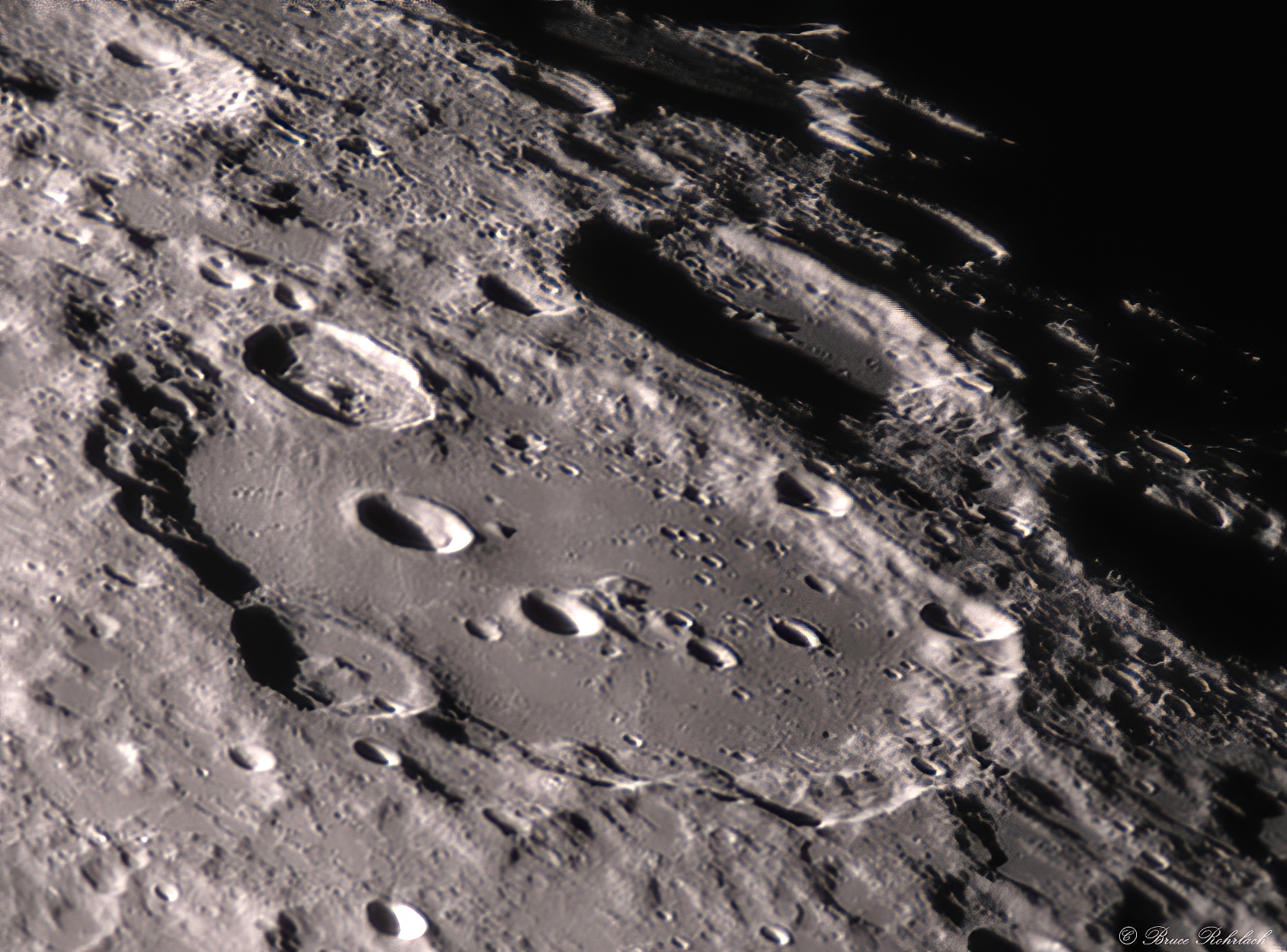
Clavius (crater):
Location of the hiding-place chosen for a scientific discovery in The Key (Fantasy and Science Fiction, October 1966) by Isaac Asimov.
Urth said solemnly, "I would suggest you search the shaded rim of Clavius, at that point where the Earth is nearest the zenith..."
The crater provides an important location in Clarke's 2001: A Space Odyssey (1968):
Clavius, a hundred-and-fifty miles in diameter, is the second largest crater on the visible face of the Moon, and lies in the centre of the Southern Highlands. It is very old; ages of vulcanism and bombardment from space have scarred its walls and pock-marked its floor. But since the last era of crater-formation, when the debris from the asteroid belt was still battering the inner planets, it had known peace for half a billion years.
Now there were new, strange stirrings on and below its surface, for here Man was establishing his first permanent bridgehead on the Moon. Clavius Base could, in an emergency, be entirely self-supporting...
A different slant on the area's administrative side is given by the same author in his shipping-disaster novel A Fall of Moondust (1961). Chapter 7 begins:
In Clavius City, Chief Administrator Olsen and Tourist Commissioner Davis had just finished conferring with the Legal Department. It had not been a cheerful occasion; much of the time had been discussing the waivers of responsibility which the missing tourists had signed before they boarded Selene...
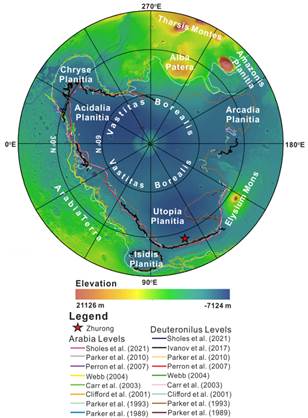 Copais Palus is at 54 degrees 40 minutes North, 80 degrees zero minutes East.
Copais Palus is at 54 degrees 40 minutes North, 80 degrees zero minutes East.Copais:
Harl Vincent in Lost City of Mars (Astounding Stories, February 1934) refers to a city Copais, whereas on old maps of Mars it was a lake (Copais Lacus) and nowadays it is a "swamp" (Copais Palus):
SPRINGING up, as if in actual miniature
reproduction, was one of the canal cities of Mars. There was a section of
dryland territory on the one side of moonlit Canal Pyramus, the spires and
minarets and glistening nickel-cobalt roadways of the city on the other. Lights
of many ronsals, the vehicles whose elongated bodies were supported
a few feet above the roads by the energies with which they were charged, could
be discerned plainly. The traffic was that of mid-evening, proceeding at a
leisurely pace.
“It’s Copais!” breathed Coler. “Right!” said Kal.
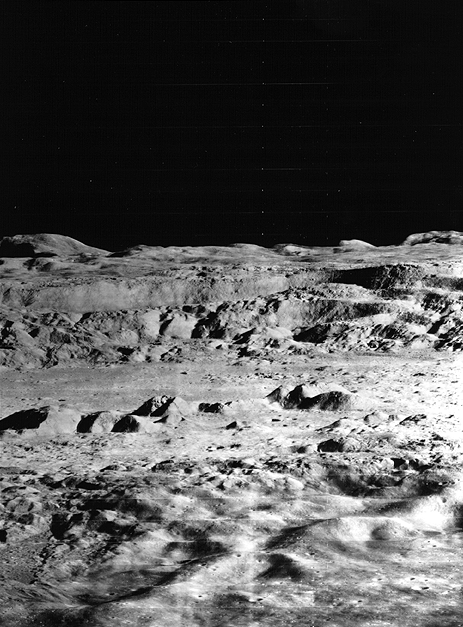 Copernicus from Lunar Orbiter 2
Copernicus from Lunar Orbiter 2Copernicus:
For a reference in William F Temple's Shoot at the Moon (1966) see Mare Nubium.
In James P Hogan's Inherit the Stars (1977), a fifty-thousand-year-old humanoid corpse is discovered in a cave near the base named "Copernicus Three".
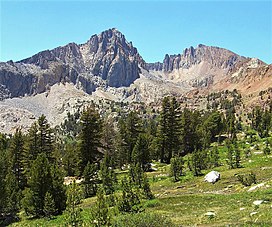
Crater Mountain, California, USA:
I am assuming that "Crater Ridge" is a ridge on Crater Mountain. The location, specified as "among the Sierras", seems to fit the reference in Clark Ashton Smith's The City of the Singing Flame (1931).
I had gone for a walk on Crater Ridge, which lies a mile or less to the north of my cabin near Summit. Though differing markedly in its character from the usual landscapes round about, it is one of my favorite places. It is exceptionally bare and desolate, with little more in the way of vegetation than mountain sunflowers, wild currant-bushes, and a few study, wind-warped pines and supple tamaracks.
Geologists deny it a volcanic origin; yet its outcroppings of rough nodular stone and enormous rubble-heaps have all the air of scoriac remains - at least, to my non-scientific eye. They look like the slag and refuse of Cyclopean furnaces, poured out in pre-human years, to cool and harden into shapes of limitless grotesquerie...
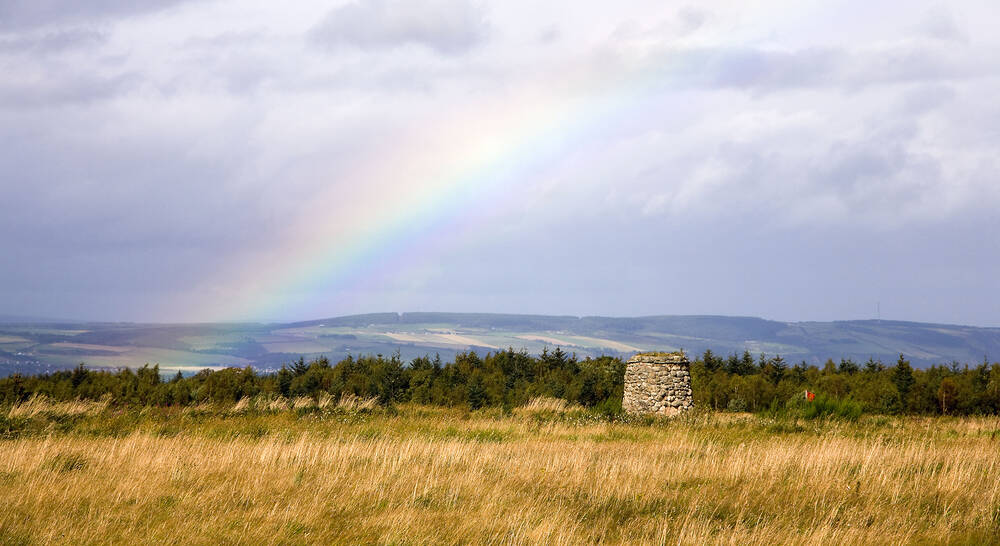
Culloden Moor, Inverness-shire, Scotland:
After a lapse of years the Highlander physicist-hero of Inferno
(1973), a cosmic-disaster novel by Fred and Geoffrey Hoyle, pays his
third visit to the historic site - shortly before the unexpected
calamity which renders most of Earth uninhabitable - and is appalled by
what he sees.
...It came as an intense shock to find the battlefield grown over by
woodland. Cameron parked the car some two hundred yards back from the
memorial cairn. Leaving Madeleine there he walked to the clan graves.
At least the graves had been left in open ground. He stood for a
while. Then walking away to the trees a black fury seized him. This
was the final indignity. Not content with cruelty and persecution. Not
content with stealing the land, not content with evictions, not content
with an endless draining of vigour from the Highlands, they must even
obliterate the very ground on which men had fought and died.
Obliterated by mean trees, not even dignified trees of good quality.
Obliterated by the very poorest quality trees. What was it but part of a
determined degradation of the old culture by these unremitting
creatures to the south?
"May the wrath of God strike you some time," Cameron muttered....
(In this book, italics mean that the words are spoken in Gaelic.)
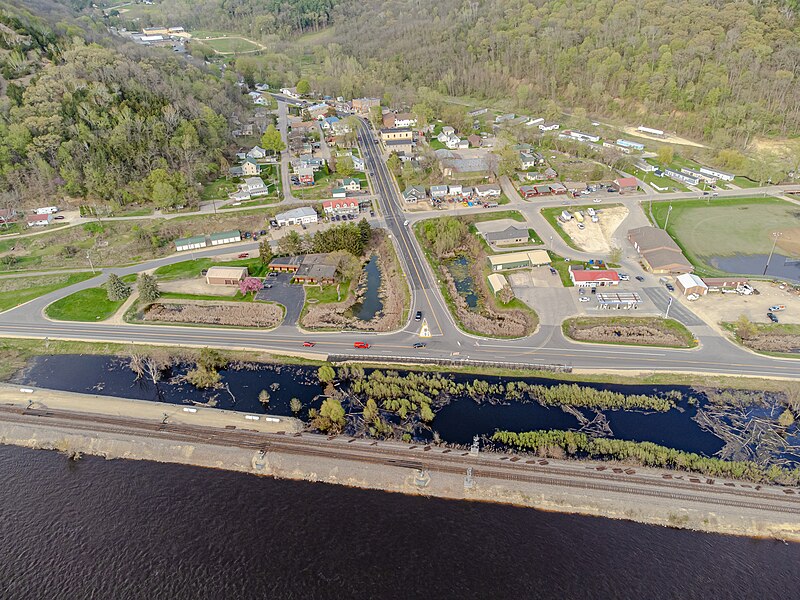
De Soto, Wisconsin, USA:
The place is featured in Clifford Simak's The Visitors (1979), chapter 53, by which stage in the story people are rushing to help themselves to free gifts (such as cars) grown by the alien visitors, plant-based organisms with fantastic powers of replication.
The South Dakotan who had nursed his dilapidated car for more than five hundred miles, the machine rattling and banging, coughing and gasping, every wheeze threatening to be its last, pulled into the small town of De Soto, a wide place in the road hemmed in between bluff and river. He tried to find a place to park, but there was no place left in the town to park. The one long street was jammed with cars and people, and there seemed to be much angry shouting and running about, and the frightening, sobering thought crossed his mind that possibly all the people here had also come for cars...
Damascus, Syria:
Dazed by the horror of the news of an unexplained nuclear attack on this city, mathematician Lucas Hutchman decides upon his dangerous anti-weapons gamble in Bob Shaw's The Peace Machine (1971, 1985).
"Vicky," he said, almost guiltily. "Something has happened. I just heard a news flash on the television. They say Damascus has been wiped out by a hydrogen bomb."
"How awful." Vicky turned, her hands full of diced cheese, and nodded towards a glass-fronted cupboard. "How ghastly. Be a darling and reach me down the small casserole..."
Death Valley, California, USA:
In D F Jones' Colossus (1966), Death Valley is the site of a nuclear explosion perpetrated by the despotic supercomputer as a punishment for disobedience.
Blake's head lolled to one side, yet in his eyes Forbin saw intelligence struggling with unspeakable horror and fear. He swallowed, gasped for air.
"The missile team - Death Valley - missile, missile exploded in its silo - I don't know, know any..."
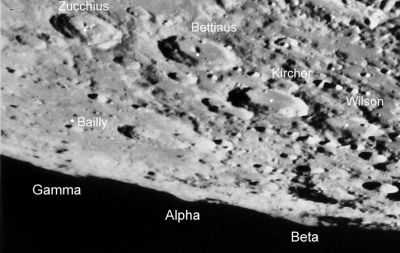
the Doerfel Mountains (=Montes Doerfel):
From R W Mackleworth's Starflight 3000 (1972), in which the Moon has acquired a proto-atmosphere:
Lower on the slope he spotted a movement.
He edged away to the southeast, into the foothills of the Doerfuls. It was not the right direction but it skirted the dangers of the crater and its red mist. He had no wish to die before his time...
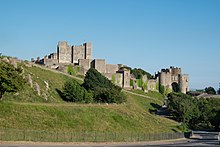 not cardboard, but admittedly smooth as if just cut out
not cardboard, but admittedly smooth as if just cut outDover, Kent, England:
Bond concentrated on his driving as he coasted down into Dover. He kept left and was soon climbing out of the town again past the wonderful cardboard castle.
There was a patch of low cloud on top of the hill and a spit of rain on his windshield. There was a cold breeze coming in from the sea...
- Ian Fleming, Moonraker (1955)
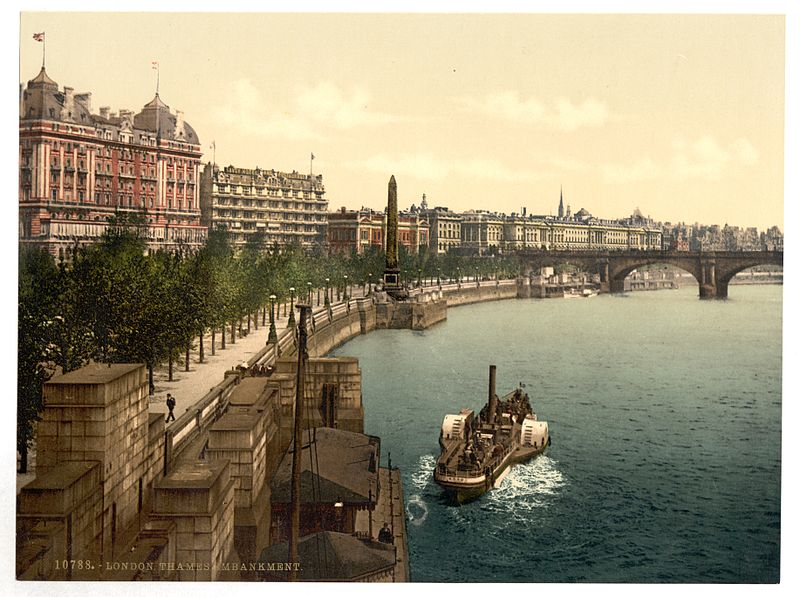 the Thames Embankment on an 1890s postcard
the Thames Embankment on an 1890s postcardthe Embankment, London, England:
In the first of Sir Arthur Conan Doyle's adventures starring the egomaniacal Professor Challenger, The Lost World (1912), Challenger and his rival, Professor Summerlee, spend much time feuding with each other. The narrator recounts:
...Last night Challenger said that he never cared to walk on the Thames Embankment and look up the river, as it was always sad to see one's own eventual goal. He is convinced, of course, that he is destined for Westminster Abbey. Summerlee retorted, however, with a sour smile, by saying that he understood that Millbank Prison had been pulled down. Challenger's conceit is too colossal to allow him to be really annoyed. He only smiled in his beard and repeated "Really ! really !" in the pitying tone one would use to a child....
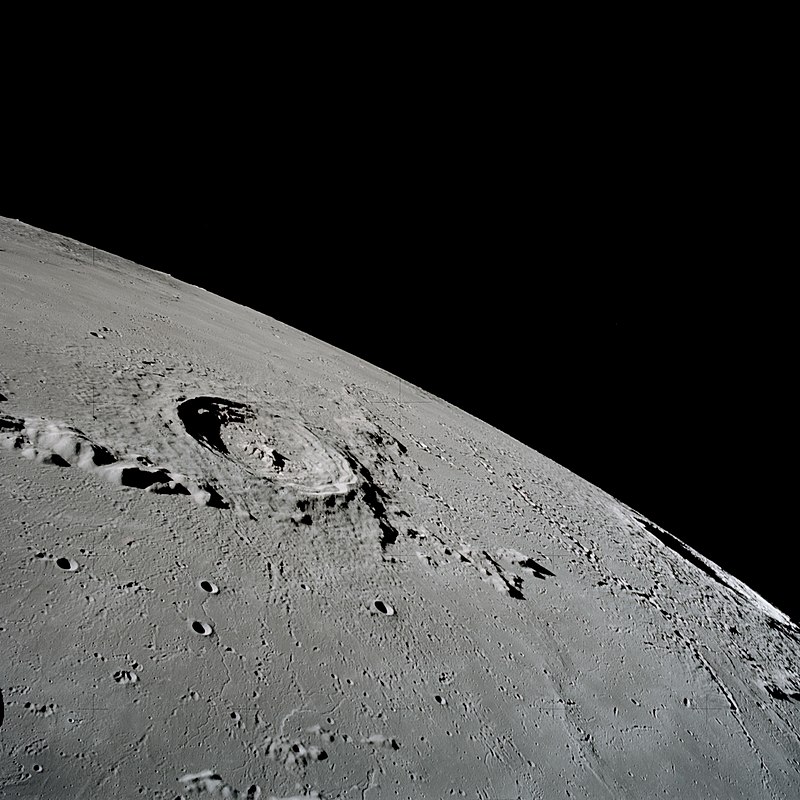 from Apollo 17
from Apollo 17Eratosthenes:
As well as the fictional, this site is intended to cover the non-fictional Old Solar System, which is to say the old ideas of what was really there; yet compared with the coverage of the fictional, I've hardly dealt directly with the non-fictional at all. Of course by implication, as story-writers have been inspired by what is now out-of-date science, I have explored that science to a fair degree; but not explicitly enough for my liking. Still, here's an exception, regarding the 35-mile-wide crater Eratosthenes.
From Wikipedia:
From 1910 to the 1920s, William H. Pickering
noted dark patches in the crater that varied in a regular manner over
each lunar day. He first put forward the speculative idea that these
patches appeared to migrate across the surface, suggestive of
vegetation. Pickering believed that the Moon had a thicker atmosphere
and reported seeing climatic variations such as frost and snow, leading
him to refer to the crater as the "Gardens of Eratosthenes". Later his views would change, and he would come to believe that the vegetation was instead "swarms of animal life",
which he often referred to as swarms of insects, or "lunar insects".
The scientific community did not share his enthusiasm for these ideas, but they received a degree of attention in the popular press of the time primarily due to Pickering's reputation.
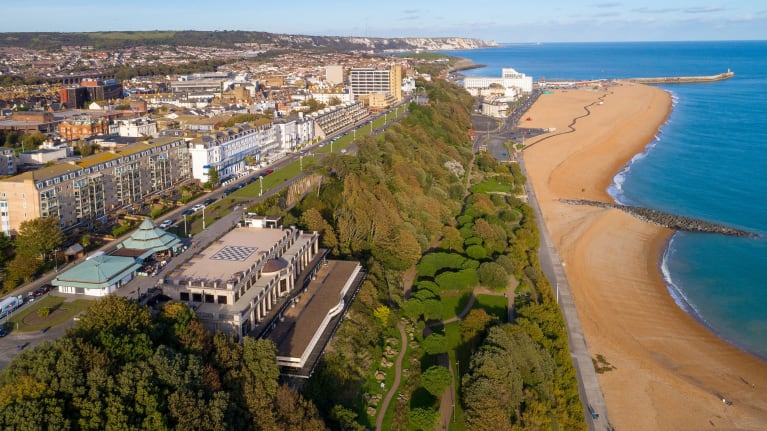 the Leas
the LeasFolkestone, Kent, England:
The cliff-top promenade known as the Leas is a scene made memorable by H G Wells in The New Accelerator (Strand Magazine, December 1901).
...I was proud to observe that I did not feel frightened - I suppose because there were two of us. "Why shoulnd't we go out?" I asked.
"Why not?"
"They'll see us."
"Not they. Goodness, no! Why, we shall be going a thousand times faster than the quickest conjuring trick that was ever done..."
Assuredly of all the strange experiences that I have ever had, or imagined, or read of other people having or imagining, that little raid I made with Gibberne on the Folkestone Leas, under the influence of the New Accelerator, was the strangest and maddest of all. We went out by his gate into the road, and there we made a minute examination of the statuesque passing traffic...
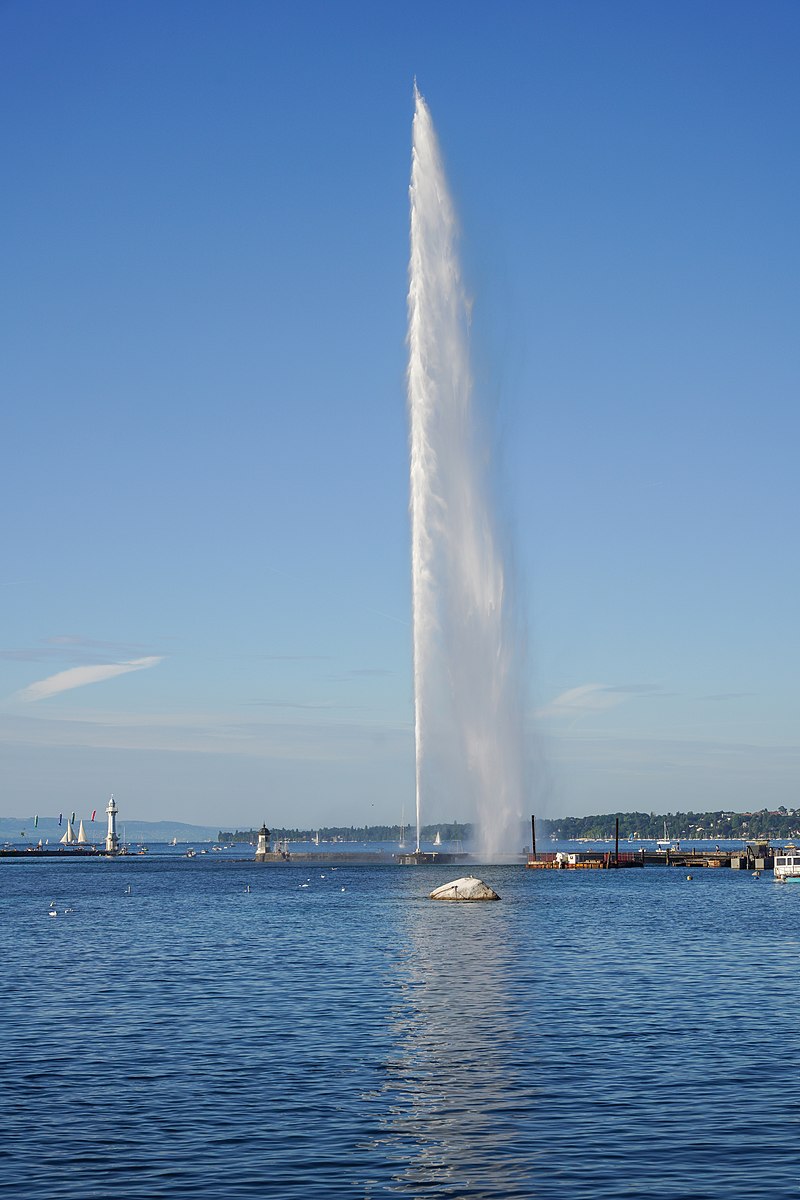
Geneva, Switzerland:
The column of the Jet d'Eau still rose like a pearl-grey, feathery giant over the lake; the mountains stood sentinel in their uncompromising purity and the Old Town was still preserved on the hillside like a museum piece - but otherwise Geneva had become a vast city of sky-scrapers set in extravagant flower gardens. Yet the city of Calvin was more than ever the centre of European political life and, since the Hyannis Agreement which divided the sessions of the United Nations between New York and Switzerland, the centre of world politics for at least six months in a year. More than a century and a half had passed since the first Red Cross Convention had been signed, attempting to regulate the conduct of war. Much had changed in these years; above all, the Convention had been repeatedly modified. The more recent wars left few survivors; there were not many prisoners and even fewer wounded... The so-called U.N. Balls - a series of dazzling social events - attracted the top thousand of the world every February. Three times a year the Bernadette, Hammerskjold and Roosevelt Memorial Banquets brought the leading politicians, financiers and intellectuals of a hundred countries into the vast armoury of the Tower of Nations; and Amazonian, Texan or Arab millionaires paid fabulous bribes for invitations. Half of Geneva consisted of hotels and apartment houses for the U.N. personnel...
Paul Tabori, The Survivors (1964)
By contrast in City (1952) by Clifford D Simak, Geneva is cut off from the rest of the world by means of a force-field, this isolation being the deliberate act of one man, Jon Webster, who wants to leave the rest of the world free for the successor species, the intelligent Dogs.
When he reached the street, he saw that the sky had changed. A grey, metallic overcast had blotted out the sun and the city lay in twilight, only half relieved by the automatic street lights. A faint breeze wafted at his cheek...
Georgia, USA:
Mal Irish looks towards this state from his wanderings in Florida during the geological upheavals of Catastrophe Planet (1966) by Keith Laumer:
...Off to the north you could see a dull glow in the sky - a reflection from the red-hot lava that was building a new mountain range across Georgia...
(Earlier in the story there is an incident in what's left of the Georgia town of "Greenleaf" - but this seems to be a fictional place; at any rate I haven't found any evidence for it online.)
Gijón, Spain:
This town on the Bay of Biscay is the scene of an alien attack from the Deeps in John Wyndham's The Kraken Wakes (1953):
...It was somewhere about ten-thirty in the evening when the sea-tanks came sliding up from the quietly lapping waters at Gijon, with not a sound to betray them until their metal bellies started to crunch up the stone ramps. The few small boats that were already drawn up there they pushed aside or crushed as they came. It was the cracking of the timbers that brought men out from the waterside posadas to investigate.
They could make out little in the fog. The first sea-tanks must have sent coelenterate bubbles wobbling into the air before the men realized what was happening, for presently all was cries, screams, and confusion...
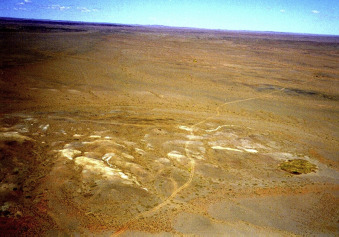
the Gobi Desert:
From Paul Tabori's The Doomsday Brain (1967):
The city which Bruno Gatterer alias Master Brug built under the rocks of the Gobi Desert had a population of seven hundred. But its extent and its production capacity were that of a large metropolis. The answer to this seeming paradox was automation. The seven hundred did little but tend the machines each of which did the work of a thousand or more...
And now he was ready. Ready to crown his life's work, to prove that he was Master Brug, the man whom the machines had made into a god and whose godhead was embodied in machines that were like men and men that had become machines...
From Frederick Pohl's The Merchants' War (1984) which is set in a "sales-fearing" commercial dystopia run by advertising agencies, and in which the "hero", Tenn Tarb, is recruited to extend their sway:
We wound up in the Gobi Desert...
The place is technically known as the Xinjiang Uygur Autonomous Region, but everybody called it the Reservation. It was where one of the last remaining batches of unconsolidated aboriginals lived, Uygurs and Hui and Kazak, the ones that never made the transition to the market society when the rest of China joined it. There's civilization all around them. There's RussCorp to the North, Indiastries South and all the China-Han complex at their gates. But the Eager Weegers just sit there and do their own thing...
Goose Island, Iowa, USA:
I haven't been able to find a picture of it but according to my online search it does really exist, not just in Clifford Simak's The Visitors (1979, 1980):
"Visitors? Visitors? Oh, yes, now I know. I've heard the name. You mean those big black boxes folks say came out of the sky."
"That's what I mean," said Jerry. "You sound as if you saw one."
"Over on Goose Island," said Quinn. "That's the big island, plumb in the centre of the river valley, four or five miles downstream from here... Just saw the tops of them, sticking out above the trees. It was getting on towards evening and I didn't linger none..."
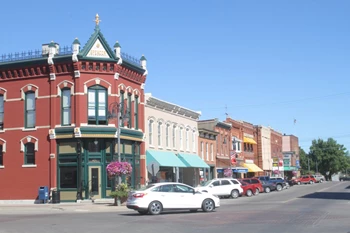
Grinnell, Iowa, USA:
Area of the first landing site of the parasitic invasion of 2007, in Heinlein's The Puppet Masters (1951).
'Seventeen hours' - the Old Man glanced at his finger watch and added - 'and twenty-three minutes ago an unidentified space ship landed near Grinnell, Iowa. Type, unknown. Approximately disk shaped and about hone hundred and fifty feet across. Origin, unknown, but - '
'Didn't they track a trajectory on it?' I interrupted.
'They did not,' he answered. 'Here is a photo of it taken after landing by Space Station Beta.'
I looked it over and passed it to Mary. It was as unsatisfactory as a telephoto taken from five thousand miles out usually is. Trees looking like moss... a cloud shadow that loused up the best part of the pic... and a grey circle that might have been a disk-shaped ship and could just as well have been an oil tank or a water reservoir...
Mary handed the pic back. I said, 'Looks like a tent for a camp meeting. What else do we know?'
'Nothing.'
'Nothing? After seventeen hours! We ought to have agents pouring out of their ears!'
'We did have. Two within reach and four that were sent in. They failed to report back...'
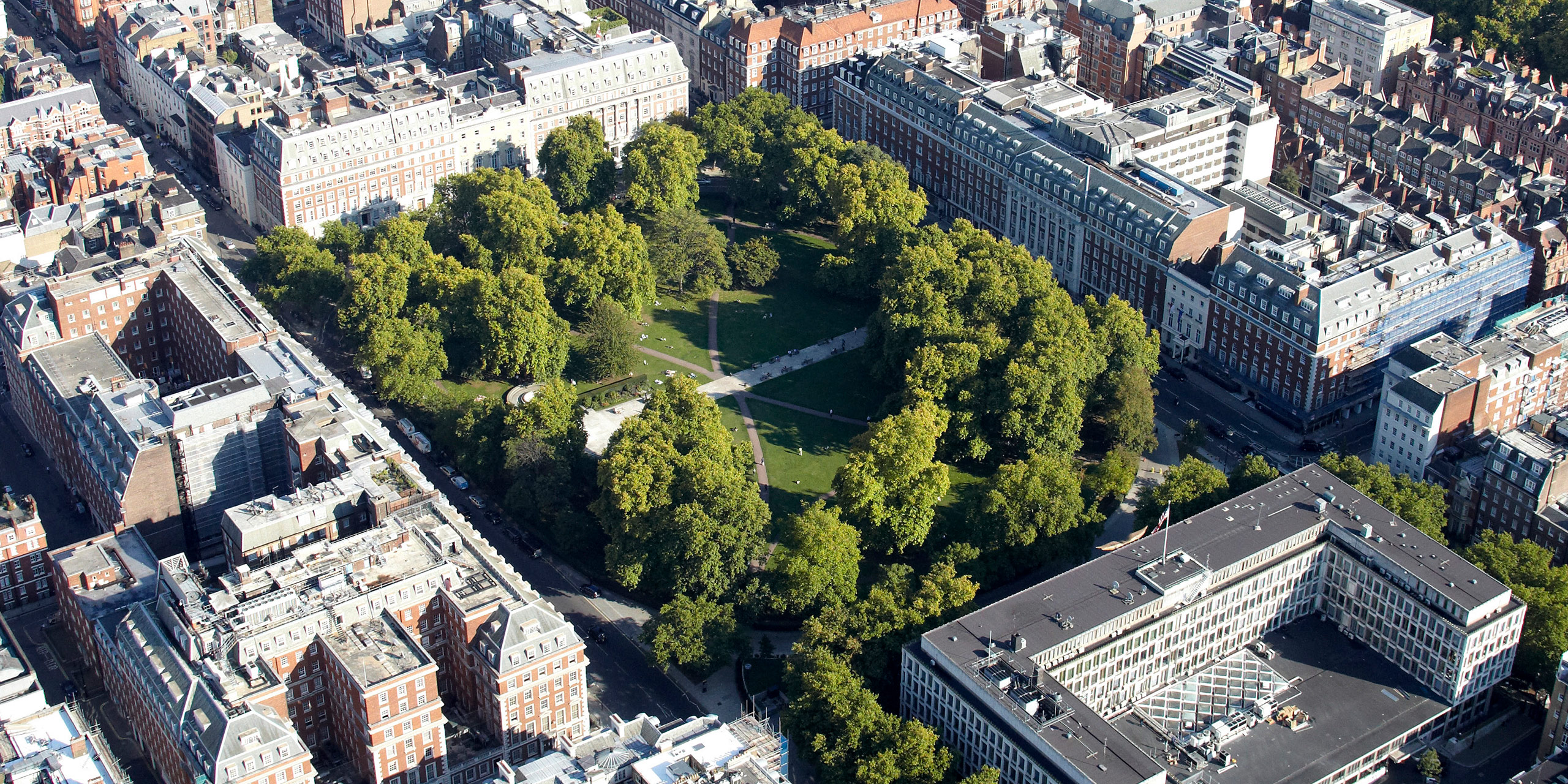
Grosvenor Square, London, England:
In the second volume of Dan Morgan's tetralogy about a community of telepaths, working-class journalist Jerry Coleman has an appointment with his formidably posh mother-in-law:
The Chalfont Hotel was located in a backwater off Grosvenor Square, a bastion of privilege in this age of the common man. As such it was quite obviously home ground for Alison Humphreys. Jerry Coleman wished he had insisted that they meet somewhere on his choosing, but the invitation had come as a surprise; apart from that, with Alison Humphreys he was infufficiently sure of himself to insist on anything.
As the double glass doors of the lounge swung shut behind him with a contemptuous hiss he squared his shoulders beneath the rumpled brown corduroy jacket and tried to rid himself of the feeling that he was an illegal immigrant travelling on a false passport...
The Several Minds (1969)
Gruithuisen's Lunar City, Mare Insularum:
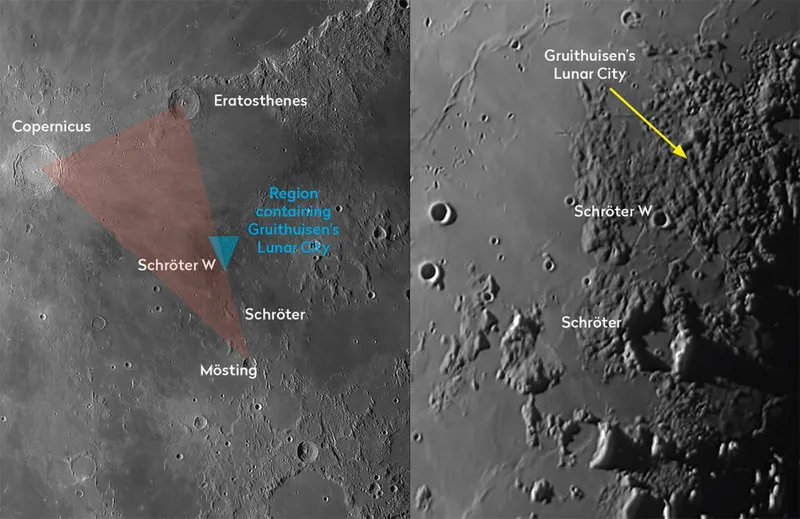 with acknowledgement to the BBC Sky At Night magazine
with acknowledgement to the BBC Sky At Night magazineIn the 1820s the Bavarian astronomer Franz von Paula Gruithuisen (1774-1852) reported having observed a city on the Moon in the region of Schröter. See this article.
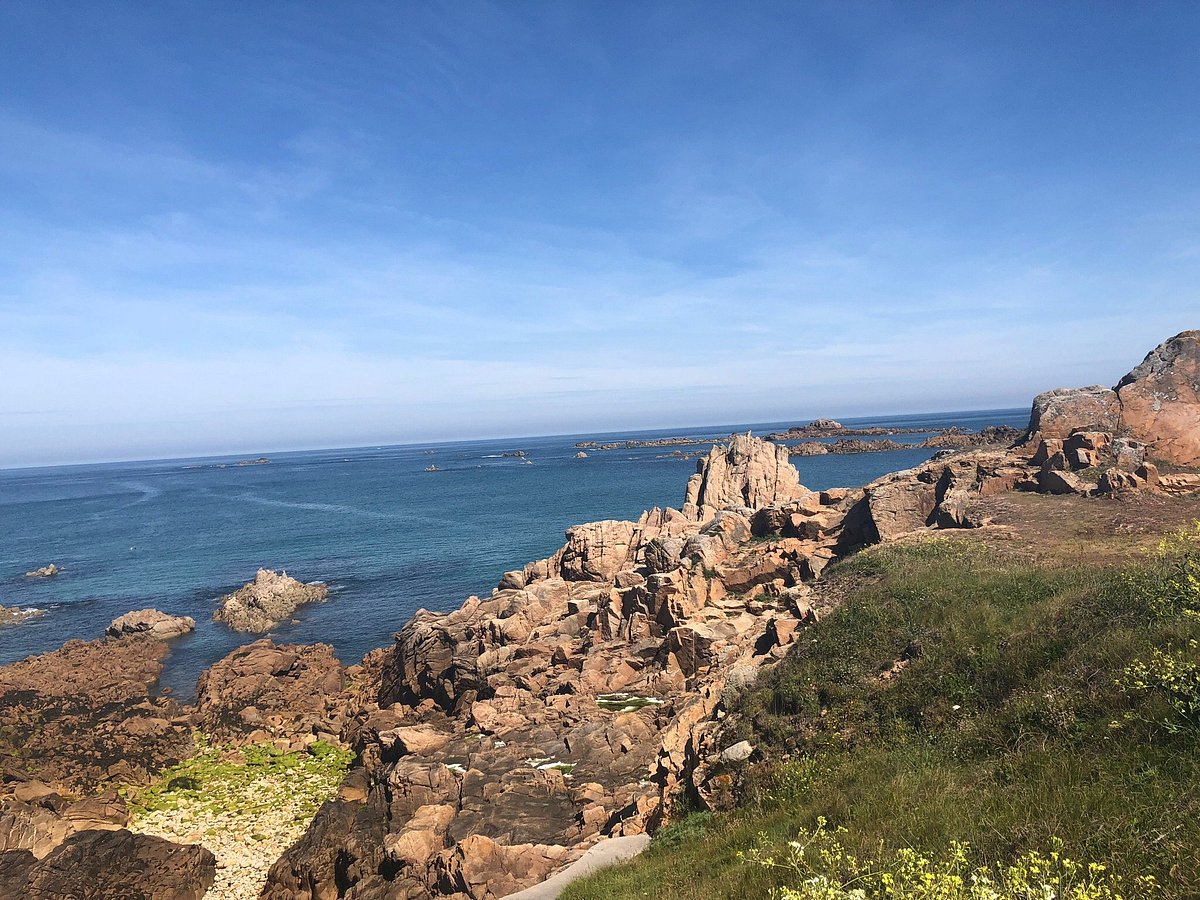 Vazon Bay
Vazon BayGuernsey, Channel Islands:
From Hugh Walters' The Blue Aura (1979), in which there is an extraterrestrial visitation in the caverns dug by the occupying Germans in World War Two:
...The setting sun glinted on the sea and threw shadows of the tumbled heaps of rock across the sands. They followed the coastal road north, skirting Rocquaine Bay and noticing Lihou Island just off the coast. Then they turned north-east past stretches of glorious sand round Vazon Bay.
It was a beautiful island, marred only by the occasional fort or gun emplacement - relics of the German Occupation during the Second World War. Most of them had been left as a constant reminder of those dark days, and had now become a tourist attraction...
Matthew Cotter, survivor of the catastrophic global quake in John Christopher's A Wrinkle in the Skin (1965), is a resident of Guernsey who is shocked to discover that it is a island no more:
He stared in disbelief as he came down the last stretched of hill, steeper now, and looked out to where the sea should have been. It was like a glimpse of another planet, a strange savage and barren world. He could see the tangled green of the great weed beds, the rawness of exposed rock and sand. Here and there the glint of water; light thrown back from pools trapped in hollows. But the blue sweep of wave was gone. A sunken land was drying in the early summer sun.
Heraclides Promontory: see Sinus Iridum.
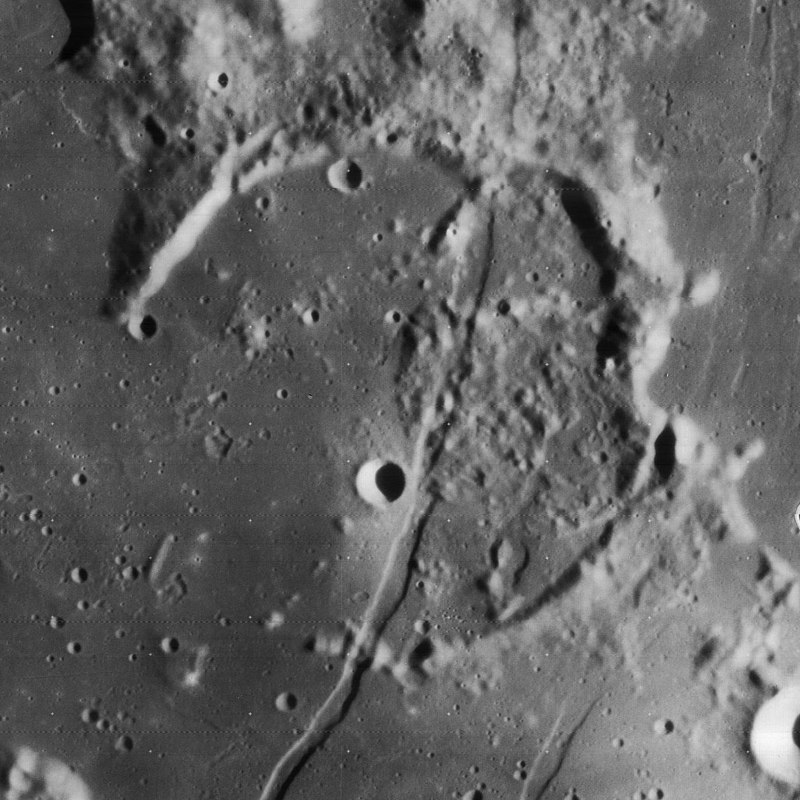
Hippalus (crater), Mare Humorum:
From R W Mackleworth's novel Starflight 3000, the first part of which is set on the Moon in a future when it has been given the chance to develop an atmosphere, hydrosphere and the beginnings of a biosphere:
He noted the clouds and the light and pressed on faster. In the late afternoon of a long day such storms were not uncommon, as the Earth exerted its pull with a special vengeance on the infant atmosphere.
To his left he saw the shadowy heights guarding the crater Hippalus. The crater opened onto the Mare Humorum like a tilted cup. When the water began to respond to the Earth's pull, the cup would be full of torment; the sea would leap in fury, tearing into the rock walls, leaving the sea bed bare in places for a second or so.
Suddenly he doubted if he dare take to the water before nightfall. At night the seas might calm down between tides but he would have to sail blind, unless the Earthshine broke through the cloud...
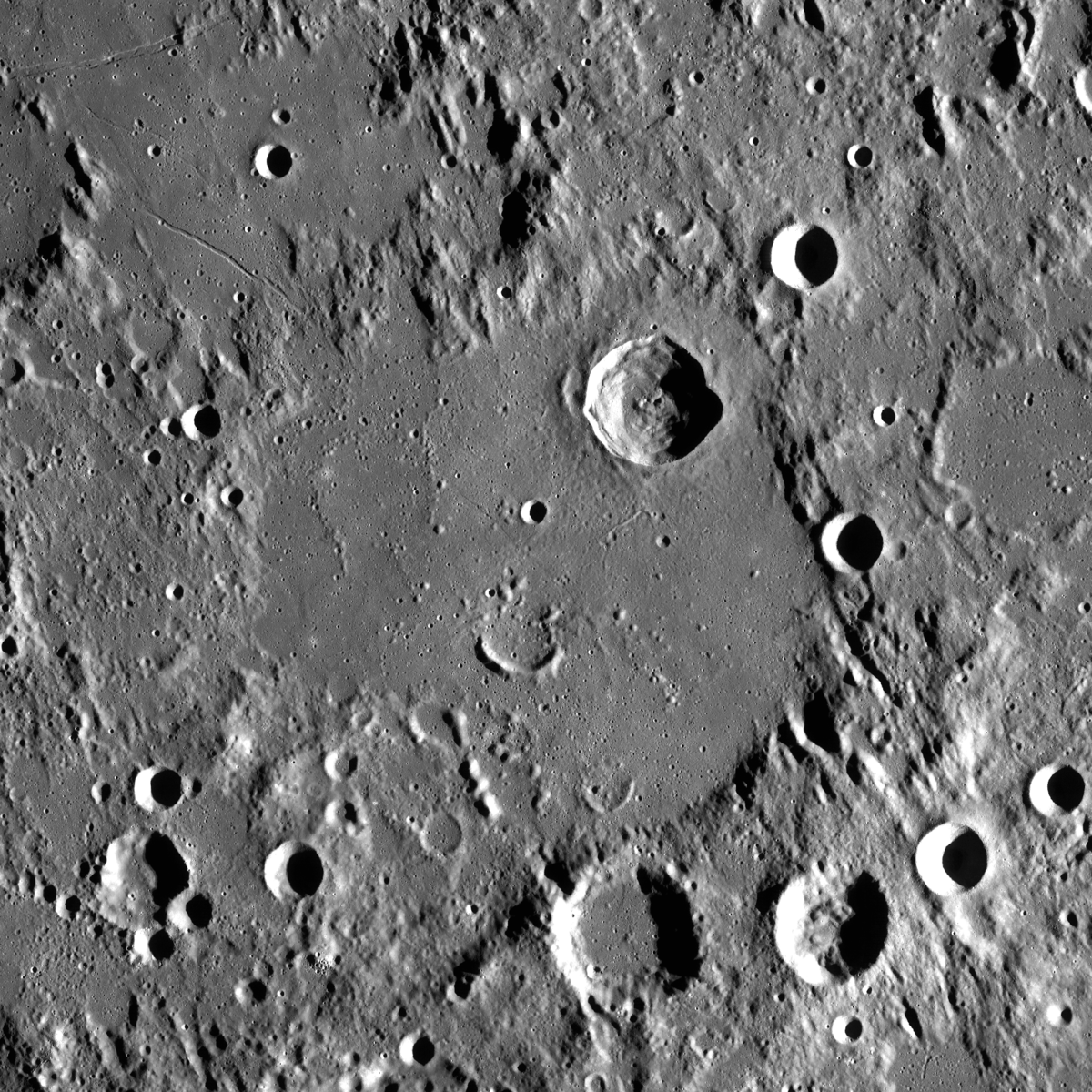 the large, degraded crater
the large, degraded crater
Hipparchus (crater):
From Earthlight by Arthur C Clarke:
...
The meal was tasty but unidentifiable. Like all food on the Moon, it
would have been grown in the great hydroponic farms that sprawled their
square kilometers of pressurized greenhouses along the equator. The meat course was presumably synthetic: it might have been beef, but
Sadler happened to know that the only cow on the Moon lived in luxury at
the Hipparchus Zoo. This was the sort of useless information his
diabolically retentive mind was always picking up and refusing to
disgorge.
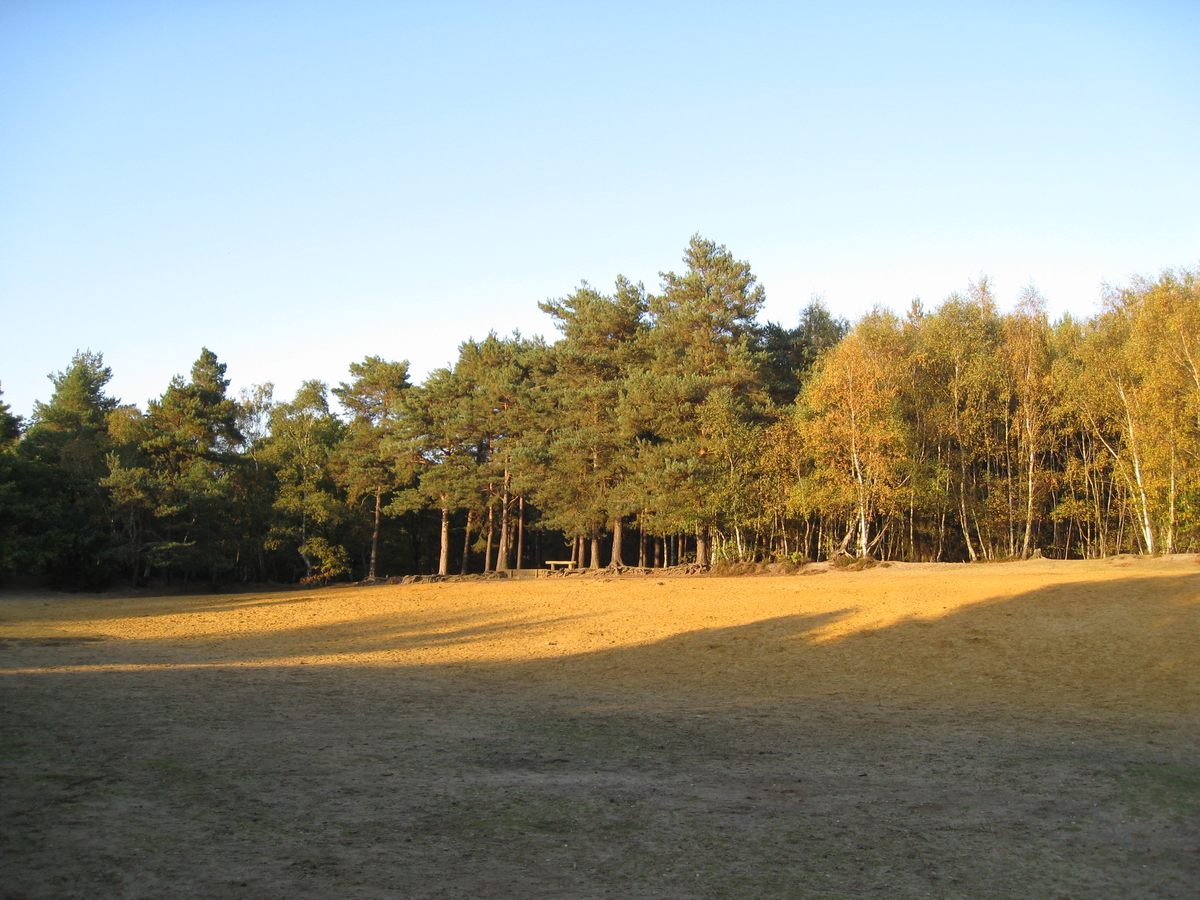 the Horsell Common sandpit
the Horsell Common sandpitHorsell Common, near Woking, Surrey, England:
Impact site of the first cylinder from Mars in the invasion described by H G Wells in The War of the Worlds (1898).
The tops of the pine-trees and the roofs of Horsell came out sharp and black against the western after-glow. The Martians and their appliances were altogether invisible, save for that thin mast upon which their restless mirror wobbled...
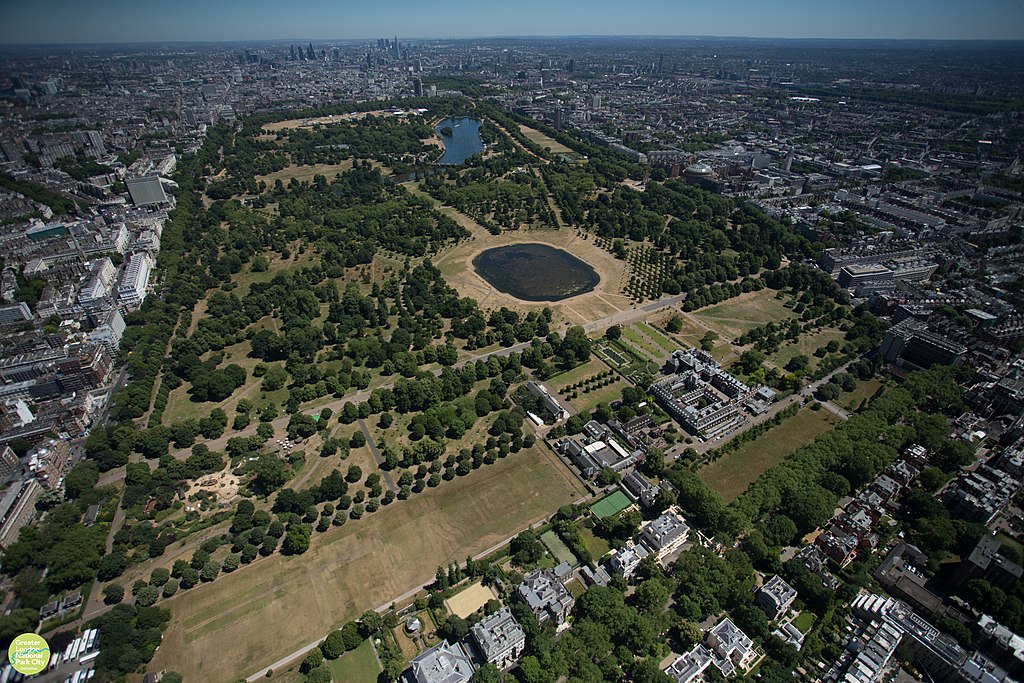
Hyde Park, London, England:
COVID was a picnic compared to the global pandemic in Charles Eric Maine's 1962 novel The Darkest of Nights - in which over half the population perishes, and rebellion and civil war break out over the government's contentious plans for shelters.
Hyde Park, site of one of the first of the underground shelters, had acquired a distinctly military aspect. Driving leisurely by, Clive saw barbed wire fencing patrolled by armed troops, and inside the wire were Nissen huts and armoured cars. At the southern side of the park, near Knightsbridge, two tanks stood squatly on their caterpillar tracks, guns facing outwards across the wide road junction...
Hyginus Cleft - see Mining the Moon.
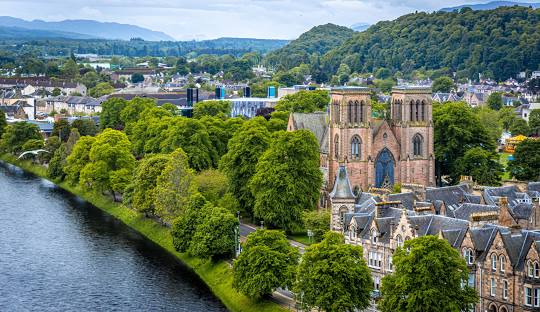
Inverness, Scotland:
A threat to clan-chief Cameron's nascent post-disaster community in the West of Scotland arises in Inverness, in Fred and Geoffrey Hoyle's Inferno (1973):
The temptation everywhere among the isolated pockets of humanity would be to live on existing stores of food, fuel and clothing. Where the stores were largest the temptation would be stongest. It could seem as if stocks might last for ever, but no stock or store would in fact last for ever. Sooner or later people would be thrown onto their own resources, and the sooner the better. Cameron had seen this plainly from the beginning. He had seen that parasites, human parasites, would arise wherever stocks and stores were ample.
This was exactly what happened in the Inverness region. The resources of Inverness were much greater than those of the western valleys. They were sufficient to maintain all survivors through the winter and early spring. Stocks of petrol were the first to run short. Restricted groups were soon in control of the remaining petrol. The groups fought and preyed on each other until one emerged stronger and more dominant than the others...
Iowa, USA:
...I stopped in a bar and looked at a newscast. There was no news from Iowa, but when is there any news from Iowa?
Robert A Heinlein, The Puppet Masters (1951)
See also Goose Island.
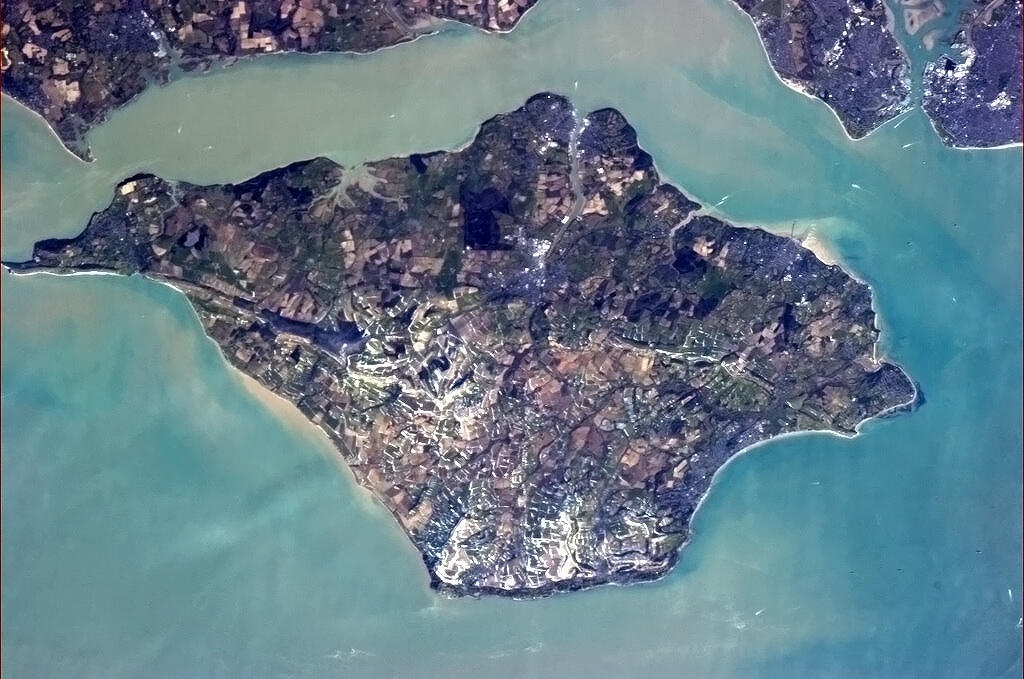 from the International Space Station
from the International Space StationIsle of Wight, England:
Commandeered by the Colossus computer.
"You want a site there?"
"No. I want the island. There is a human population of one million five hundred and twenty-seven thousand. They will have to be moved."
"What!" This shook Forbin right out of his scientific mood. "You can't mean that - move over a million and a half people! There must be some other site just as suitable!"
Colossus ignored him. "The island is 147 square miles in area, largely composed of chalk, a relatively good insulating material. Much of it will be leveled down to bare rock..."
D F Jones, Colossus (1966)
More optimistically, the Island figures as a redoubt against the vegetable scourge of the triffids:
Clearly, the best self-maintaining defence line would be water. To that end they had held a discussion on the various merits of various islands. It had been chiefly climate that had decided them in favour of the Isle of Wight, despite some misgivings over the area that would have to be cleared...
John Wyndham, The Day of the Triffids (1951), chapter 16

Kansas City, Missouri, USA:
Robert A Heinlein (himself a Missourian) in his ultra-tense invasion-novel The Puppet Masters (published 1951; set in 2007) has his agent driving into the city to determine whether it has been taken over by the parasitic Masters, who like to control humans by riding their backs. Chapter XVIII begins:
The city did not look right. It did not have the right flavour, as if it were a clumsily directed play. I tried to put my finger on the fault; it kept slipping away.
Kansas City has many neighbourhoods made up of family units a century old or more. Kids roll on lawns and householders sit on their front porches, just as their great-grandparents did. If there are bomb shelters around, they do not show. The queer old bulky houses, fitted together by guildsmen long since dead, make those neighbourhoods feel like enclaves of security. I cruised through along such streets, dodging dogs and rubber balls and toddlers, and tried to get the feel of the place. It was the slack of the day, time for a drink, for wwatering lawns, for neighbourly chatting. I saw a woman bending over a flower bed. She was wearing a sun suit and her back was bare; clearly she was not wearing a master, nor were the two kids with her. What could be wrong?
In If This Goes On - (Astounding 1940 (serialized); revised and expanded 1953 for inclusion in the Future History volume Revolt in 2100), Heinlein again brings the reader to this part of the country when his hero John Lyle, conspirator against the tyranny of the "Prophet", takes a transport rocket to KC.
...my stomach felt tight as we got off the ship in Kansas City. I expected that gentle touch on the shoulder which is more frightening than a fist in the face. But nothing happened...
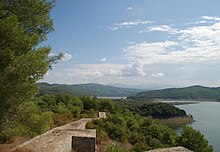
Karatepe, Turkey:
A Hittite fortress, Karatepe features in The Mind Parasites (1967), a novel by Colin Wilson related to Lovecraft's Cthulhu Mythos, as the site of the protagonist's detection, by means of an electronic probe, of a giant buried city two miles beneath the surface. At first the results are naturally disbelieved.
When I opened my eyes, I saw Reich standing beside me, staring out across the river. I looked at my watch, and sat up hastily.
"Why on earth didn't you wake me?"
He sat down on the ground beside me. His manner struck me as subdued.
"What is it? Can't you trace the fault?"
He looked at me thoughtfully.
"There is no fault."
Labrador, Canada:
This is the province inhabited by the post-apocalypic population described in John Wyndham's 1955 novel The Chrysalids.
The world... was generally thought to be a pretty big place, and probably round. The civilized part of it - of which Waknuk was only a small district - was called Labrador. This was thought to be the Old People's name for it, though that was not very certain. Round most of Labrador there was a great deal of water called the sea... if you were to go three hundred miles or so east, north, or north-west you would come to it sooner or later. But south-west or south, you wouldn't; you'd get to the Fringes and then the Badlands, which would kill you...
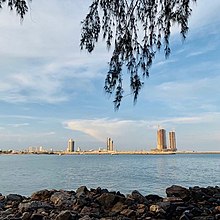
Lagos, Nigeria:
In the climate-change novel The World In Winter (1962) by John Christopher, the African nations enjoy a resurgence while Europe freezes to death. A lounge bar in Lagos is decorated to drive the point home.
...The walls had been painted with continuous murals, a series of huge concave panels. Around the bar they depicted snow and ice, from which projected broken fragments of masonry, towers, domes, pinnacles of brick and steel. These scenes changed, as one's gaze continued in either direction from the bar, into seas at first iceberg-laden, then empty, then calm and silvered by the sun. Past the seas... were the golden sands and palm-fringed shores of a warm and happy land...
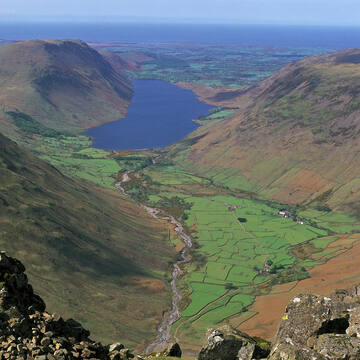
the Lake District, England:
Jerry Coleman, journalist, on his way to investigate a rumoured community of telepaths, has
...an odd feeling that, although he had never been within a hundred miles of the Lake District, the landscape was totally familiar.
Normally he might have put this impression down to the restimulation of half-forgotten memories of photographs and films of the area that he had seen in the past; but this was something more than a general impression. After they had passed through Kendal it became so strong that it could not be ignored. Time and again as he came to a corner, or to the top of a hill, it was as if he knew with certainty what lay beyond, down to the smallest detail. The view of a solitary farmhouse, the pattern of stone walls in a valley, crossing and recrossing with the jigsaw logic of some ancient rights of tenantry, a small church nestling against a clump of trees in the morning sunlight...
It was just after eleven when they began to run down a hill into the village of Alsdale. The feeling of familiarity was even stronger here; it was almost like coming home... Jerry found himself recognising the front of each stone cottage like the face of an old friend; knowing that the board outside the village pub would bear a faded picture of Nelson's flagship and the name VICTORY; that just beyond it would be the village store and post office, its brown-painted facia bearing the name GARFORTH in faded cream capitals...
- Dan Morgan, The Several Minds (1969)
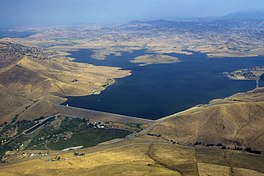
Lake Success, California, USA:
In the comet-strike disaster novel Lucifer's Hammer (1977) by Larry Niven and Jerry Pournelle, earthquakes cause the dam to collapse.
A bit later in the story, the area is a battleground between an organized group of survivors and the cannibalistic "New Brotherhood".
When the sun was high, they saw them: A hundred or more of the New Brotherhood had crossed during the night. They were concentrated now on the old Lake Success bed, and the moved back towards the ruined bridge, sweeping aside the screen of Stronghold defenders. The Brotherhood's mortars began to fire, forcing the defenders back up the valley and onto the ridges...
Laplace Promontory: see Sinus Iridum.
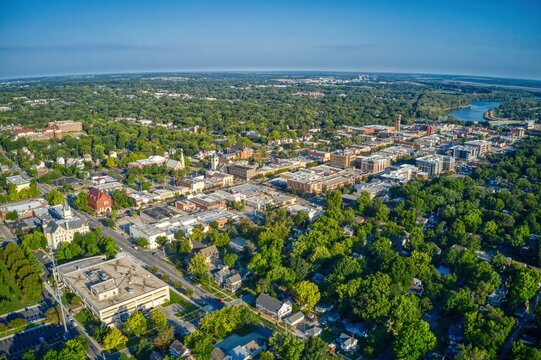
Lawrence, Kansas, USA:
In The Immortals by James E Gunn (1958, 1962) this city has taken over from Topeka as the state capital.
...They marched down the turnpike toward Lawrence...
The governor's mansion was built on the top of an L-shaped hill that stood tall between two river valleys. Once it had been the site of a great university, but taxes for supporting such institutions had been diverted into more vital channels. Private contributions had dwindled as the demands of medical research and medical care had intensified. Soon there was no interest in educational fripperies, and the university died.
The governor had built his mansion there some seventy-five years ago when Topeka became unbearable. Long before that it had become a lifetime office - and the governor would live forever.
The state of Kansas was a barony... The governor was a baron, and the mansion was his keep. His vassals were the suburban squires; they were paid with immortality or its promise...
...The mansion rose, ziggurat fashion, in terraced steps. On each rooftop was a hydroponic farm. At the summit of the buildings was a glass penthouse; the noon sun turned it into silver. On a mast towering above, a radar dish rotated...
Leicester, England:
Birthplace of author Colin Wilson. The city also appears, though without being described, in his Lovecraft-inspired novel The Philosopher's Stone (1969).
London, England:
In the hundredth century there won't be anything much left of its current self, according to Charles Eric Maine's The Man Who Owned the World (1961).
The city was unrecognizable, of course. In eight thousand years atomic bombardment, alternating with periods of rebuilding, had completely altered the geometry and appearance of the place; even the Thames, twisting and turning like a slender silver ribbon through areas of radioactive devastation, seemed to have changed its course at several points. Central London was a wilderness of fused stone and leaning skeletal buildings, blackened and oxidized by nuclear heat flash...
Lone Pine, Minnesota, USA:
A huge black box appears in the sky above Lone Pine, heralding the invasion described in Clifford Simak's The Visitors (1980). According to Wikipedia the town does exist, though regrettably I have not found a picture to put here.
Lone Pine, though not in Wisconsin, seems to be classic Simak country:
...Outside the shop, the two blocks of stores and business places in the town of Lone Pine drowsed in the late afternoon of an early autumn day. A few cars were parked along the street. Three dogs went through elaborate, formal canine recognition rites, three old friends meeting at the northwest corner of an intersection. Stiffy Grant, tattered and disreputable man-about-town, sat on a nail keg outside the town's one hardware store, paying close attention to the smoking of a fairly decent-sized cigar stub that he had rescued from the gutter. Sally, the waitress at the Pine Cafe, slowly swept the sidewalk in front of her place of employment, making the job last, reluctant to leave the warm autumn sunshine and go inside again...
Los Angeles, California, USA:
"...TV and radio transmission from your town called Los Angeles have ceased. It is probable that the heat flash has ignited it..." D F Jones, Colossus (1966)
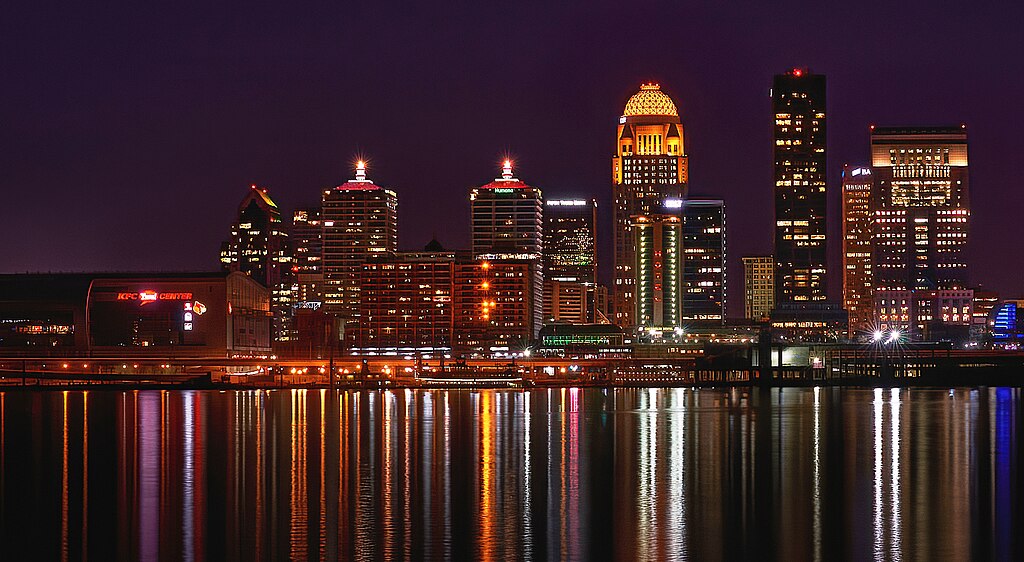
Louisville, Kentucky, USA:
Len looked at the pleasant village strung out along the canal, and at the wide green plain beyond it, dotted with farmsteads and grazing cattle... "That used to be a city, didn't it?"
"A big one."
"I remember now, it was named after the king of France. Mr. Hostetter - "
"Hm?"
"Whatever happened to those countries - I mean, like France?"|
"They're just about like us - the ones on the winning side. Lord knows what happened to the ones that lost. The whole world has jogged back to pretty much what it was when Louisville was this size before, and this canal was first dug..."
From Leigh Brackett's post-disaster novel The Long Tomorrow (1955).
 Romney Marsh from Lympne
Romney Marsh from LympneLympne, Kent, England:
Certainly if any one wants solitude, the place is Lympne. It is in the clay part of Kent, and my bungalow stood on the edge of an old sea cliff and stared across the flats of Romney Marsh at the sea... It was the big port of England in Roman times, Portus Lemanus, and now the sea is four miles away. All down the steep hill are boulders and masses of Roman brickwork, and from it old Watling Street, still paved in places, starts like an arrow to the north... H G Wells, The First Men in the Moon (1901)
Lyon, Lyonnais, France:
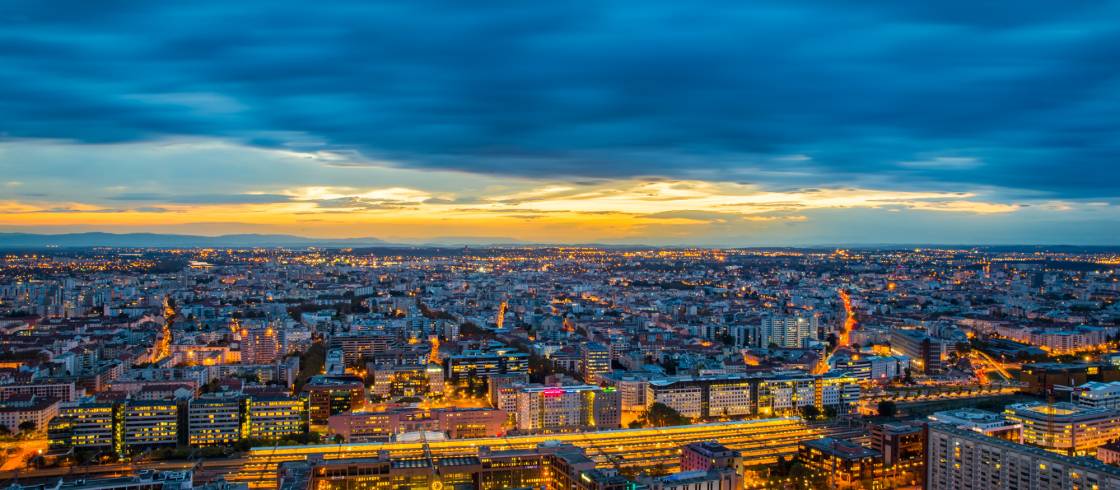
From The Many-Coloured Land (1981) by Julian May:
...Madame underwent rejuvenation and displayed an austere chic in her second lifetime. In the valley below the inn, the most ancient urban center in France also underwent graceful transition, as did all of the metropolitan centers of Old Earth in those middle years of the twenty-first century. Every trace of the ugly, ecologically destructive technology was gradually obliterated from the great city at the confluence of the Rhône and Saône. Necessary manufacturing establishments, service and transit systems were relocated in underground infrastructures. As the surplus population of Lyon was siphoned off to the new planets, empty slums and dreary suburbs faded into meadows and forest reserves, dotted here and there with garden villages or efficient habitat complexes. Lyon's historic structures, representing every century for the more than 2000 years of its lifetime, were refurbished and displayed like jewels in appropriate natural settings. Laboratories, offices, ghotels, and commercial enterprises were tucked into recycled buildings or disguised to harmonize with the ambiance of nearby monuments. Plaisances and boulevards replaced the hideous concrete autoroutes. Amusement sites, picturesque alleys of small shops, and cultural foundations multiplied as colonials began returning to the Old World from the far-flung stars, seeking their ethnic heritage...
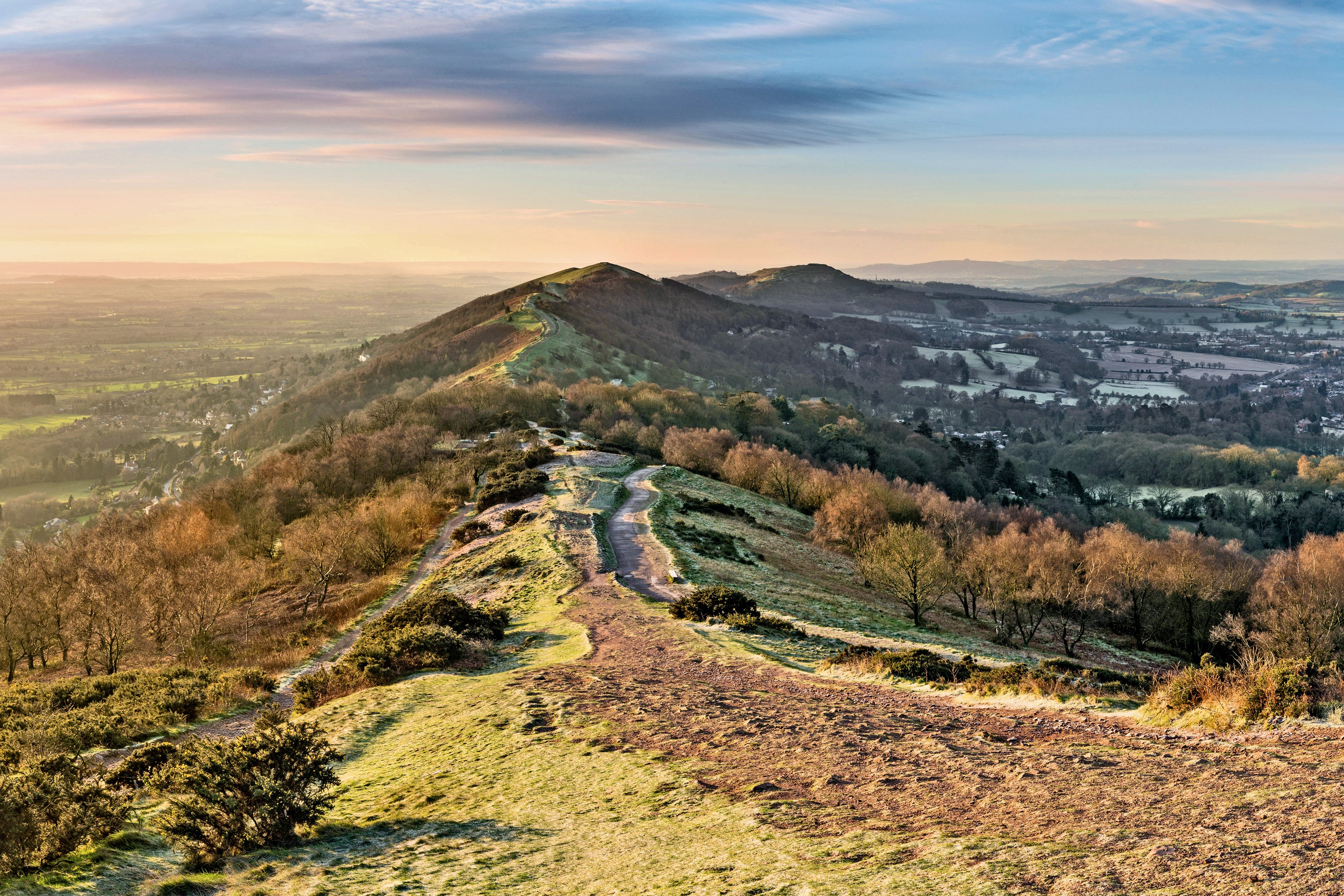
the Malvern Hills, Worcestershire, England:
This beautiful area provides the peaceful opening scene in John Boland's 1955 thriller about weather used as warfare, White August, in which an unnamed enemy seeks to destroy Britain by a radioactive snowfall:
At seven o'clock on the evening of July 28th, the sun glared down from a cloudless sky. Over the whole of the Worcestershire countryside its rays were still a burden after a day of almost intolerable heat. On the slopes of the Malvern Hills gangs of weary, sweating men had extinguished the gorse fire, although smoke still rose straight from the ashes in many places.
Three miles to the west of the hills the village of Sturridge was amost without movement; the only mad-made sounds a bumble of voices and the clinking of glasses that fliltered from the open windows of the Wheel Inn...
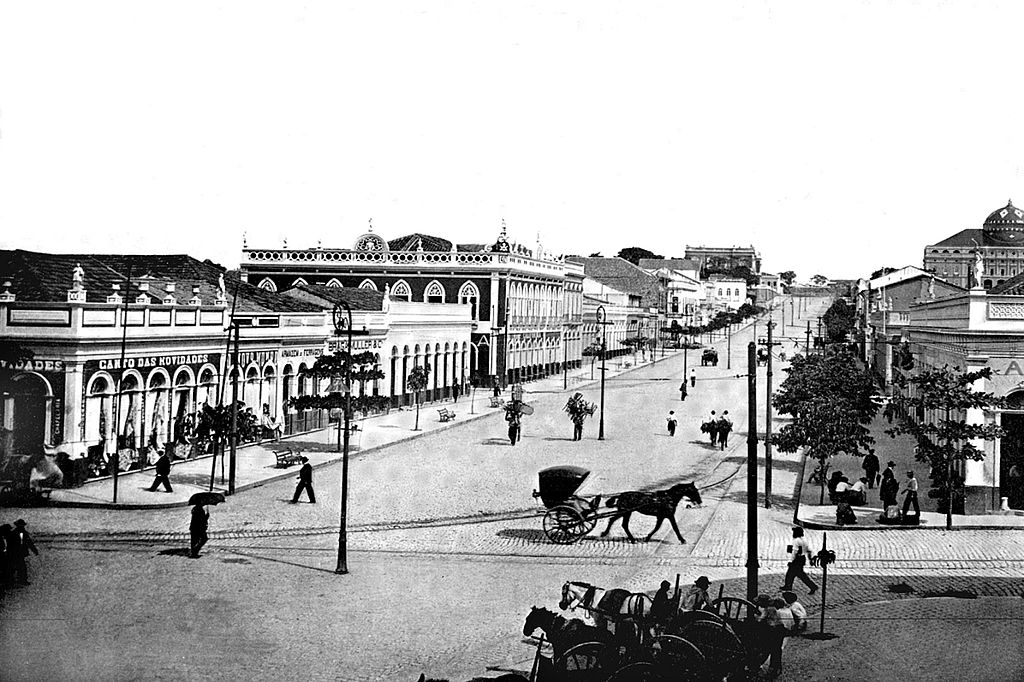 Av. Edouardo Ribeiro, 1901
Av. Edouardo Ribeiro, 1901Manaus, Amazonas, Brazil:
In Sir Arthur Conan Doyle's The Lost World (1912) Professor Challenger meets the other members of the expedition at Manaus.
"Is all ready for your journey?" he asked.
"We can start to-morrow."
"Then so you shall. You need no chart of directions now, since you will have the inestimable advantage of my own guidance. From the first I had determined that I would myself preside over your investigation. The most elaborate charts would, as you will readily admit, be a poor substitute for my own intelligence and advice..."

Manhattan, New York, USA:
One of the few survivors of a global pandemic, thoughtful loner Isherwood Williams travels through a USA largely emptied of humanity, and eventually reaches deserted New York City, in George R Stewart's 1949 classic Earth Abides.
...He swung north and at last crossed by the empty George Washington Bridge, and came to Manhattan.
Stretched out between its rivers, the city will remain for a long time. Stone and brick, concrete and asphalt, glass - time deals gently with them. Water leaves black stains, moss shows green, a little grass springs up in the cracks. (That is only the surface.) A window-pane grows loose, vibrates, breaks in a gusty wind. Lightning strikes, loosening the tiles of a cornice. A wall leans, as footings yield in the long rains; after years have passed, it falls, scattering bricks across the street. Frost works, and in the March thaw some flakes of stone scale off. (It is all very slow.) The rain washes quietly through the gutters into the storm-drains, and if the storm-drains clog, the rain runs still through the gutters into the river. The snow piles deep in the long canyons, drifting at the street corners; no one disturbs it. In the spring, it too runs off into the gutters. As in the desert, a year is like an hour in the night; a century, like a day.
Indeed, the city is much like the desert. From the asphalt-and-concrete-coated soil the rain runs off... Here and there in a crack the subtle grass and the hardy weeds grow up a little, but no tree or vine or tall grass takes root... after a while even the rats go away... Only the flying creatures find there a refuge... It will remain a long time, a very long time. [See also Central Park.]
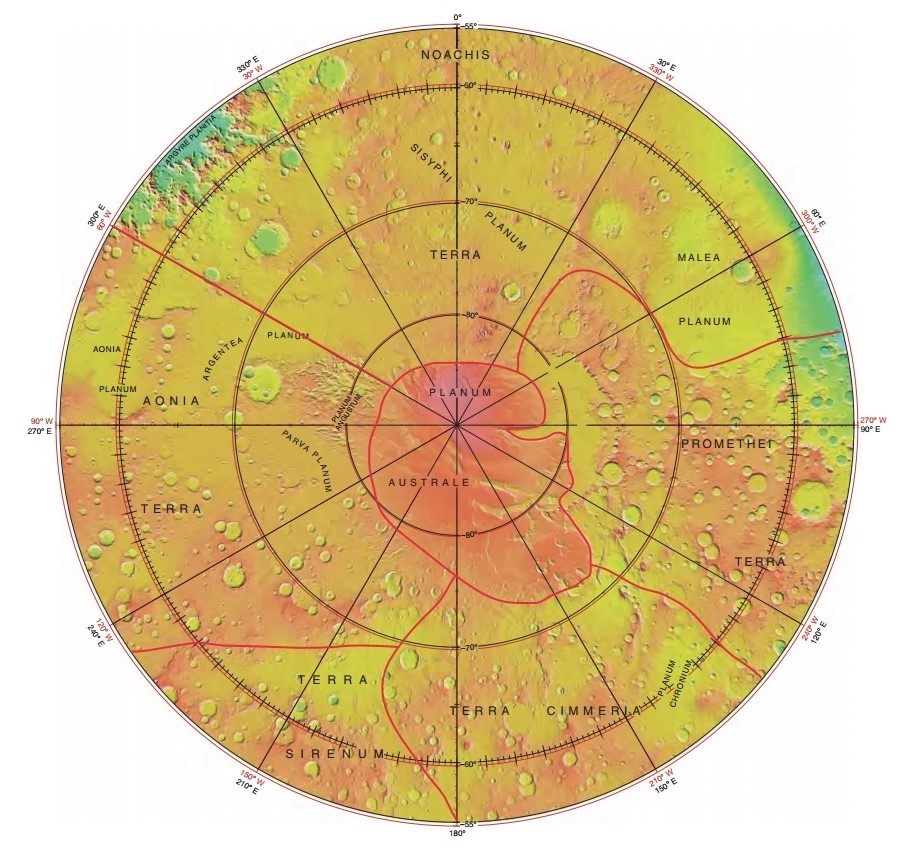 south-polar-centred Mars
south-polar-centred MarsMare Cimmerium:
The landing site of the Ares, the first spaceship to Mars, in Stanley Weinbaum's classic tale A Martian Odyssey (Wonder Stories, July 1934).
Note that on the map shown here Mare Cimmerium is renamed Terra Cimmeria. I assume that this is because the International Astronomical Union decided that "mare" (= sea) was no longer an appropriate term, since we now know there are no seas on Mars, and hence all the maria are now termed "terrae" (lands). (I also assume that the reason the IAU hasn't dared pursue the same policy with regard to our names of features on the Moon is simply that, despite their itch for literalness, they've have to accept that Mare Imbrium, Mare Serenitatis, etc, are too deeply embedded in our culture to be tampered with.)
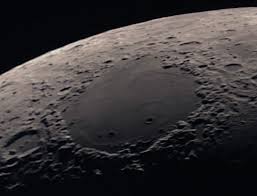
Mare Crisium:
...the great walled plain, one of the finest on the Moon... Three hundred miles in diameter - and almost completely surrounded by a ring of magnificent mountains, it had never been explored until we entered it in the late summer of 1996.
Our expedition was a large one. We had two heavy freighters which had flown our supplies and equipment from the main lunar base in the Mare Serenitatis, three hundred miles away...
Arthur C Clarke, The Sentinel (10 Story Fantasy, Spring 1951)
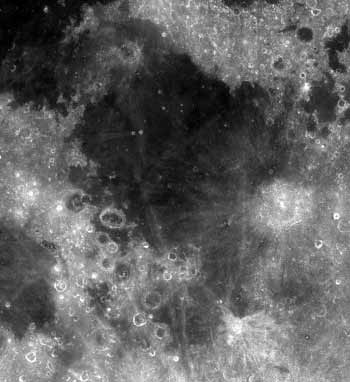
Mare Fecunditatis:
...She stepped to the window; scudding clouds had just uncovered the Moon. It was three days old and Mare Fecunditatis - the roll of hair at the back of the Lady-in-the-Moon's head - was cleared by the Sunrise line. Near the right-hand edge of that great, dark 'sea' was a tiny spot, visible only to their inner eyes - Luna City...
Robert A Heinlein, It's Great To Be Back (Saturday Evening Post, 26 July 1947)
...He picked out the landmarks made familiar to him by a thousand photographs with nostalgic pleasure, as if he were returning to his own country. McIntyre brought her slowly down as they came back around to the Earthward face, and prepared to land east of Mare Fecunditatis, about ten miles from Luna City...
Robert A Heinlein, Requiem (Astounding, January 1940)
My own interpretation of the above two passages is that Luna City stands not on the plain of the Mare itself but just past the edge of it.
Mare Frigoris:
See The Mare Frigoris Culture, a story of a lunar colony from the time of Leonardo da Vinci, by Robert Gibson.
Mare Imbrium:
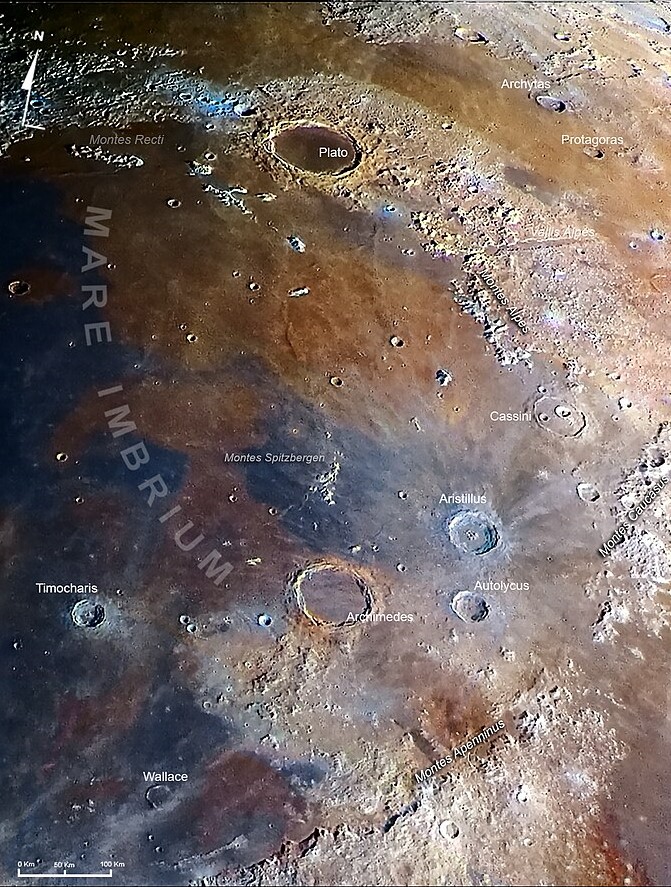
From Arthur C Clarke's first novel, Prelude to Space (written in 1947, published 1951) - the pre-flight presentation in which is revealed the landing-site for the first expedition to the Moon:
"This area is one of the most interesting ones on the Moon, and certainly has the finest scenery, but we can only explore a small region on our first visit. We shall land about here (Next Slide, please), and this is a drawing of the area under the greatest magnification we can use...
"The exact spot for the landing will be decided during the approach..."
See also under Alpine Valley.
Mare Insularum:
For the highlands on the eastern border of this mare see the entry for Gruithuisen's Lunar City.
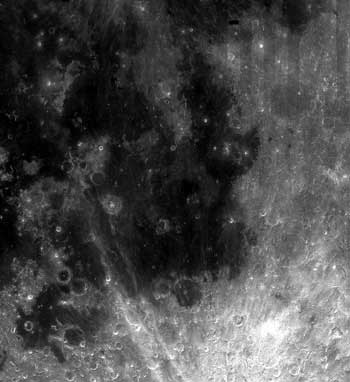
Mare Nubium:
Captain Brunel leads his crew of misfits on a strange expedition here in William F Temple's Shoot at the Moon (1966).
At 15.45 G.M.T. on June 21 the Endeavour made a perfect landing on the Mare Nubium.
...Bill Burton, in his book, praised the masterly landing... but rather spoiled the effect by adding that I had mistaken the map reference. That I'd touched down twenty miles from Bullialdus instead of the same distance from Copernicus, with which I had confused it. He was tactful about it...
From R W Mackleworth's Starflight 3000 (1972):
In less than a day, a day with a few hundred hours and a dozen sleep periods, he would reach the shallow sea they called the Mare Nubium - a sea that was once a dusty plain. Now it was a sea indeed though the water was only twenty feet in depth and in constant and violent movement for the most part...
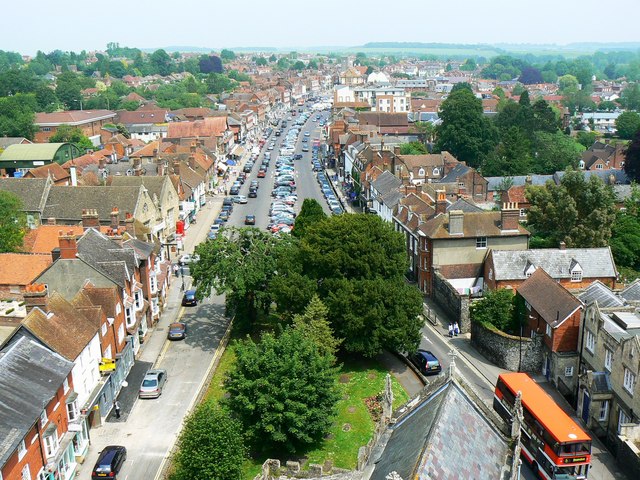
Marlborough, Wiltshire, England:
Set in a future in which the Earth has undergone violent geological upheaval, John Christopher's Beyond the Burning Lands (1971) has a scene set in Marlborough where visitors find the inhabitants to be temperamentally influenced by their town's proximity to a barrier of volcanoes.
That night when they feasted us they unbent somewhat but not much. Their eyes watched us and each other. I thought I understood them better then, because though the Great Hall was hung with lamps they were scarcely wanted: so bright was the glow that came in at the windows. The hills rose above the town and above the hills the sky was red, a heavy crimson from which now and then spouted gouts of orange flame. Seeing this I realized that darkness, which they never truly knew, could be a comforting and friendly thing. They lived their lives under this ominous light and it was small wonder they were soured by it. And there were ugly sounds as well - distant foreboding rumblings as the earth growled in pain.
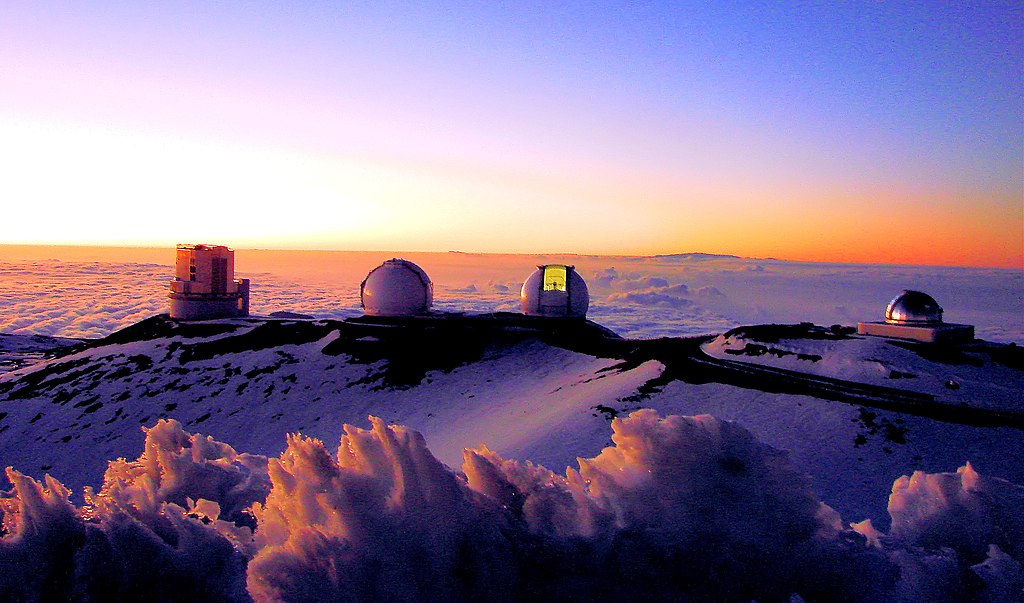
Mauna Kea, Hawaii, USA:
..."Regulations. Acclimatization. It's nearly fourteen thousand feet at the top. Pretty thin air... It's not easy to do anything, even walk, until you get used to it."
By the time they reached the clapboard barracks buildings she was ready to agree.
...There were half a dozen observatories on the lip of the volcano. Richard parked the Jimmy in front of the NASA building. It looked like an observatory in a Bugs Bunny cartoon: a square concrete building under a shiny metal dome.
"Do I get to look through the telescope?" she asked.
He didn't laugh. Maybe he had answered that one too often. "No one looks through telescopes anymore. We just take pictures." He led the way inside, through bare-walled corridors and down an iron stairway to a lounge furnished with chrome-steel office tables and chairs...
From Footfall (1985) by Larry Niven and Jerry Pournelle.
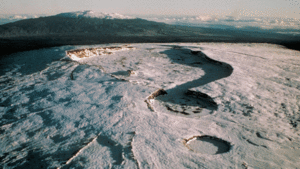 the summit caldera
the summit calderaMauna Loa, Hawaii, USA:
Her companion nodded and pointed toward the slopes off to their right. "Mauna Loa. They said it's terrible luck to take any of the lava home."
"Who says?"
"The Old Hawaiians, of course. But a surprising number of tourists, too. They take the stuff home, and later they mail it back." He shrugged. "Bad luck or no, so far as anyone knows, she - Mauna Loa is always she to the Old Ones - she's never taken a life."
from Footfall by Larry Niven and Jerry Pournelle (1985)
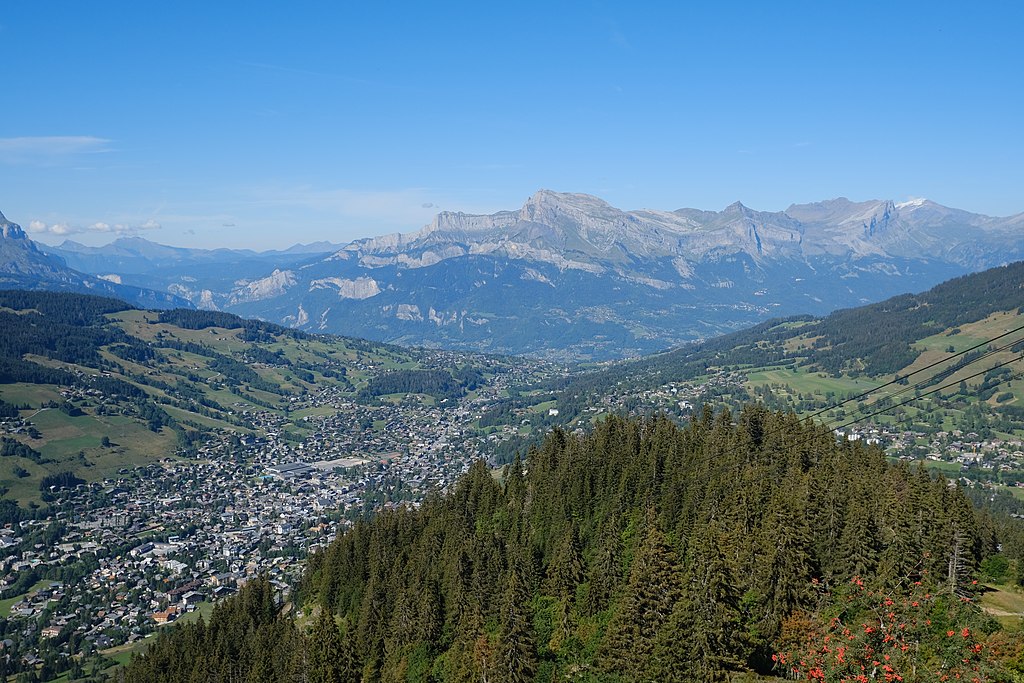
Megève, Haute-Savoie, France:
In the future history The Shape of Things to Come (1933) by H G Wells, this ski-resort town was where the World Council met to dissolve itself in 2059 - this act being the demonstration of the achieved lucidity of the human race; a witness to the complete solidarity of mankind in 2059, the disappearance of the last shadows of dislike and distrust between varied cults, races and language groups... No further need, therefore, of a World Government.
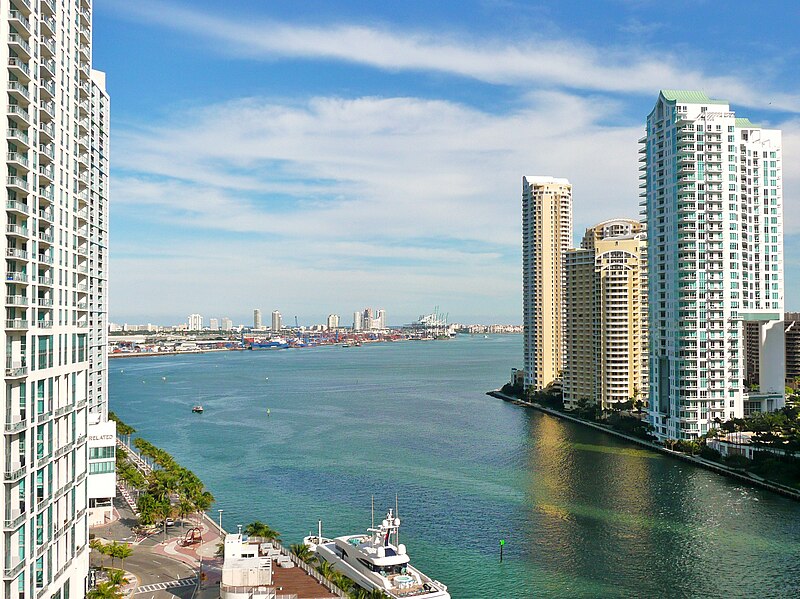 No sign of Earthport yet, but give "Miami, Fla." time to evolve via "Miamifla" to "Meeya Meefla"...
No sign of Earthport yet, but give "Miami, Fla." time to evolve via "Miamifla" to "Meeya Meefla"...Miami, Florida, USA:
By the far-future days described by Cordwainer Smith in The Dead Lady of Clown Town (Galaxy, August 1964), just one place-name from Old Earth survives, in evolved form.
Go back to An-fang, the Peace Square at An-fang, the Beginning Place at An-fang, where all things start. Bright it was. Red Square, dead square, clear square, under a yellow sun.
This was Earth Original, Manhome itself, where Earthport thrusts its way up through hurricane clouds that are higher than the mountains.
An-fang was near a city, the only living city with a pre-atomic name. The lovely meaningless name was Meeya Meefla, where the lines of ancient roadways, untouched by a wheel for thousands of years, forever paralleled the warm, bright, clear beaches of the Old South East...
Convulsions in Earth's crust in 1990 have left the city still in some sort of order the following year in Keith Laumer's 1966 thriller Catastrophe Planet:
...Early afternoon brought me into Miami. The beach was wiped clean - a bare sandbar, but the city proper still gleamed white beside a shore stained black by pumice and scum oil, and heaped with the jetsam of a drowned continent. Conditions were better here. There had been no major quakes to judge from the still-standing towers of coral and chartreuse and turquoise; maybe their hurricane-proof construction had helped when the ground shook under them. There was even a semblance of normal commerce. Police were much in evidence, along with squads of nervous-looking Guard recruits weighed down with combat gear. Lights were on in shops and restaurants, and the polyarcs along Biscayne were shedding their baleful light on an orderly traffic of cars, trucks and buses. There were fewer people on the streets than in normal times, but that suited me...
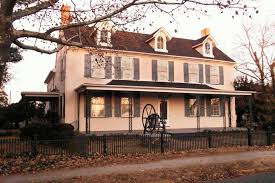 I'd rather have had a street view but this is better than nothing.
I'd rather have had a street view but this is better than nothing.Millville, Wisconsin, USA:
...The town lay dusty and arrogant and smug beyond all telling and it sneered at me and I knew that I had been mistaken in not leaving it when I'd had the chance. I had tried to live with it for very love of it, but I'd been blind to try. I had known what all my friends had known, the ones who'd gone away, but I had closed my mind to that sure and certain knowledge: there was nothing left in Millville to make one stay around. It was an old town and it was dying, as old things always die. It was being strangled by the swift and easy roads that took customers to better shopping areas; it was dying with the decline of marginal agriculture, dying along with the little vacant hillside farms that no longer would support a family. It was a place of genteel poverty and it had its share of musty quaintness, but it was dying just the same, albeit in the polite scent of lavender and impeccable good manners...
And then comes the amazing force-field around Millville! All Flesh is Grass (1965), an unforgettable alien-contact tale by Clifford D Simak, is a novel to re-read every few years.
The town it describes seems so archetypal that I was recently surprised and delighted to find that it actually exists. Not only that: it was the place where Simak was born, on 3rd August 1904.
However, it's darned difficult to find a photographic vista of Millville. While searching, I found a possible reason for this: the population at the last
count had shrunk to about 90 people! Simak would not, perhaps, have
been surprised.
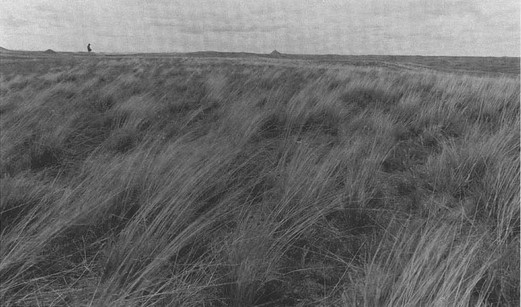
Montana, USA:
My idea of this state came originally from reading Patrick Tilley's Fade-Out (1975), a novel of extraterrestrial visitation. I read it in the late 1970s and ever since then a mention of Montana has conjured in my mind the image of an alien epiphany. Somehow the locale is so appropriate:
North of Miles City, the land is known as 'The Big Open'. Bare, rolling, high plains country with as few trees as there are people. For mile after mile on either side of the two-lane hog-backed highway, there is nothing but endless stretches of buffalo grass and sage. Cattle country, scarred here and there by poisonous salt pans, and the intertwined, weathered clusters of gumbo and sandstone buttes that make up the eastern Montana badlands...
Montes Recti - see the Straight Range.
Morbihan, Brittany, France:
A monstrous extraterrestrial peril haunts Chateauverne, a village in the department of Morbihan, in Eric Frank Russell's The Sin of Hyacinth Peuch - published in the collection Dark Tides (1962):
...To look at Chateauverne today you would find it difficult to believe that not so long ago its inhabitants feared to walk in darkness...
Chateauverne is a cluster of terra-cotta-roofed houses hugging a cobbled square where Hyacinth Peuch, the local imbecile, slumbers among the hogs and chickens. At one side rises the solemn-belled tower of the Eglise. Next to it sits the hoary home of the Abbé and the general store of the Widow Martin. At the opposite side, shading the seated cynics, is the long, low auberge of Jean-Pierre Boitavin, whose brother Baptiste was the fourth to be slaughtered before the rain came...
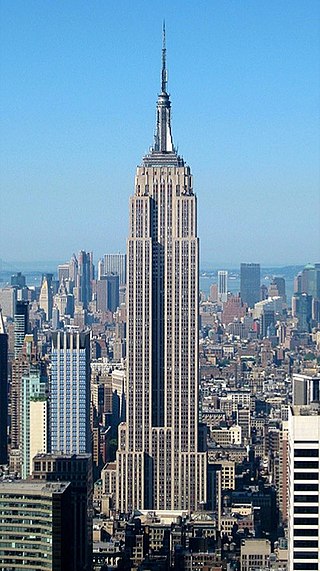
New York City, New York, USA (and see also entries for Central Park and Manhattan):
Some key characters in Poul Anderson's eucatastrophic novel Brain Wave (1954), in which all neural impulses on Earth are abruptly boosted by the Solar System's exit from an "inhibitor field", witness the social and political transformations in their work-place in the city, consequent upon the sudden increase in human intelligence (while elsewhere, in the countryside, other characters experience the results of increases in animal intelligence too). Already, in Chapter One,
...He noticed vaguely that the train was quieter than ordinarily. People were less hurried and unmannerly, they seemed thoughtful. He glanced at the newspapers, wondering with a gulp if it had started, but there was nothing really sensational - except maybe for that local bit about a dog, kept overnight in a basement, which had somehow opened the deep freeze, dragged the meat out to thaw, and been found happily gorged...
By Chapter Six, researcher Pete Corinth can see that the city is
...sliding swiftly towards disruption and death.|
Only a few subways were running, an emergency system manned by those devoted enough to stay by a job which had become altogether flat and distasteful. The stations were hollow and dark, filthy with unswept litter, and the shrieking of wheels held a tormented loneliness. Corinth walked to work, along dirty streets whose traffic had fallen to a reckless fragment of the old steady river...
In Chapter Ten he reflects:
...Big cities had no real economic justification. He came from a small town, and he had always loved mountains and forests and sea. Still, there was something about this brawling, overcrowded, hard, inhuman, magnificent city whose absence would leave an empty spot in the world to come...
You get a more jaundiced view of the city in Frederick Pohl's The Merchants' War (1984):
New York, New York. What a wonderful town! All my fretful annoyances were submerged... Ten years didn't seem to have changed the tall buildings that disappeared into the gray, flaky air. The cold, gray, flaky air. It had gone winter again; there were patches of dirty snow in corners, and an occasional consumer furtively scooping them up to take home to avoid the freshwater tax. After Venus, it was heaven! I gawked like a Wichita tourist at the Big Apple. I walked like one, too, bumping into scurrying pedestrians, and things worse than pedestrians. My traffic skills were gone. After the years on Venus I just wasn't used to civilized ways. There was a twelve-pusher pedibus here, three cabs competing for one gap in the flow there, pedestrians leaping desperately between the vehicles all over...
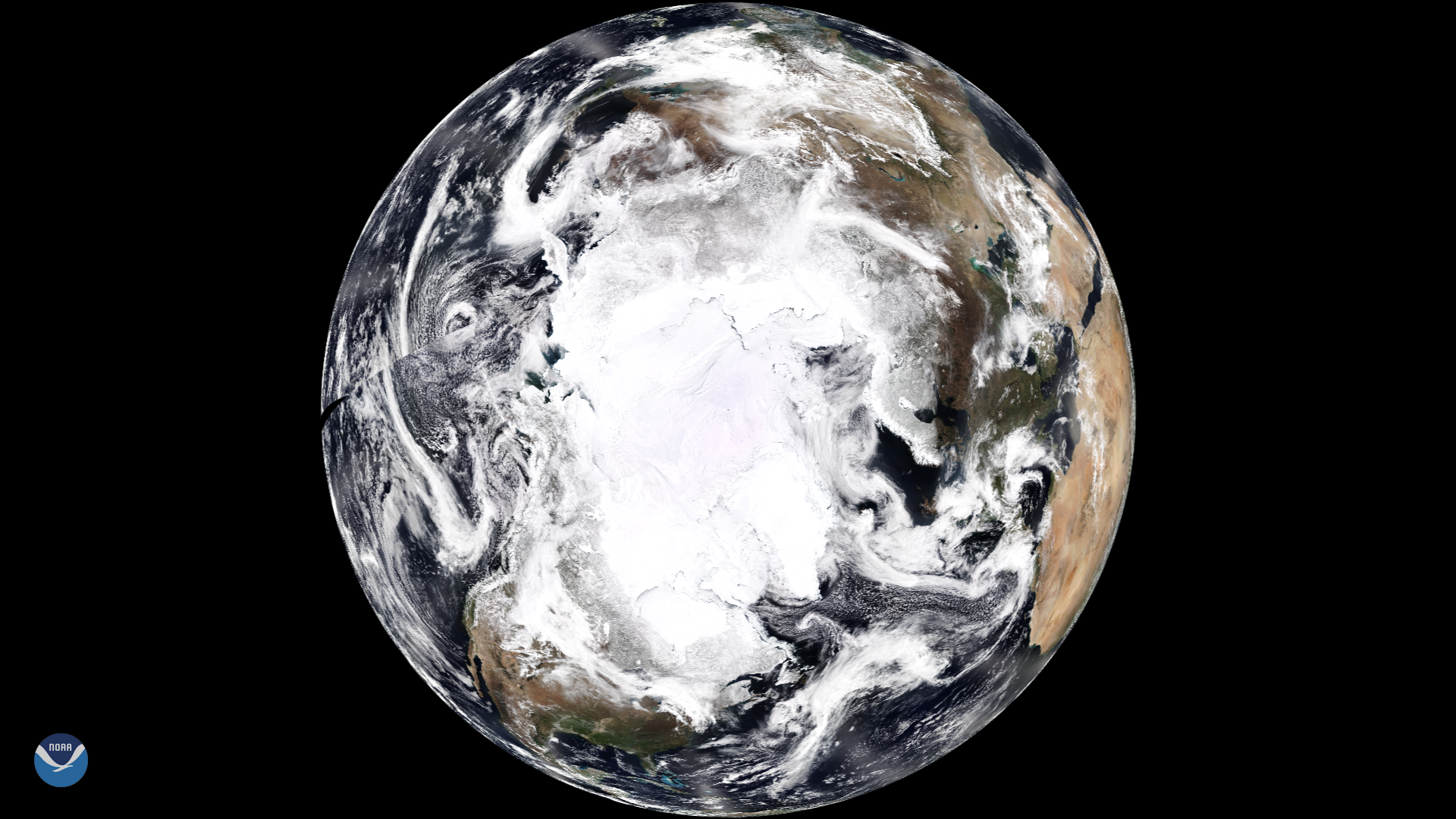
North Pole, Earth:
That very night, Curt had flown from the moon to Earth and had secretly visited the President, offering the service of his abilities in the war against interplanetary crime.
"I know you have no faith in me now," he had told the President, "but a time may come when you'll need me. When that time comes, flash a signal flare from the North Pole. I'll see it, and come."
Edmond Hamilton, Captain Future and the Space Emperor (1939, 1967).
Stid: It's cute that Cap. Future is so self-confident, he can make this offer even before he's done anything.
Zendexor: I wondered about that, myself. I am, however, a more obedient reader than you are; if I'm told to be impressed, I'm impressed. Usually.
What does bother me a bit more, is the practicality of the idea. At least one of the planeteering Futuremen must stay placed to keep an eye on Earth's North Pole at all times if the arrangement is to work...
 Lanikai Beach
Lanikai BeachOahu, Hawaii, USA:
The scene of Edgar Rice Burroughs' farewell visit from his creation, John Carter of Barsoom, Warlord of Mars.
From the Foreword to Llana of Gathol (1941, 1948):
Lanikai is a district, a beach, a Post Office, and a grocery store. It lies on the windward shore of the Island of Oahu. It is a long way from Mars. Its waters are blue and beautiful and calm inside its coral reef, and the trade wind sighing through the fronds of its coconut palms at night might be the murmuring voices of the ghosts of the kings and chieftains who fished in its still waters long before the sea captains brought strange diseases or the missionaries brought mother-hubbards.
Thoughts of the past, mere vague imaginings, were passing idly through my mind one night that I could not sleep and was sitting on the lanai watching the white maned chargers of the sea racing shoreward...
In addition to being marked by the visit from John Carter, Lanikai on Oahu is also where Burroughs receives the communication from his other planetary wanderer, Carson Napier, who telepathically relates the adventures on Amtor recounted in Escape on Venus (1946).
Historical note: in real life, Burroughs was living on Oahu in December 1941 and witnessed the attack on Pearl Harbour.
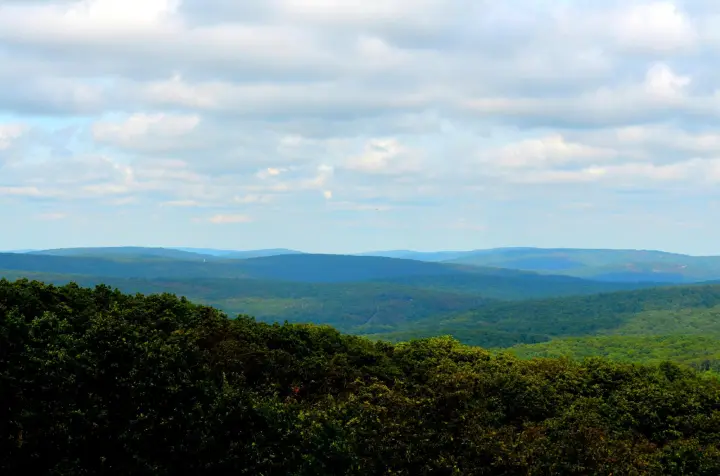
the Ozarks, Missouri, USA:
In this rural setting a researcher encounters the telekinetic "witch"-girl Abbie, in the novella by James E Gunn, Wherever You May Be (Galaxy, May 1953).
A tinkling of little silver bells. Laughter? Matt looked up quickly, angrily. The woods were thin along the top of this Ozark ridge. Descending to the lake, sparkling cool and blue far below, they grew thicker, but the only one near was the young girl shuffling through the dust several hundred yards beyond the crippled car. And her head was bent down to watch her way.
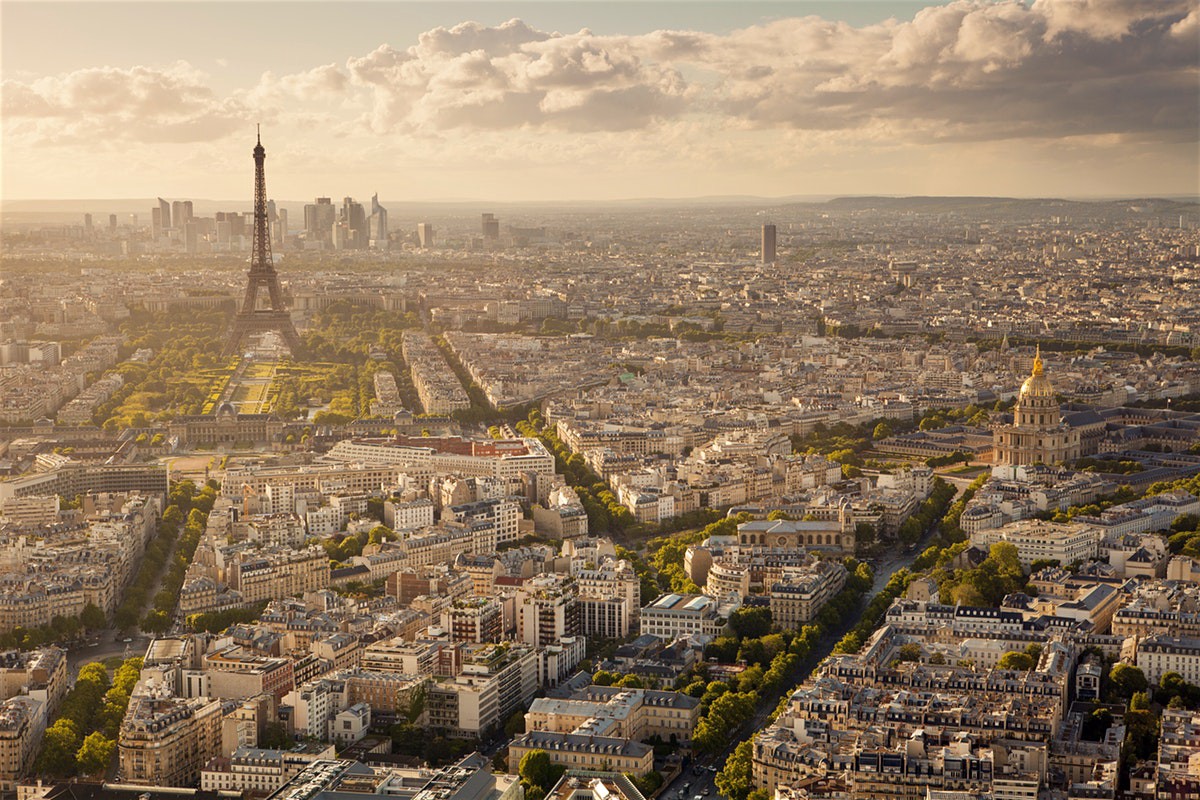
Paris, France:
The young outlaws fleeing the alien regime in John Christopher's The White Mountains (1967) approach the ruins of France's capital.
...I had never seen anything remotely like it before. It stretched for miles, rising in hills and valleys. The forest had invaded it - there was the tossing green of trees everywhere - but everywhere also were the grey and white and yellow bones of buildings. The trees followed lines among them, like veins in some monstrous creature...
...The trees followed the old streets, sprouting out of the black stone of which they had been built, and thrusting their tops up above the canyons formed by the buildings on either side...
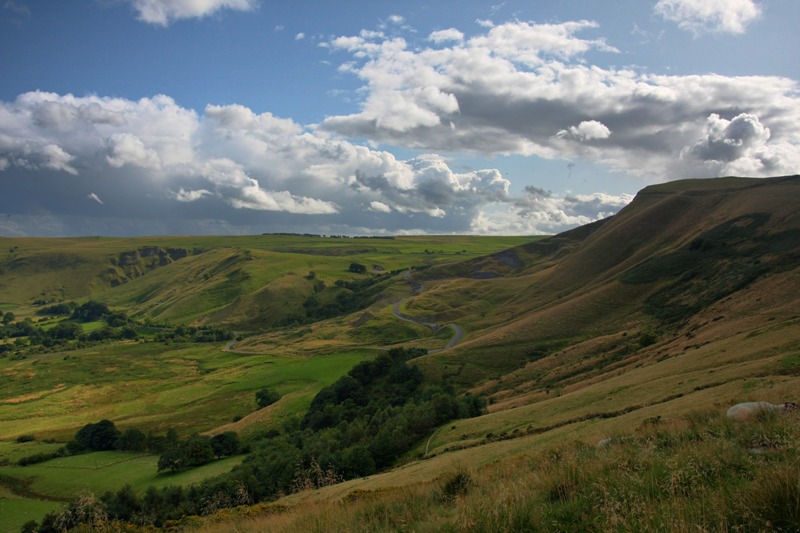
the Peak District, (mostly in) Derbyshire, England:
This area is the site of Glyn Weston's time-travel experiments, in Seeker of Tomorrow (Astounding Stories, July 1937) by Eric Frank Russell and Leslie J Johnson.
...I had set up my laboratory in the wilds of the Peak District of Derbyshire, in England, where work could be carried on with the minumum of interference. From this laboratory I had dispatched into the unknown, presumably the future, a multitude of objects... In no case could I bring back anything I had made to vanish. Once gone, the subject was gone forever. There was no way of discovering exactly where it had gone. There was nothing but to take a risk and go myself...
Peoria, Illinois, USA:
In Maker of Universes (1965) by Philip Jose Farmer, Peoria is where a "crescent" for an interdimensional gateway turns up in a pawnshop. (Such gadgets are used by the tyrannical Lords of pocket universes for travel between one private cosmos and another.)
...How it had gotten there and what Lord had lost it on Earth would never be known. Doubtless there were other crescents in obscure places on Earth...
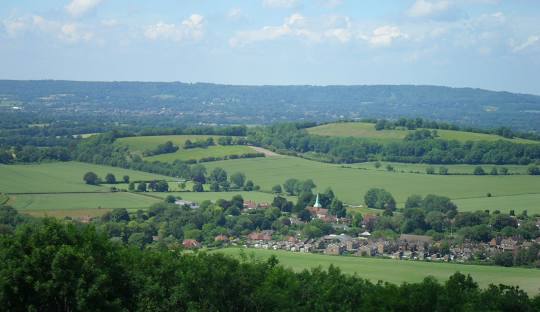
Petersfield, Hampshire, England:
In the post-disaster setting of John Christopher's The Prince In Waiting (1970), when geologic upheaval and magnetospheric change has led to widespread mutation, earthquakes and volcanism, a hierarchy of "Seers" and "Spirits" has prohibited the use of machinery by the masses. Nevertheless the defenders of Petersfield, when attacked by the men of Winchester, take the dastardly step of using cannon, with deadly effect. This does not deter the Prince of Winchester from leading his army onward against Petersfield's walls.
It seemed hopeless. They had to advance on foot with the machines, three of them, blasting down at them from above. Even without these, scaling the walls would have seemed impossible. Because of the risk of earthquakes they were of loose construction but they were steeply sloping and more than thirty feet high, manned by archers who could pick off the crawling attackers with ease. One of the Captains had suggested making the attck at some other point where there might not be machines but my father refused...
Peterson Field, Colorado, USA:
Scene of the launch of the first Moon flight, in Heinlein's The Man Who Sold The Moon (1950).
Phoenix, Arizona, USA:
In this area, in chapter one of Maker of Universes (1965) by Philip Jose Farmer, a former amnesiac named Robert Wolff is viewing a house with a view to purchase, when he is contacted from outside the cosmos:
...A minute ago, he had looked inside the closet. Nothing except the cement floor, the white plasterboard walls, the clothes rod and hooks, a shelf and a lightbulb was there.
Yet he had heard the trumpet notes, feeble as if singing from the other wall of the world itself. He was alone, so that he had no one with whom to check the reality of what he knew could not be real...
Pico, Mare Imbrium
Two writers have associated this isolated lunar mountain with the theme of conflict.
Mysterious alien domes - at first suspected to be Russian - appear in the Pico area in Hugh Walters' Blast Off At Woomera (1957). In the sequel, The Domes of Pico (1958), the aliens threaten Earth with harmful radiation.
This same region is the scene of the climacteric Battle of Pico in Earthlight (1955), a novel set in the 22nd century, by Arthur C Clarke.
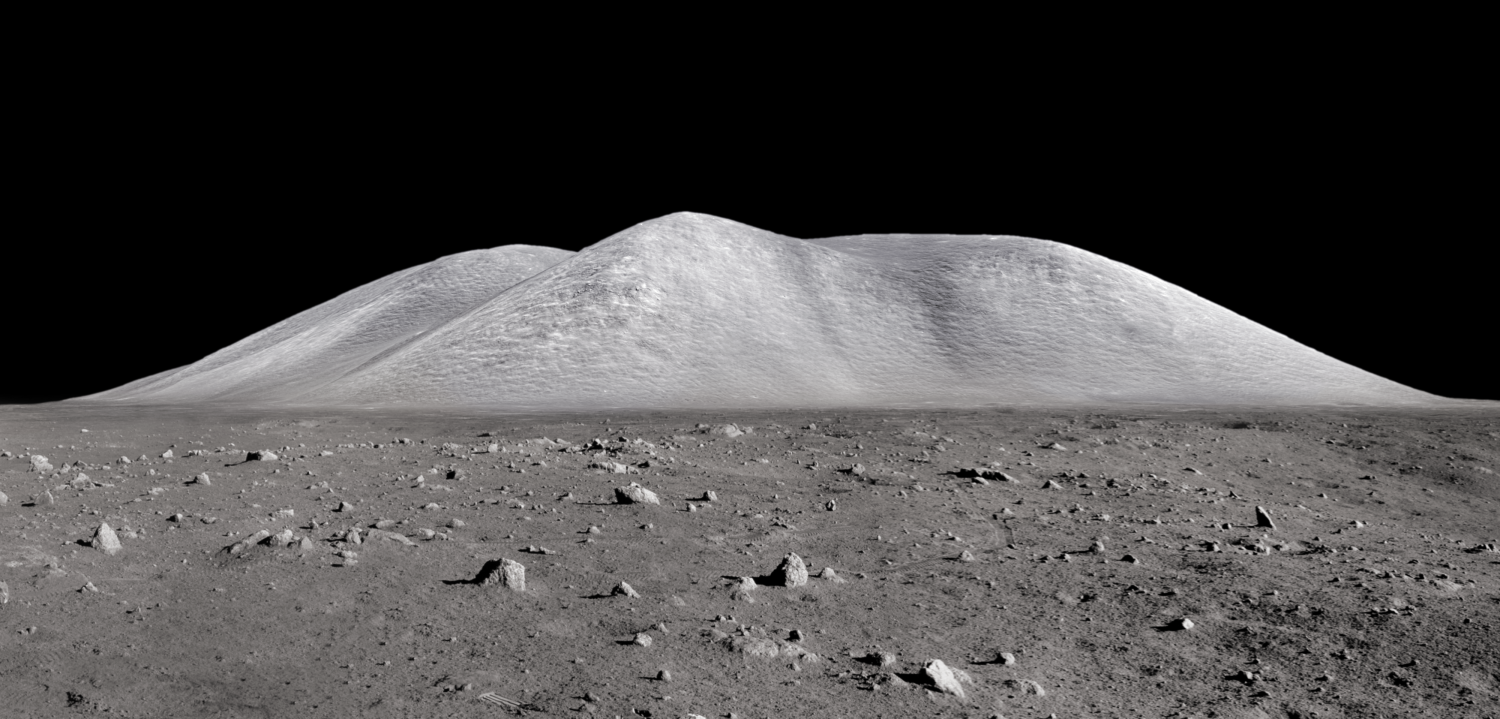 height: a little under 8,000 feet
height: a little under 8,000 feet...Like
most lunar mountains, Pico was not so formidable when seen close at
hand as when glimpsed from a distance. There were a few vertical
cliffs, but they could always be avoided, and it was seldom necessary to
climb slopes of more than forty-five degrees. Under a sixth of a
gravity, this is no great hardship, even when one is wearing a
space-suit...
See also Rugged vs unrugged Mount Pico.
Pike's Peak, Colorado, USA:
The mountain used for the second Moon flight in Heinlein's The Man Who Sold The Moon (1950).
It was one of those glorious evenings so common in the Pikes Peak region after a day in which the sky has been well scrubbed by thunderstorms. The track of the catapult crawled in a straight line up the face of the mountain, whole shoulders having been carved away to permit it...
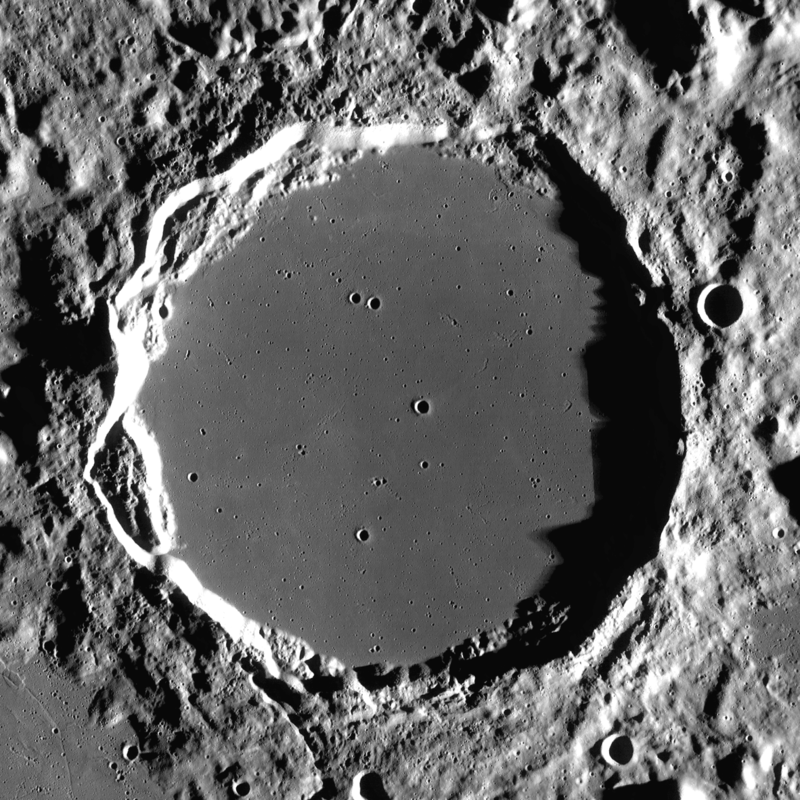 from Lunar Orbiter
from Lunar OrbiterPlato (crater), Mare Imbrium:
On the ledge atop the ringwall of Plato, Hansen teetered and tried to maintain his balance by pressing a gauntleted hand against an outcropping of gray Lunar rock. The thermal-eroded surface crumbled slightly beneath the metal-tipped mitten... H B Fyfe, Moonwalk (Space Science Fiction, November 1952).
The crater is the site of the Lunar Observatory in Clarke's Earthlight (1955):
The horizon was almost flat in all directions. Though the Observatory was at the centre of the great walled plain of Plato, the mountain ring was hidden by the curve of the Moon. It was a bleak and desolate prospect, without even a few hills to give it interest. Only a dusty plain, studded here and there with blow-holes and craterlets - and the enigmatic works of man, straining at the stars and trying to wrest away their secrets.
In the same book we are given an idea of the crater's ring-wall:
From space - or through a telescope on Earth - the walls of Plato look a formidable barrier when the slanting sunlight shows them to best advantage. But in reality they are less than a kilometre high, and, if one chooses the correct route through the numerous passes, the journey out of the crater and into the Mare Imbrium presents no great difficulty...
...He eased the vehicle forward, gingerly skirting a vast talus slope where splintered rock had been accumulating for millennia. Such slopes were extremely dangerous, for the slightest disturbance could often set them moving in slow, irresistible avalanches that would overwhelm everything before them. For all his apparent recklessness, Jamieson took no real risks, and always gave such traps a wide berth...
In The Lion of Comarre (Thrilling Wonder Stories, August 1949) by Arthur C Clarke, the crater is mentioned in passing:
"Who wants to go to the stars, anyway?"
The boy made an exclamation of annoyance and jumped off the diamond block in his excitement.
"What a question to ask in this age! A thousand years ago people were saying, 'Who wants to go to the Moon?' Yes, I know it's unbelievable, but it's all there in the old books. Nowadays the Moon's only forty-five minutes away, and people like Harn Jansen work on Earth and live in Plato City..."
In Poul Anderson's The Light (Galaxy, March 1957), the astronauts who think they are first on the Moon climb the ring-wall of Plato:
...There was an easy slope at the spot we picked and a kind of pass on top, so we didn't have to climb the full height, which is a little under 4000 feet.
- and make two discoveries inside the crater. The second one is stupendous. The first is merely amazing:
When we reached the summit, we could look down on a lava plain sixty miles across; the farther side was hidden from us. It seemed almost like polished black metal, crossed by the long shadow of the western ringwall. The downward grade was steeper, its base lost in darkness, but it could also be negotiated.
My helmet, sticking into the direct sunlight, was a Dutch oven; my feet, in the shade, were frozen clods. But I forgot all that when I saw the mist below me.
Have you heard of it? Astronomers have noticed it for a long time, what seemed to be clouds or - something - in some of the craters. Plato is one. I'd been hoping we'd solve the mystery this trip. And there, curling in ragged streamers a quarter mile below me, was the fog!
It boiled out of the murk, glowed like gold for a moment as it hit the light, and then it was gone, evaporated, but more came rolling up every minute...
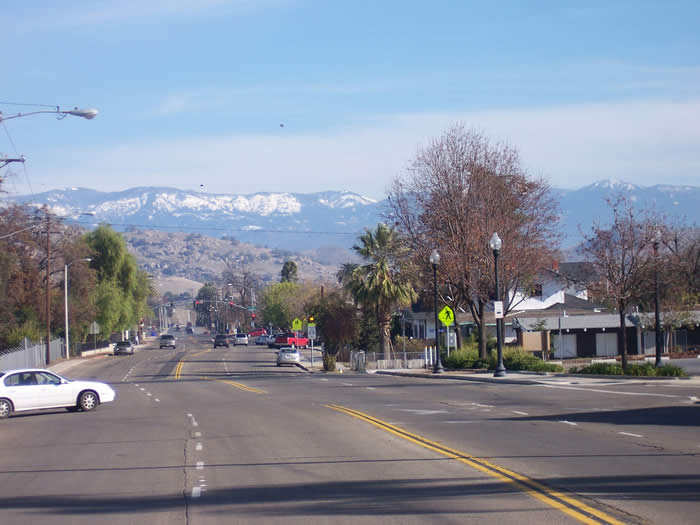
Porterville, California, USA:
George Christopher and his brother Ray drove down the highway towards Porterville. Lake Success lay on their right, high banks rose to the top of the ridgeline on their left. Rain fell steadily. Already the lake had risen nearly to the bridge where the highway crossed. Chunks of mud washed down from the ridge above and covered the road. The big farm truck went through the mud patches without slowing.
"Not much traffic," Ray said.
"Not yet." George drove grimly, his mouth a set line, his bull neck arched towards the steering wheel. "But it won't be long. All those people. They'll come up the road looking for high ground - "
"Most'll stop in Porterville," Ray said. "It's a couple of hundred feet higher than the San Joaquin."
"Was," George said. "With those quakes you can't tell. Land shifts, raises up and down. Anyway, when the dam goes, Porterville goes. They won't stay there..."
From Lucifer's Hammer (1977), the comet-strike disaster-epic by Larry Niven and Jerry Pournelle.
Potsdam, Brandenburg, Germany:
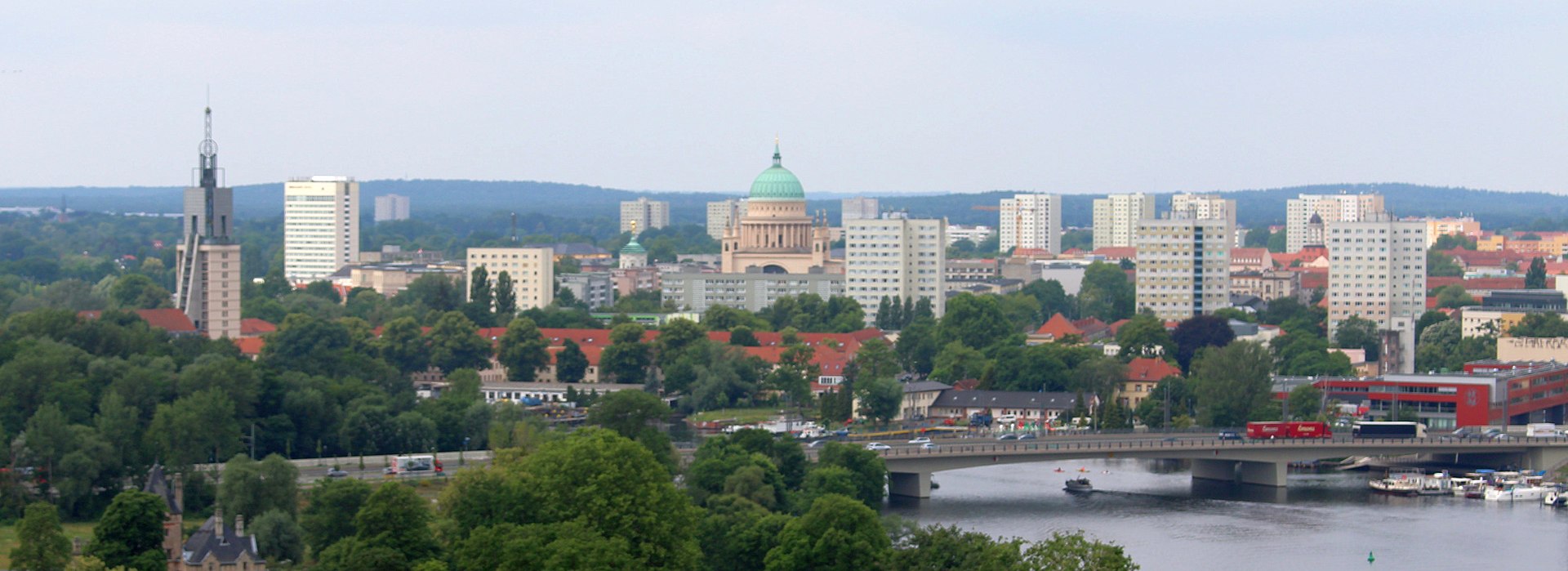
From Colin Wilson's The Mind Parasites (1967):
...Fleishman was also able to tell us about the Grau brothers, who were at present in Potsdam, their home. He had been able to contact them that morning, before reporters began jamming all out-going calls... They owed their safety to the accident of being telepathically linked. Just as they were able to use one another's minds as amplifiers for their PK powers, so they were able to draw upon one another's strength in their night battle...
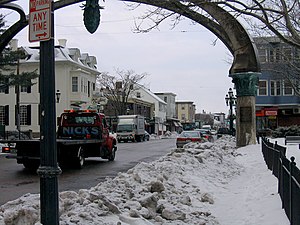 A street on Federal Hill: not quite the "spectral hump" HPL described, but still, better than nothing
A street on Federal Hill: not quite the "spectral hump" HPL described, but still, better than nothingProvidence, Rhode Island, USA:
This is H P Lovecraft's hometown; where he was born and where he is buried. Though the house where he was born (at 454 Angell Street) was demolished in the 1960s, there are still many Lovecraft links in Providence.
From The Haunter of the Dark (Weird Tales, December 1936):
Blake's study, a large southwest chamber, overlooked the front garden on one side, while its west windows - before one of which he had his desk - faced off from the brow of the hill and commanded a splendid view of the lower town's outspread roofs and of the mystical sunsets that flamed behind them. On the far horizon were the open countryside's purple slopes. Against these, some two miles away, rose the spectral hump of Federal Hill, bristling with huddled roofs and steeples whose remote outlines wavered mysteriously, taking fantastic forms as the smoke of the city swirled up and enmeshed them. Blake had a curious sense that he was looking upon some unknown, ethereal world which might or might not vanish in dream if he ever tried to seek it out and enter it in person...
References to Providence abound in Lovecraft's first masterpiece, The Call of Cthulhu (Weird Tales, February 1928) and his posthumously published novel The Case of Charles Dexter Ward (Weird Tales, May 1941 and July 1941).
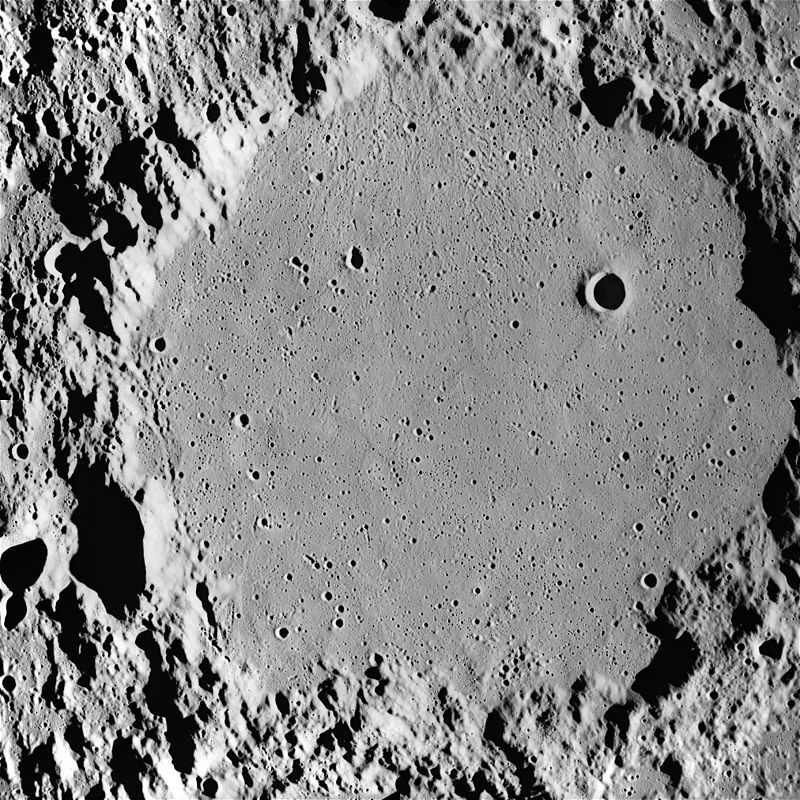 from Apollo 16
from Apollo 16Ptolemaeus (crater):
Site of the first moon-base, according to Timeliner by Charles Eric Maine.
I am going by what I wrote on the Fictional Dates page for 2029. However, to my embarrassment, I have not been able to find the reference in the book itself, though there is a mention on page 47 of one of the base's inhabitants, Bill Kyle, getting himself killed when a fall on to a jagged needle of rock in the Ptolemaeus mountains punctured his space suit and sucked the air from his lungs before he could connect the emergency oxygen feed.
Perhaps "the Ptolemaeus mountains" simply means the creater's ringwall.
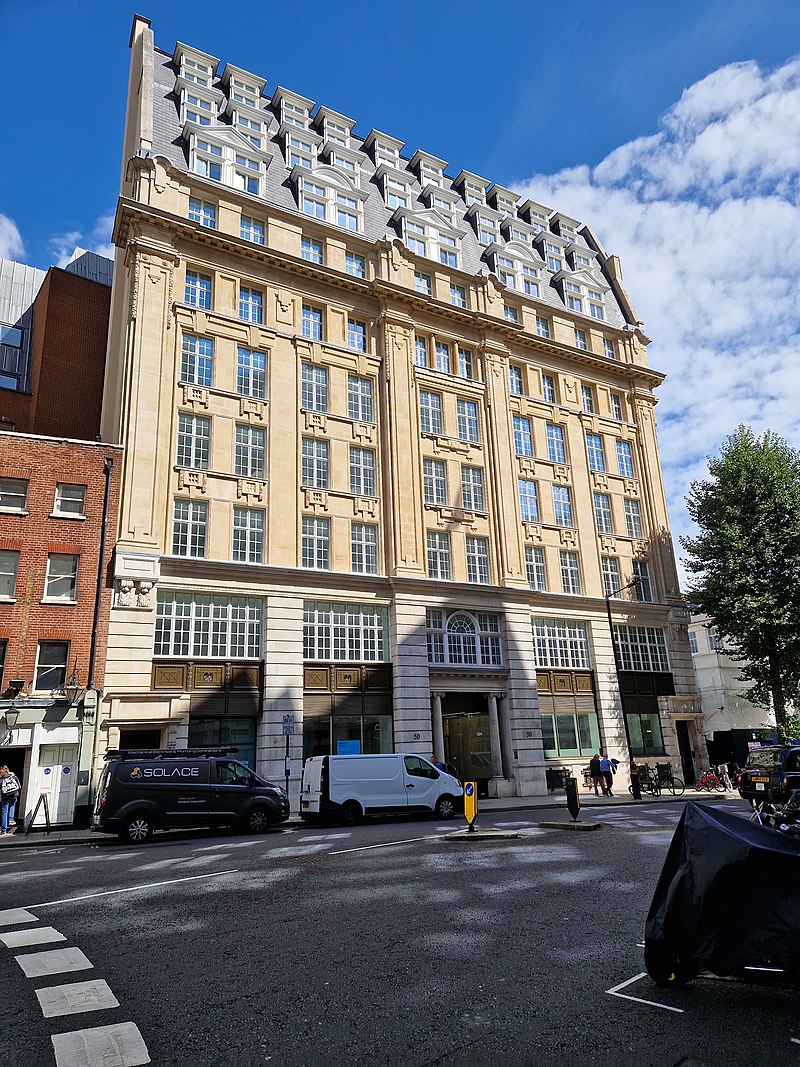 54 Broadway a.k.a Broadway Buildings: British Secret Service HQ, 1924-64
54 Broadway a.k.a Broadway Buildings: British Secret Service HQ, 1924-64the environs of Regent's Park, London, England:
...He shook the unfired bullets in the chamber of his gun into his cupped hand and laid them and the gun on the table. "See you Monday. Same time?"
"Ten o'clock'll be fine, sir," said the Instructor, jerking down the two handles on the iron door. He smiled at Bond's back as it disappeared up the steep concrete stairs leading to the ground floor. He was pleased with Bond's shooting, but he wouldn't have thought of telling him that he was the best shot in the Service. Only M. was allowed to know that, and his Chief of Staff, who would be told to enter the scores of that day's shoot on Bond's Confidential Record.
Bond pushed through the green baize door at the top of the basement steps and walked over to the lift that would take him up to the eighth floor of the tall, grey building near Regent's Park that is the headquarters of the Secret Service...
From Moonraker (1955) by Ian Fleming
[Note: the real SIS HQ at that time, Broadway Buildings (see picture), is closer to St James' Park than to Regent's Park]
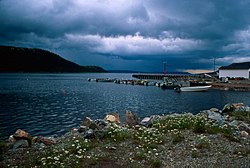
Rigolet, Labrador, Canada:
It's not surprising that the name has been shortened to "Rigo" in John Wyndham's post-apocalypse novel The Chrysalids (1955), set thousands of years in the future, when Labrador is one of the few places on Earth where what we today might call normal, un-mutated people can live (though the book calls into doubt whether "normal" is a term that can still meaningfully be used). One thing appears not to have changed: Rigo is still the capital of Labrador and the seat of executive authority. However, the state doesn't seem to be very powerful or centralised, while the level of technology has not recovered anywhere near pre-disaster levels; the people of Labrador havesteam power but no electric power.
...it was not only small children who lived in nervous awareness of the Fringes people not so far away. Their existence had become a dangerous nuisance and their depredations the cause of many representations to the Givernment in Rigo.
For all the good the petitions did, they might never have been sent. Indeed, with no one able to tell, over a stretch of five or six hundred miles, where the next attack would come, it is difficult to see what practical help would have been given...
Rima Hyginus - see Hyginus Cleft.
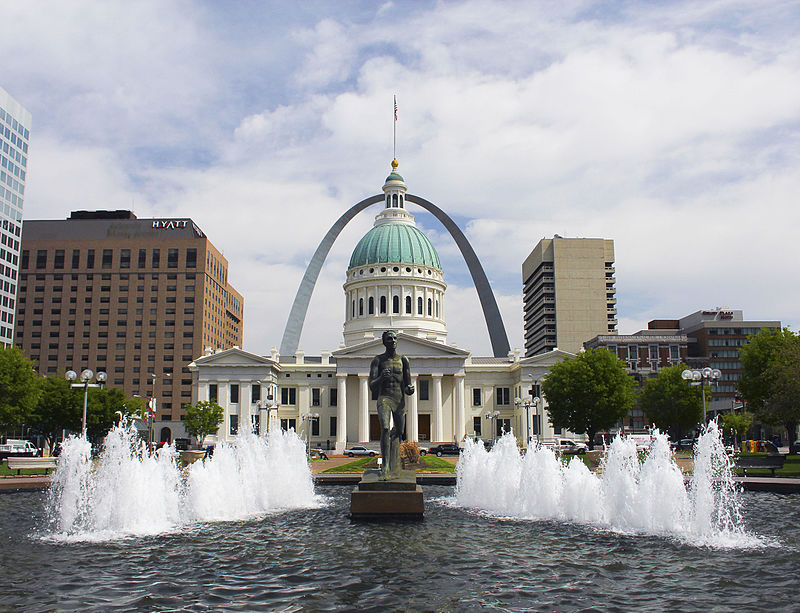
St. Louis, Missouri, USA:
The location of the provisional capital of the USA after the revolution which ousts the regime of the Prophet, in Robert A Heinlein's If This Goes On - (1940, 1953).
Temporary capital was set up at St Louis, for its central location... We took over the Prophet's proctor base there, restoring to it its old name of Jefferson Barracks. We took over the buildings of the University, too, and handed back to it the name of Washington. Of the people no longer recalled the true significance of those names, they soon would and here was a good place to start...
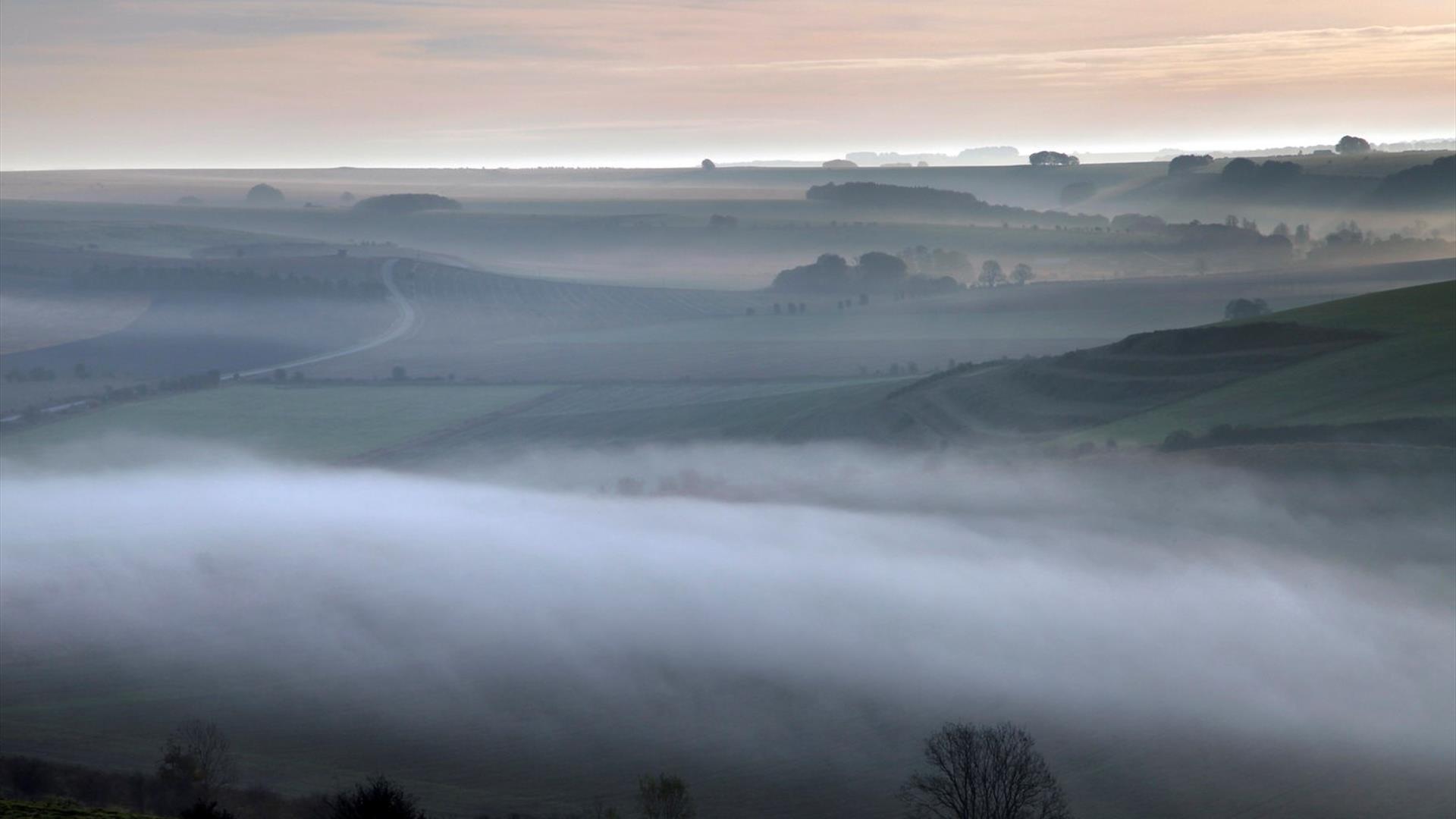
Salisbury Plain, (mostly in) Wiltshire, England:
The first Mars expedition - organized and led by a private
individual, millionaire adventurer Dale Curtance - takes off from this area, as narrated
in John Wyndham's Stowaway to Mars (1935). Chapter V, "Great Day", begins:
The
few hardy souls who had elected to spend the night upon the open
inhospitality of Salisbury Plain slept no later than dawn upon the
morning of the twelfth of October, 1981, for it was with the first rays
of sunlight that the influx which would last all day began.
The hysterical ballyhoo timed to reach its climax upon this day had
been sustained with an unsurpassed degree of journalistic art. The
birth of a son to Dale Curtance had given a fillip to interest at a
convenient moment, and every newspaper reader in the country had become
familiar with the, at present, somewhat dough-like features of Victor
Curtance. The announcement of the names of Dale's companions for the
flight had caught three unknown men and one rather more familiar figure
into an undying fulguration of publicity. Every person who could reach a
radio set had seen and heard a prince of the blood say: "I name this
ship the Gloria Mundi. May God guide her and bring safely back to us,"
and the film of the occasion had been shown at every cinema...
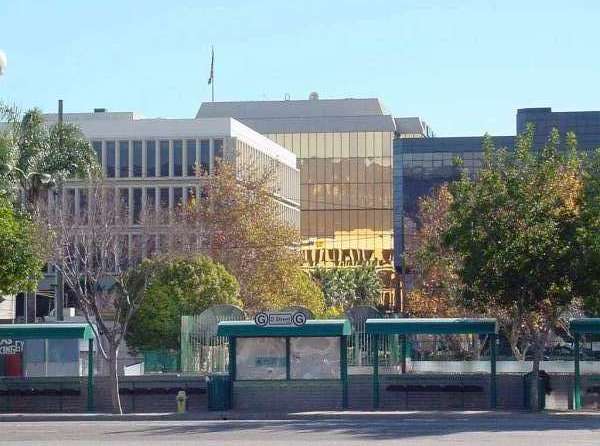
San Bernardino, California, USA:
An incident is remembered by one of the main characters in Larry Niven and Jerry Pournelle's Footfall (1985):
...It had happened several years before. Wes Dawson, two-term Congressman, stuck on the transportation safety subcommittee, interviewing bikers. He'd been young enough and new enough then to go out looking for information, rather than summoning the interested parties to Washington to testify to a committee.
And in a San Bernardino bar, Wes Dawson had let a Hell's Angel get his goat, and took a swing at the bloated barbarian, and was about to get his head stomped in, which would have been bad, and in the newspapers, which would have been worse, when Hairy Red the Minstrel made a joke of the whole affair and hustled Wes out of the bar...
 (the Bridge hadn't yet opened when CAS' tale appeared, but it would open later in the decade)
(the Bridge hadn't yet opened when CAS' tale appeared, but it would open later in the decade)San Francisco, California, USA:
A visit to a bookshop turns bad for Clark Ashton Smith's narrator in The Hunters From Beyond (Strange Tales, October 1932):
I have seldom been able to resist the allurement of a bookstore, particularly one that is well supplied with rare and exotic items. Therefore I turned in at Toleman's to browse around for a few minutes. I had come to San Francisco for one of my brief, biannual visits, and had started early that idle forenoon to an appointment with Cyprian Sincaul, the sculptor, a second or third cousin of mine, whom I had not seen for several years...
The little shop was empty of customers. Knowing my proclivities, the owner and his one assistant became tacitly non-attentive after a word of recognition, and left me to rummage at will among the curiously laden shelves. Wedged in between other but less alluring titles, I found a de luxe edition of Goya's 'Proverbes'...
It has always been incomprehensible to me that I did not shriek aloud with mindless, overmastering terror, when I happened to look up from the volume...
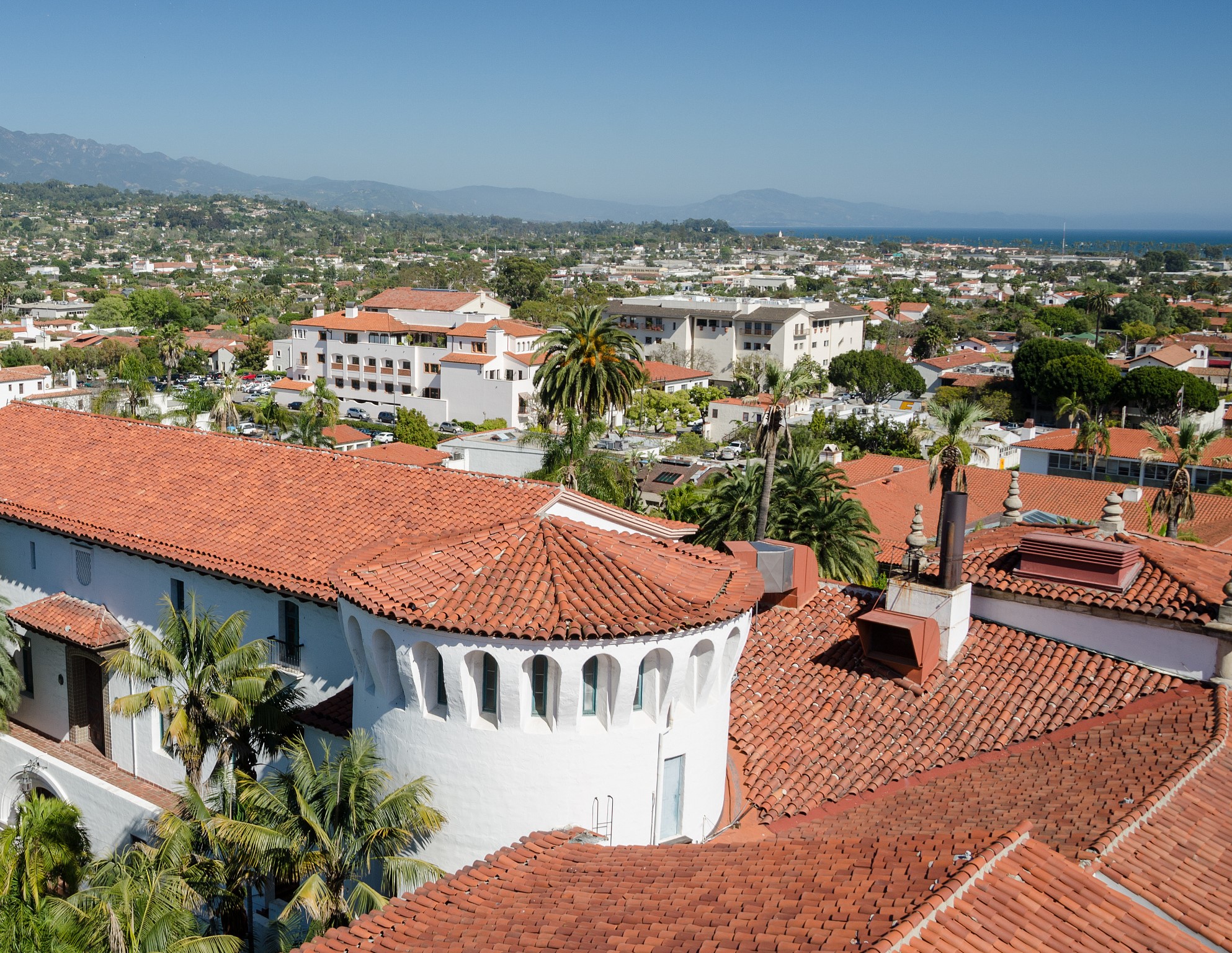
Santa Barbara, California, USA:
A genetically-engineered monstrosity lurks nearby in Watchers (1987), an sf/horror novel by Dean R Koontz, in which the 30-year-old heroine, Nora Devon, after a secluded upbringing by her repressive aunt Violet, has just begun to emerge into society.
...At the county courthouse she paused to admire the yellow blossoms of the yucca plants and the rich red bougainvillea that climbed the stucco wall and twined through the ornate wrought-iron grille over one of the tall windows.
At the Santa Barbara Mission, built in 1815, she stood at the foot of the front steps and studied the handsome facade of the old church. She explored the courtyard with its Sacred Garden and climbed the west bell tower.
Gradually, she began to understand why, in some of the many books she had read, Santa Barbara had been called one of the most beautiful places on earth. She had lived there nearly all her life, but because she had cowered in the Devon house with Violet and, on venturing out, had looked at little more than her own shoes, she was seeing the town for the first time. It both charmed and thrilled her...
Santa Fe, New Mexico, USA:
In Jack Williamson's Seetee Shock (1949, 1950) this is where the Treaty was signed that partitioned the Solar System - see the entry and quotation from the novel in the Fictional Dates timeline for 1987.
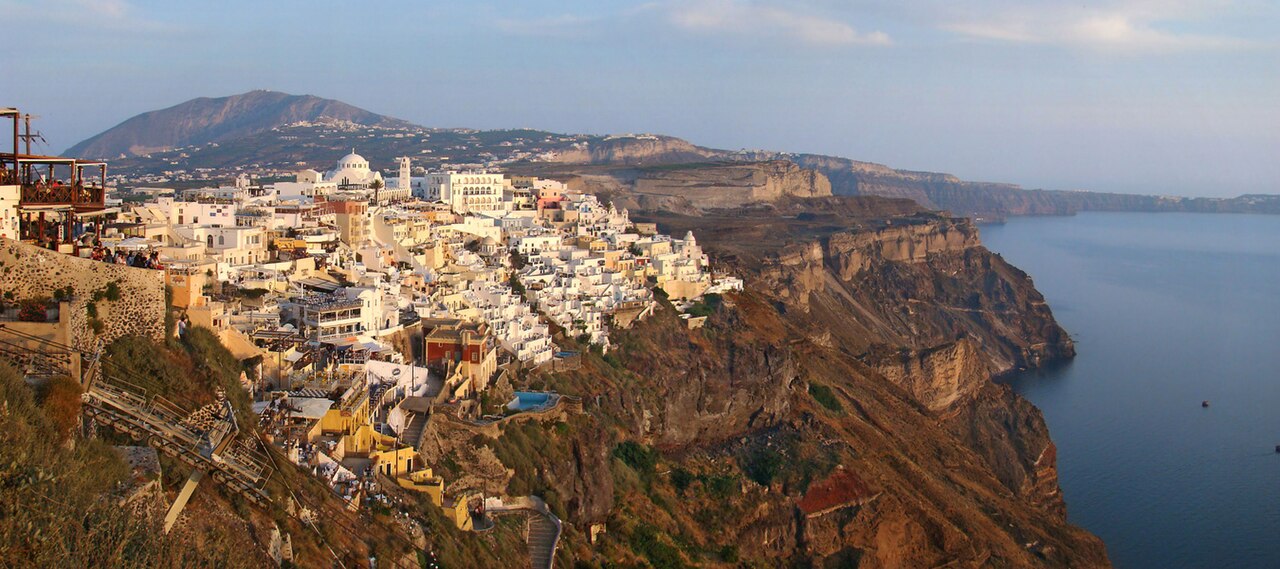
Santorini, Greece:
A comet-strike looms and a second doom for Thera/Santorini is imminent, in a scene from Niven and Pournelle's Lucifer's Hammer (1977):
Dusk faded on the waters of the bay far below. The bay was circular, surrounded by cliffs a thousand feet high, the caldera of a volcanic explosion that destroyed two thirds of the island, destroyed the Minoan Empire, created the legends of Atlantis. Now a new black island, evil in appearance and barren, rose in the centre of the bay. The Greeks called it the New Burnt Land, and the islands knew that some day it too would explode, as Thera had exploded so many times before.
Fiery streaks reflected in the bay. Something burned blue-white overhead. In the est the golden glow faded, not to black, but to a strange curdled green-and-orange glow, a backdrop for the meteors. Once again Phaeton drove the chariot of the sun...
Saratoga Springs, New York, USA:
The team fighting the "Mind Parasites" is allowed by President Lloyd C. Melville to move to "US Rocket Base 91" at Saratoga Springs, for reasons of security. See The Mind Parasites by Colin Wilson (1967).
...For the next two or three days, we spent most of the time in our hut, teaching our new pupils all we knew. Our telepathic powers made this easy. But we also came to recognize that we had overlooked one of the most important problems of phenomenology. When you teach a man that he has been completely mistaken about his own nature all his life, it is as unsettling as suddenly giving him a million pounds...
Schröter (crater), Mare Insularum:
For a site in the environs of Schröter W, see Gruithuisen's Lunar City.
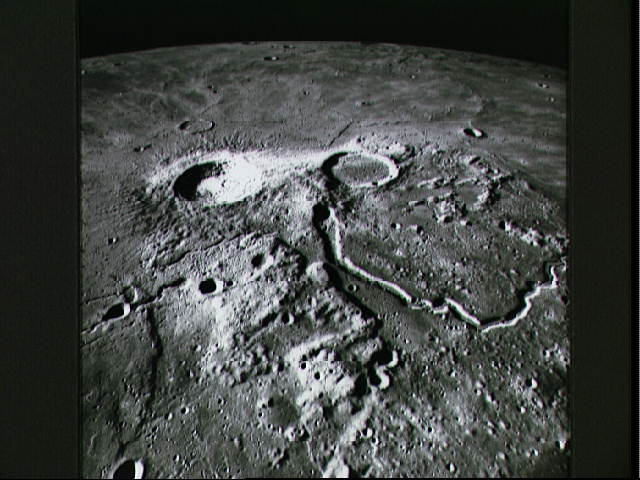 from Apollo 15
from Apollo 15Schröter's Valley:
Arthur C Clarke, writing about lunar plant life in his travelogue-of-the-future Journey By Earthlight - an essay to be found in his collection The Challenge of the Spaceship (1958) - discusses what he calls "Herodotus Valley", by which, so far as I can tell, he must mean Schroeter's (the crater Herodotus being 'next door').
...Most of the existing vegetation is found in the neighbourhood of the great lunar clefts, such as the Herodotus Valley, for traces of carbon dioxide, water vapour and sulphur dioxide occasionally gush out of these fissures - sometimes producing short-lived mists which are visible from Earth. These precious gases are eagerly trapped by the slender, cactuslike plants...
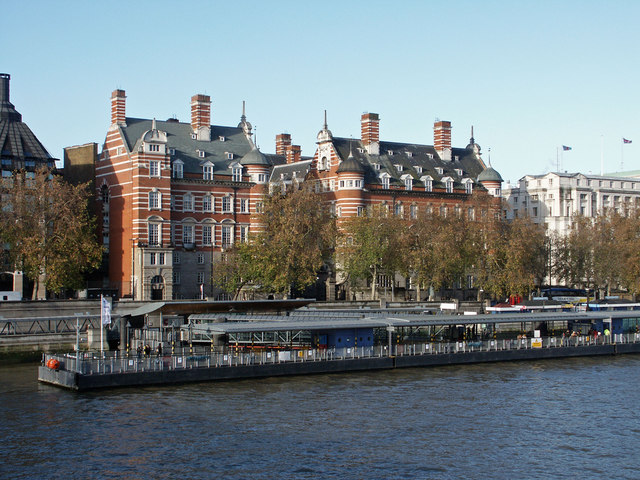
Scotland Yard, Victoria Embankment, London, England:
James Bond reflects on his appointment with Assistant Commissioner Vallance of the Metropolitan Police, in Moonraker (1955):
The courtyards and cul-de-sacs of the Yard had reminded him as usual of a prison without roofs. The overhead strip lighting in the cold corridor took the colour out of the cheeks of the police sergeant who asked his business and watched him sign the apple-green chit. It did the same for the face of the constable who led him up the short steps and along the bleak passage between the rows of anonymous doors to the waiting-room.
A quiet, middle-aged woman with the resigned eyes of someone who had seen everything came in and said the Assistant Commissioner would be free in five minutes...
Siberia:
This huge region figures strongly though indirectly (no scenes are actually set there) in the post-nuclear-holocaust novel Twilight World (1981) by Poul Anderson. Siberia "...set itself up as independent when the old Russian government vanished. Not being too badly hurt, and having a certain amount of industry, an energetic population, and plenty of natural resources, it came back fast - as fast as we, if not more so. It's annexed Manchuria, you can see, and Mongolia and Korea; Japan is its puppet, as are several of the North Chinese states. We don't know a great deal about it, international communication is still pretty slim, but it's a hardboiled outfit, and its Khan - well, you can learn about that later on..."
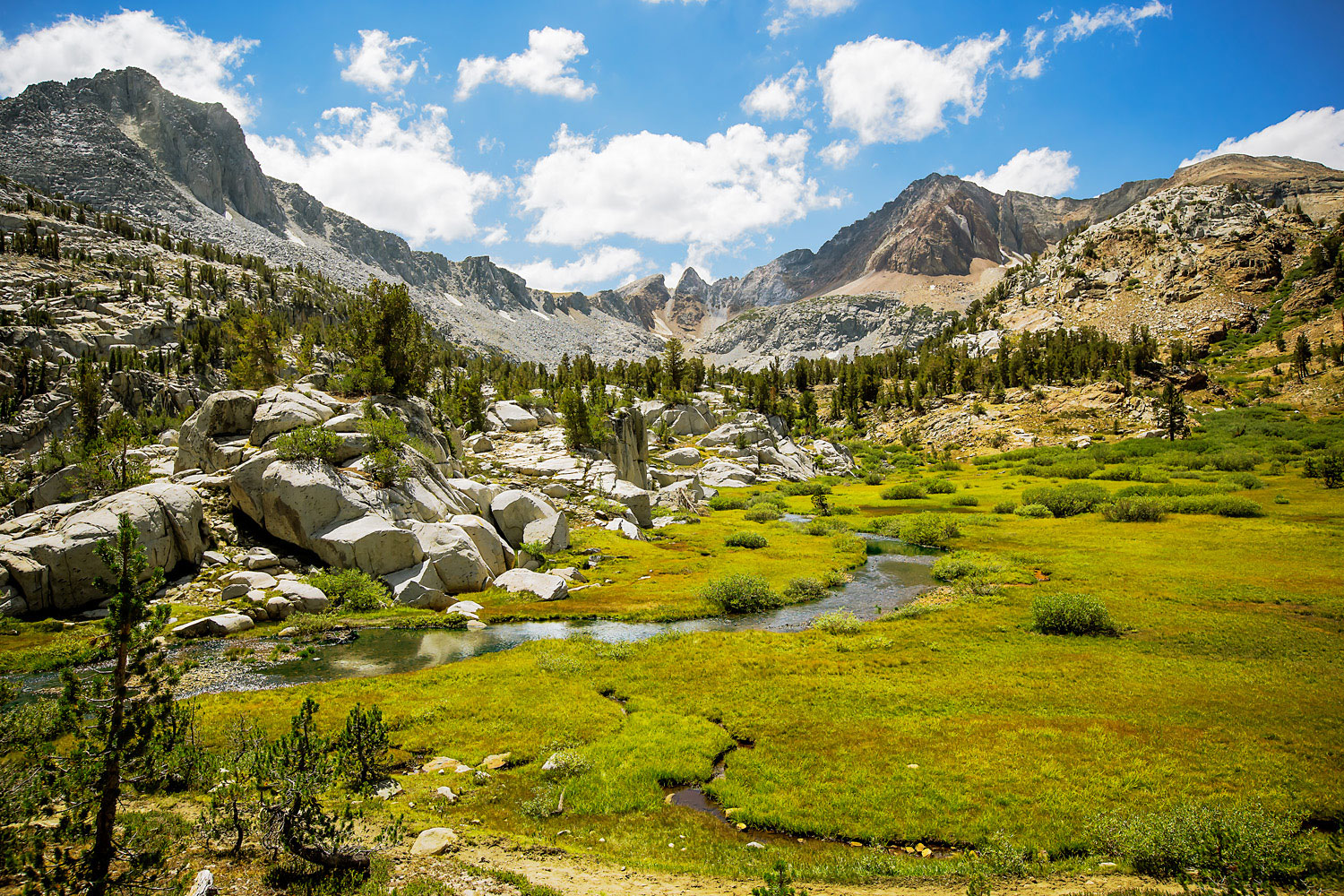
the Sierra Nevada, California, USA:
Scene of the visitation by beings from a higher dimension who need an infusion of earthier reality, in the haunting tale The Light From Beyond by Clark Ashton Smith (Wonder Stories, April 1933):
...I had decided to spend a whole year in the high Sierras. On the shore of a tiny sapphire tarn, in a valley sheltered by hemlocks and granite crags, I had built a rough cabin and had stocked it plentifully with provisions, books, and the materials of my art. For the time being, I was independent of a world whose charms and enchantments were, to say the least, no longer irresistible.
The region possessed, however, other allurements than those of seclusion. Everywhere, in the stark mountain masses and pinnacles, the juniper-studded cliffs, the glacier-moulded sheets of rock, there was a mingling of grandeur and grotesquery...
Silver City, Idaho, USA:
From Sinister Barrier (1939) by Eric Frank Russell:
Silver City was gone; the area it once had occupied was now an enormous scar on the face of Idaho, a five-miles-wide wound dotted with wreckage through which crept, crawled and limped a pathetically small number of survivors...

Sinus Iridum:
...As they rolled past the headland, the mighty northern wall of the Sinus Iridum - the Bay of Rainbows - swept into view. Aeons ago the Sinus Iridum had been a complete ring mountain - one of the largest walled plains on the Moon. But the cataclysm which had formed the Sea of Rains had destroyed the whole of the southern wall, so that only a semicircular bay is now left. Across that bay Promontory Laplace and Promontory Heraclides stare at each other, dreaming of the day when they were linked by mountains...
Wheeler was very quiet as the tractor rolled past the great cliffs, which stood like a line of titans full-face towards the Earth. The green light splashing down their flanks revealed every detail of the terraced walls...
Arthur C Clarke, Earthlight (1955)
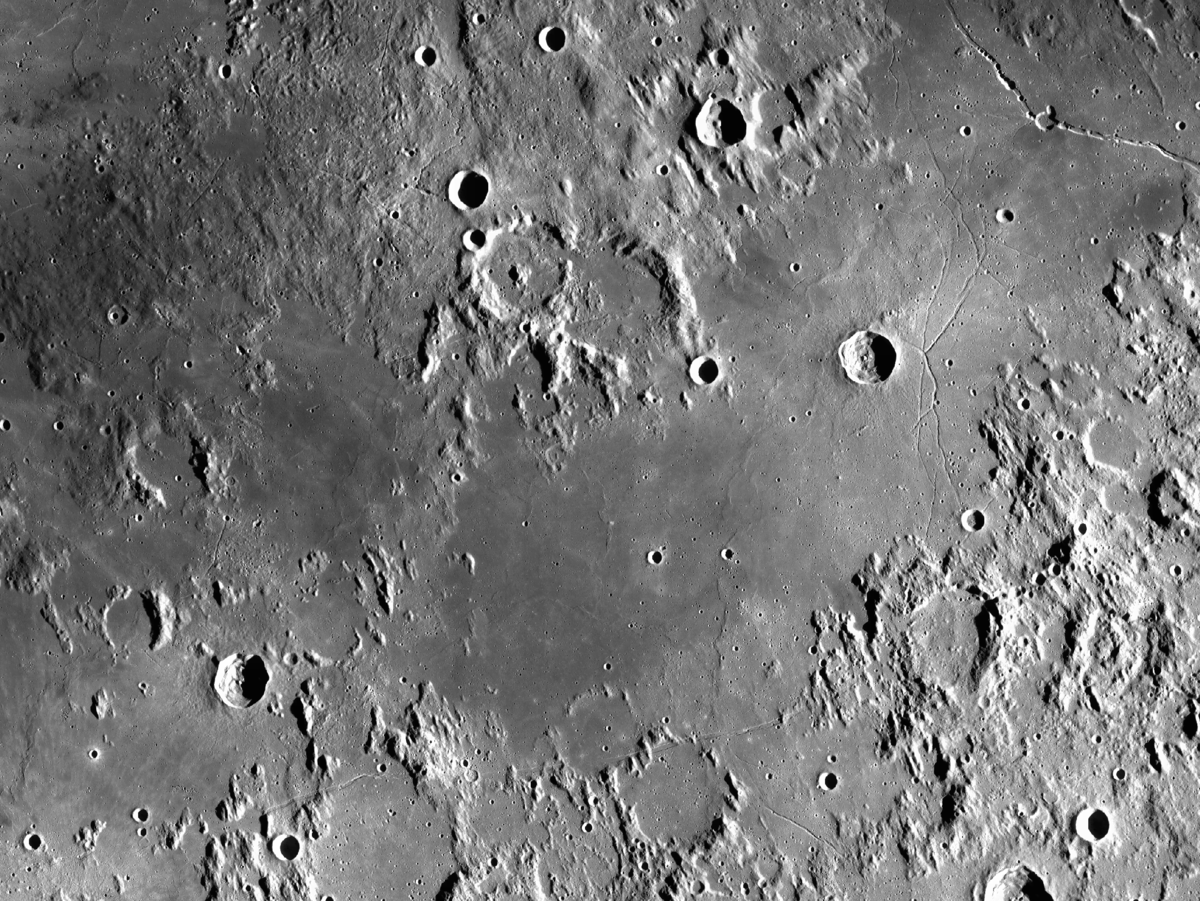
Sinus Medii:
Location of Central City, metropolis of the lunar colony, in Arthur C Clarke's Earthlight (1955).
...The cluster of great domes began to hump themselves over the horizon. A beacon light burned on the summit of each, but otherwise they were darkened and gave no sign of life. Some, Sadler knew, could be made transparent when desired. All were opaque now, conserving their heat against the lunar night.
The monocab entered a long tunnel at the base of one of the domes. Sadler had a glimpse of great doors closing behind them - then another set, and yet another. They're taking no chances, he thought to himself...
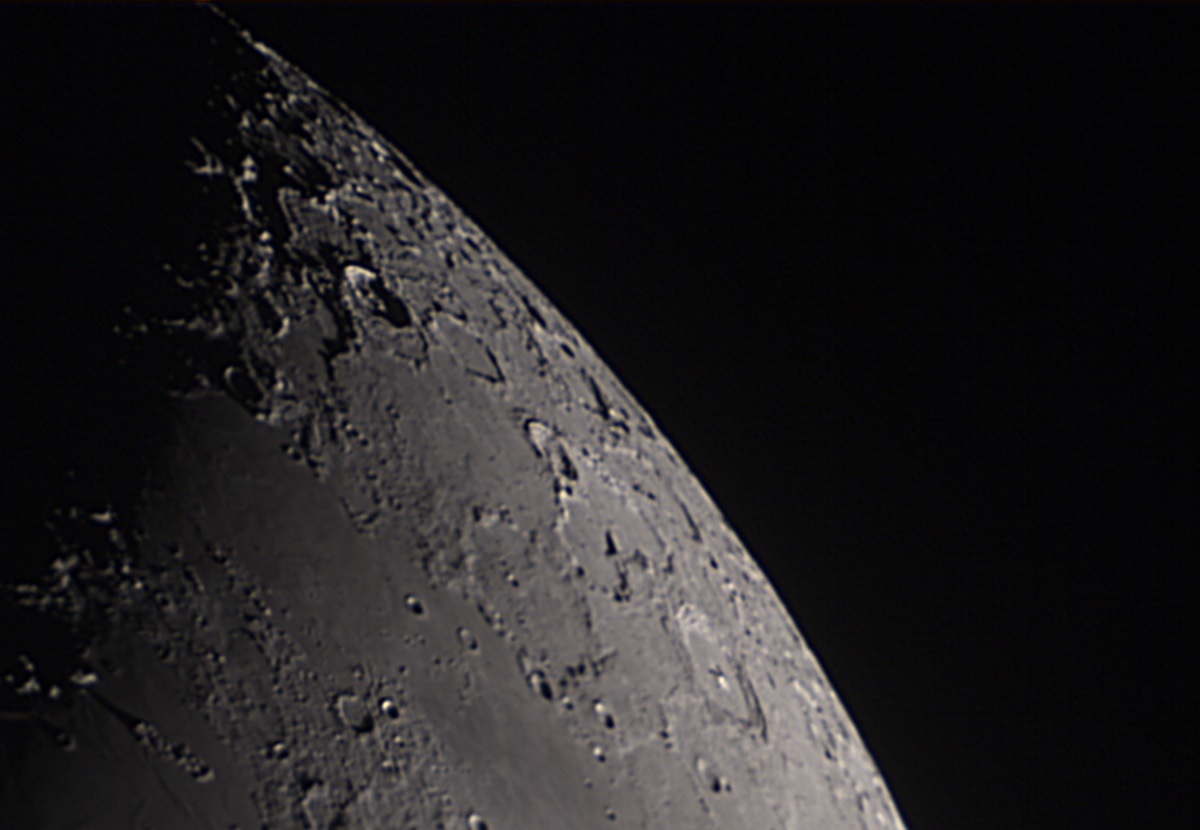
Sinus Roris
The "Bay of Dew", a northern extension of the Oceanus Procellarum, is the location of the fictional dust-bowl called the "Sea of Thirst" in Arthur C Clarke's A Fall of Moondust (1961).
...Selene surged forward. For the first time there was a real sensation of speed. The boat's wake became longer and more disturbed as the spinning fans bit fiercely into the dust. Now the dust itself was being tossed up on either side in great ghostly plumes; from a distance, Selene would have looked like a snowplough driving its way across a winter landscape, beneath a frosty moon. But those grey, slowly-collapsing parabolas were not snow, and the lamp that lit their trajectory was the planet Earth.
The passengers relaxed, enjoying the smooth, almost silent ride...
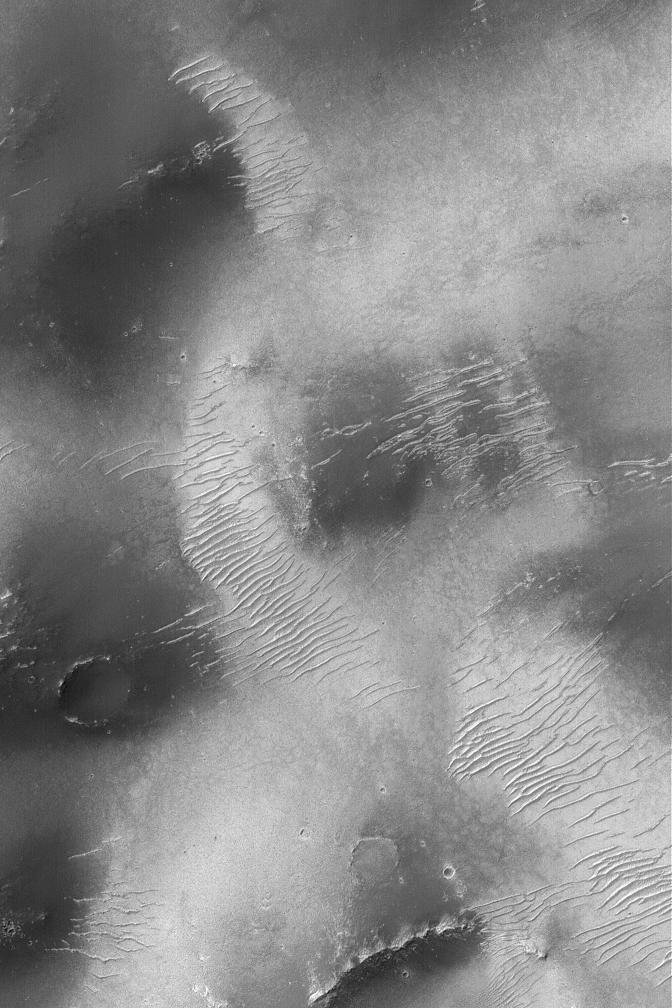
Sinus Sabaeus, Mars:
Home of the detective (a seven-foot biped of vaguely stork-like appearance) in The Martian Crown Jewels by Poul Anderson.
...The city lay gray and quiet; the sun was slipping westward over the farmlands of Sinus Sabaeus and the desert of the Aeria; he could just make out the rumble of a treadmill cart passing beneath the windows - and he sat here with a story which could blow the Solar System apart!
His hands, gloved against the chill, twisted together. "Yes, it's confidential, all right. If you can solve this case, you can just about name your own fee." The gleam in Syaloch's eyes made him regret that, but he stumbled on...
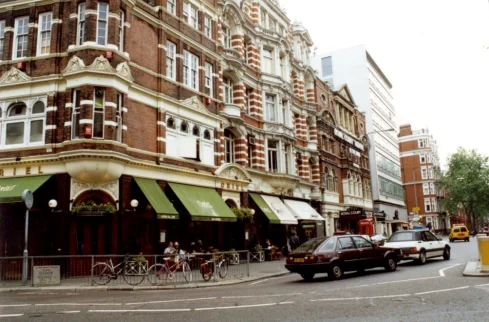 Couldn't find a pic from the 1950s so the '90s will have to do...
Couldn't find a pic from the 1950s so the '90s will have to do...Sloane Square, Chelsea, London, England:
On the way to Blades Club for an encounter at cards with the vulgar and sinister Hugo Drax, James Bond glimpses a curious portent in the heavens. From chapter III of Moonraker (1955) by Ian Fleming:
Startled at the great crimson words, Bond pulled in to the curb, got out of the car and crossed to the other side of the street to get a bigger view of the big skysign.
Ah! That was it. Some of the letters had been hidden by a neighbouring building. It was only one of these Shell advertisements. 'SUMMER SHELL IS HERE' was what it said.
Bond smiled to himself and walked back to his car and drove on.
When he had first seen the sign, half-hidden by the building, great crimson letters across the evening sky had flashed a different message.
They had said: 'HELL IS HERE... HELL IS HERE... HELL IS HERE.'
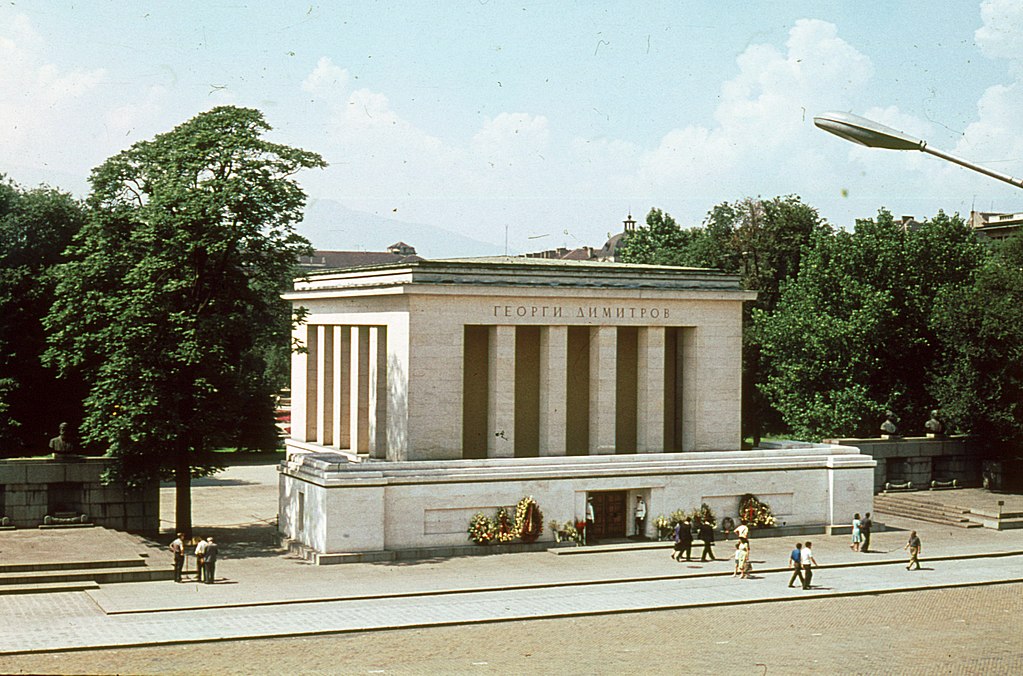 the Dimitrov mausoleum (destroyed in 1999)
the Dimitrov mausoleum (destroyed in 1999)Sofia, Bulgaria:
In The Doomsday Brain (1967) by Paul Tabori, the Hunters on the track of evil mastermind Bruno Gatterer follow a trail that leads here.
Outside the mausoleum of Georgi Dimitrov the two sentries stood like wax figures. Their uniforms were straight from the heyday of Viennese operetta with a lot of braid, polished top-boots, feathered caps; more than somewhat incongruous in the capital of a Socialist Peoples' Republic. They stood without any visible movement, their rifles at rest, probably self-hypnotised into lifeless rigidity. The tomb was guarded by two such "living statues" day and night, twenty-four hours a day, in rain and shine, frost or heat wave. Old Georgi who had won world fame when he stood up to the bullying of Hermann Goering at the Reichstag fire trial - and got away with it - died in Russia, rather unexpectedly; perhaps his Russian comrades slightly hastened his demise for his was a brand of National Communism which Stalin did not relish. However, his body was carried in state on the shoulders of the leaders of International Marxist-Leninism and in due course returned to Bulgaria - to provide the central piece of the mausoleum which the two sentries guarded with such perfect imitation of garden sculpture...
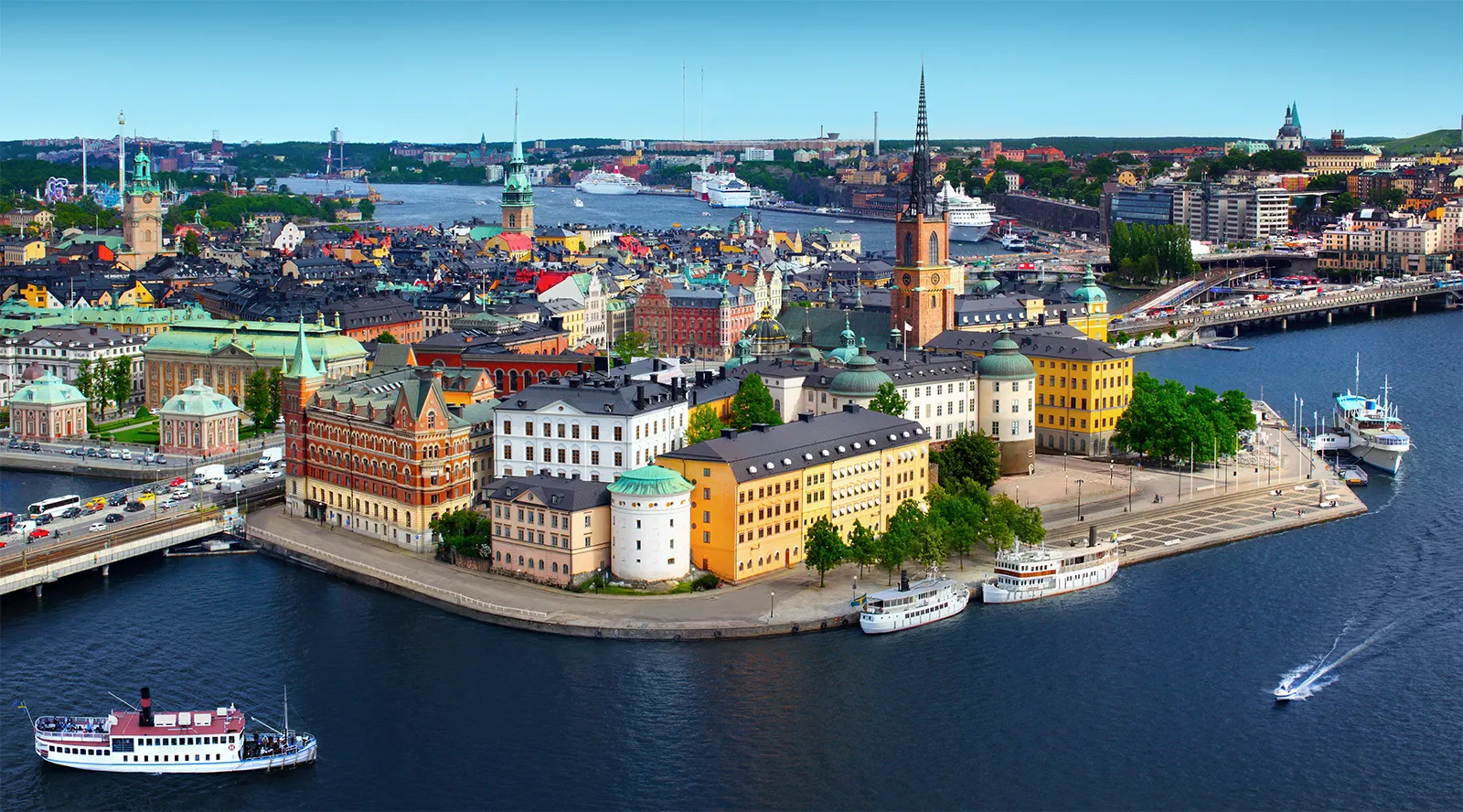
Stockholm, Sweden:
From Keith Laumer's Worlds of the Imperium (1962):
He had been following me all day.
At first I thought it was coincidence when I noticed the man on the bus from Bromma, then studying theatre announcements in the hotel lobby while I registered, and half an hour later sitting three tables away sipping coffee while I ate a hearty dinner.
I had discarded the coincidence theory a long time ago. Five hours had passed and he was still with me as I walked through the Old Town, medieval Stockholm still preserved on an island in the middle of the city. I had walked past shabby windows crammed with copper pots, ornate silver, dueling pistols, and worn cavalry sabres; they were all very quaint in the afternoon sun, but grim reminders of a ruder day of violence after midnight...

Stonehenge, Wiltshire, England:
This site resonates in many tales.
The time-traveller Malcolm Lockridge has a hand in founding the monument, as described in Poul Anderson's The Corridors of Time (1965):
...meanwhile he made alliance - with the axmakers of Langdale Pike, the settlers along the Thames, even the dour downland farmers, whom he persuaded that manslaughter was not pleasing to the gods. Now today they spoke of erecting a great temple on Salisbury Plain, as the sign and seal of their confederation...
The time-viewing mental pioneer Howard Lester in Colin Wilson's The Philosopher's Stone (1969) approaches the stone circle from the present and finds it disturbing:
The sensations were so strong when we pulled up opposite Stonehenge that I let Littleway buy the tickets, while I crossed the road towards the stones. It was a quite indescribable sensation. If I were trying to represent it in a film, I should use a curious, menacing vibration. But that would be to simplify it. In a sense, it was more like a smell, picked up by some inner sense, a smell of time...
For the narrator of Keith Laumer's A Trace of Memory (1963) - playing sidekick to the mysterious "Foster" - a more violent surprise awaits during a night visit to a hollow close to the site of the stones:
The surface of the ground before us seemed to tremble, then heave. Foster snapped on his flashlight. The earth at the bottom of the hollow rose, cracked open. A boiling mass of luminescence churned, and a globe of light separated itself, rose, bumbling along the face of the weathered stone...
What the technophobic population have learned to call the "Stones of the Sanctuary" in John Christopher's post-disaster novel The Prince in Waiting (1970) turn out to have a hidden base of secret technologists beneath them:
...They stood like jagged teeth on the skyline; tiny but, being miles away still, having the promise of enormity. The promise or the threat... There had been vague thoughts of the High Seers, of Seances, but nothing concrete, nothing, really, that meant anything. Those distant pillars were real, and foreboding. They were surrounded by empty downland, cropped only by rabbits. No man would go near, no shepherd graze his flocks in their shadow. It was the place of the High Seers, dread and holy, and that dread touched me, making me want to turn back to the world of men...
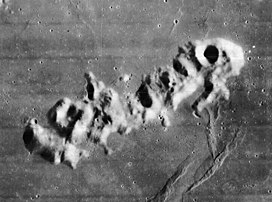 from Lunar Orbiter 4
from Lunar Orbiter 4the Straight Range (= Montes Recti):
Two astronomers from Plato Observatory decide during their free time to go exploring by turbine-driven lunar tractor, in Earthlight (1955) by Arthur C Clarke:
For the next three hours they crawled along the flanks of the Teneriffe Mountains, then struck out across the plain to the Straight Range, that lonely, isolated band of mountains like a faint echo of the mighty Alps. Jamieson drove now with a steady concentration; he was going into new territory and could take no chances...
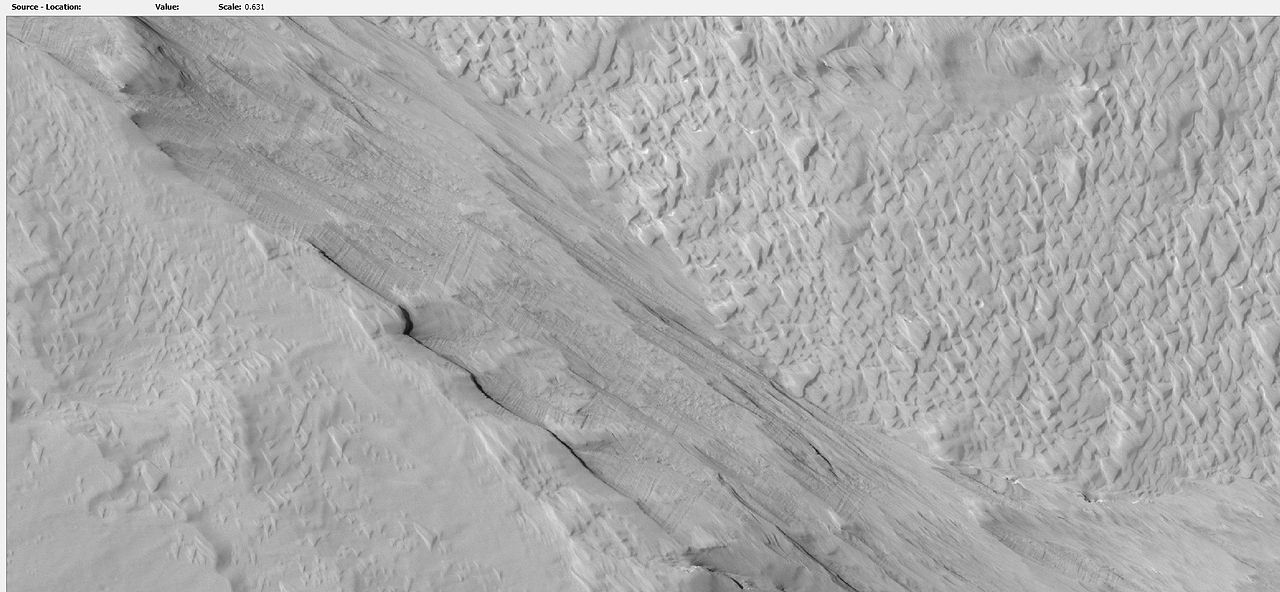 it's something that runs straight anyway - the best I could do
it's something that runs straight anyway - the best I could doStrymon canal, Mars:
The opening scene in Red Planet (1949), by Robert A Heinlein, is set in a colony in this area.
...Buildings had not even view windows, any more than a modern building in New York has. The surrounding desert, while beautiful, is monotonous. South Colony was in an area granted by the Martians, just north of the ancient city of Charax - there is no need to give the Martian name since an Earthman can't pronounce it - and between the legs of the double canal Strymon. Again we follow colonial custom in using the name assigned by the immortal Dr Percival Lowell...
[Note: Strymon, though non-existent, is locatable in, or somewhat west of, Amazonis Planitia (see Linking Lowell's Mars with the standard map).]
[Later note: or maybe much further west than Amazonis, if you have to subtract the old longitude from 360 rather than use it directly - see note after "Aetheria". Anyhow, I'll leave the picture for the entry as it is, since I quite like its canal-like appearance.]
Sussex, England:
See Locations for The Day of the Triffids.
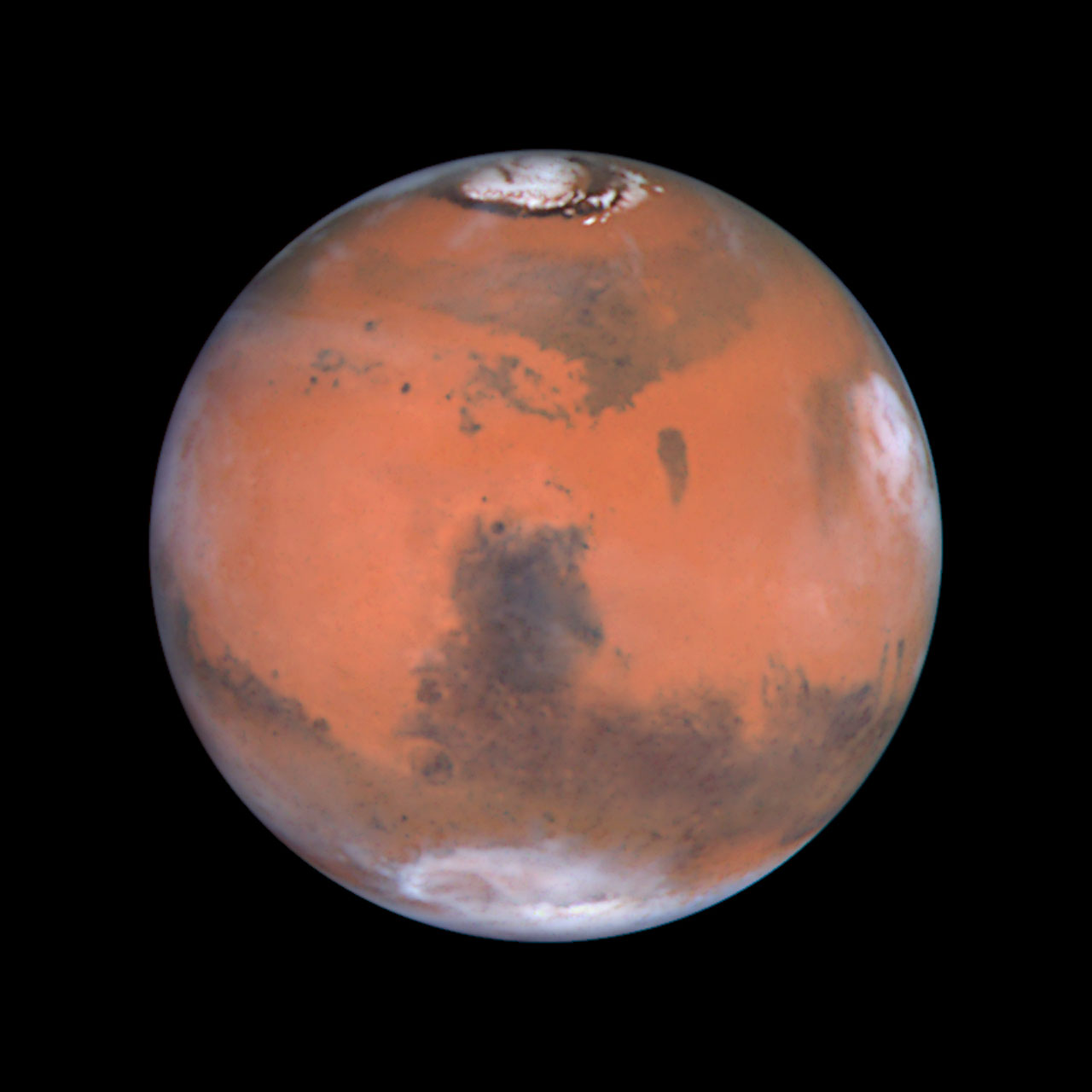 stands out well in the middle of this Hubble Space Telescope image
stands out well in the middle of this Hubble Space Telescope imageSyrtis Major:
According to Wikipedia this was "the first documented surface feature of
another planet. It was discovered by Christiaan Huygens, who included it
in a drawing of Mars in 1659." A venerable record! Syrtis, I thought, meant "bog", which would make the feature a "big bog", but looking up the word online I find it means "quicksand". (I must have been misled by Milton's "boggy Syrtis" traversed by Satan in Paradise Lost.)
"Syrtis Major" is such an old appellation and the feature itself so prominent, it's not surprising it tends to be a default choice amongst sf writers who seek the name of a location on Mars. Master of the Asteroid (Wonder Stories, October 1932) by Clark Ashton Smith.
is a classic early tale of interplanetary exploration which on its first page states that ...in 1980, a dozen voyages had been made to Mars, and a rocket base had
been established in Syrtis Major, with a small permanent colony of
terrestrials, all of whom were trained scientists as well as men of
uncommon hardihood and physical stamina...
The name of the feature gets into the name of the story in Poul Anderson's Duel on Syrtis (Planet Stories, March 1951). Riordan, a ruthless Terran hunter who wishes to "bag a Martian", is watched by his intended target, Kreega, who
...sat in a cave, looking down past a tortured wilderness of sand and bush and wind-carved rock, miles in the thin clear air to the glitter of metal where the rocket lay. The man was a tiny speck in the huge barren landscape, a lonely insect crawling under the deep-blue sky... Weak pallid sunlight spilled over rocks tawny and ocherous and rust-red, over the low dusty thorn-bushes and the gnarled little trees and the sand that blew faintly between them. Equatorial Mars!
Tampa, Florida, USA:
The state's outline has changed drastically in Keith Laumer's Catastrophe Planet (1966):
Tampa was a reeking ruin, a seaport town miles from the sea, surrounded by a bog of grey mud left high and dry by the freakish withdrawal of the Gulf...
Tarzana, California, USA:
From Larry Niven and Jerry Pournelle's invasion-epic Footfall (1985):
Tarzana didn't have electricity. Ken Dutton and his guests stayed outdoors. Light came from the bellies of the clouds, reflected from wherever the Los Angeles and San Fernando Valleys still had electricity. Occasionally a guest would go inside, feeling his way through the darkness toward the flickering light from the bathroom. At the next Stone Soup party there would probably be no candles at all...
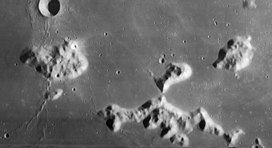
Teneriffe Mountains:
From Earthlight (1955) by Arthur C Clarke:
They came to a halt on a high escarpment overlooking the plain. Directly ahead, notching the horizon, was the pyramidal summit of Pico. Towards the right, sinking down into the north-east, were the more rugged peaks of the Teneriffe Mountains. Very few of those peaks had ever been climbed, largely because no one had so far bothered to attempt it. The brilliant earthlight made them appear an uncanny blue-green, constrasting strangely with their appearance by day, when they would be bleached into raw whites and blacks by the merciless sun...
Terre Haute, Indiana, USA:
Birthplace of Paul Janus Finnegan, alias Kickaha - see Philip Jose Farmer's World of the Tiers series.
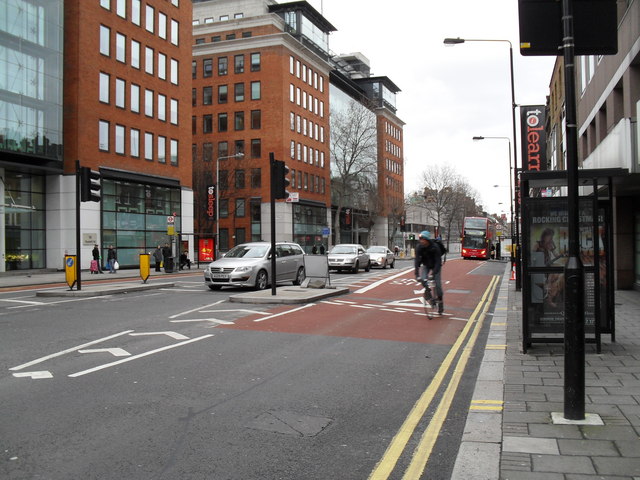
Theobalds Road, Holborn, London, England:
The scene of a crisis-briefing in Hugh Walters' The Last Disaster (1978), in which the Moon leaves its orbit and begins to spiral inward towards the Earth.
...Security for the London meeting was unobtrusive but effective. The gathering was held in the former Air Ministry Building in Theobalds Road...
[Personal note: during 1980-87 I worked in this area; every morning I walked down Theobalds Road to turn into Bedford Row for the Printing Federation.]
Thera, Greece: See Santorini.
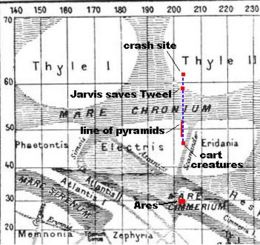 (South is up)
(South is up)Thyle II:
This is the region where Dick Jervis crash-lands one of the auxiliary rockets in which he had set out from the parent ship Ares to photograph some of the landscape of Mars, as narrated in A Martian Odyssey by Stanley Weinbaum (Wonder Stories, July 1934). Those were the days when you could believe in exploration worthy of the name:
"...I started losing altitude right away, and suddenly there I was with a thump right in the middle of Thyle! ... the bump flattened the landing-gear and busted off the under-jets... I had my choice of waiting to be picked up or trying to walk back - eight hundred miles... I chose to walk... Just as much chance of being picked up, and it kept me busy."
"We'd have found you," said Harrison.
"No doubt. Anyway, I rigged up a harness from some seat straps, and put the water tank on my back, took a cartridge belt and revolver, and some iron rations, and started out..."
Tijuana, Baja California, Mexico:
Much of Philip K Dick's Now Wait For Last Year (1966) takes place in this city in the year 2055. Tijuana Fur & Dye was established as the receiving plant for furs created by exploiting the capacity for mimicry of the "Martian print amoeba". It had broken the natural fur market. Then war intervened.
As soon as hostilities with the reegs had begun, Tijuana Fur & Die had converted from the luxury trade of ersatz fur production to war work... Supernaturally accurate duplication of rocketship master syndromes, the ruling monad Lazy Brown Dog, was fatalistically natural for the type of operation which TF&D represented; conversion had been painless and rapid...
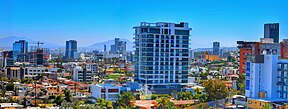
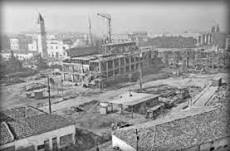 in 1960
in 1960Tirana, Albania:
From Paul Tabori's The Doomsday Brain (1967):
There were only three people who got off the small Rumanian plane at Tirana, the overgrown village that called itself the capital of the Albanian Peoples' Republic. The other passengers, continuing to Bucharest, were guarded by a platoon of soldiers with automatic rifles at the ready as if their very presence on the tarmac might threaten the security of Enver Hoxha's country...
Topeka, Kansas, USA:
Birthplace (in 2093) of Gil Hamilton - see The Long ARM of Gil Hamilton (1976), by Larry Niven.
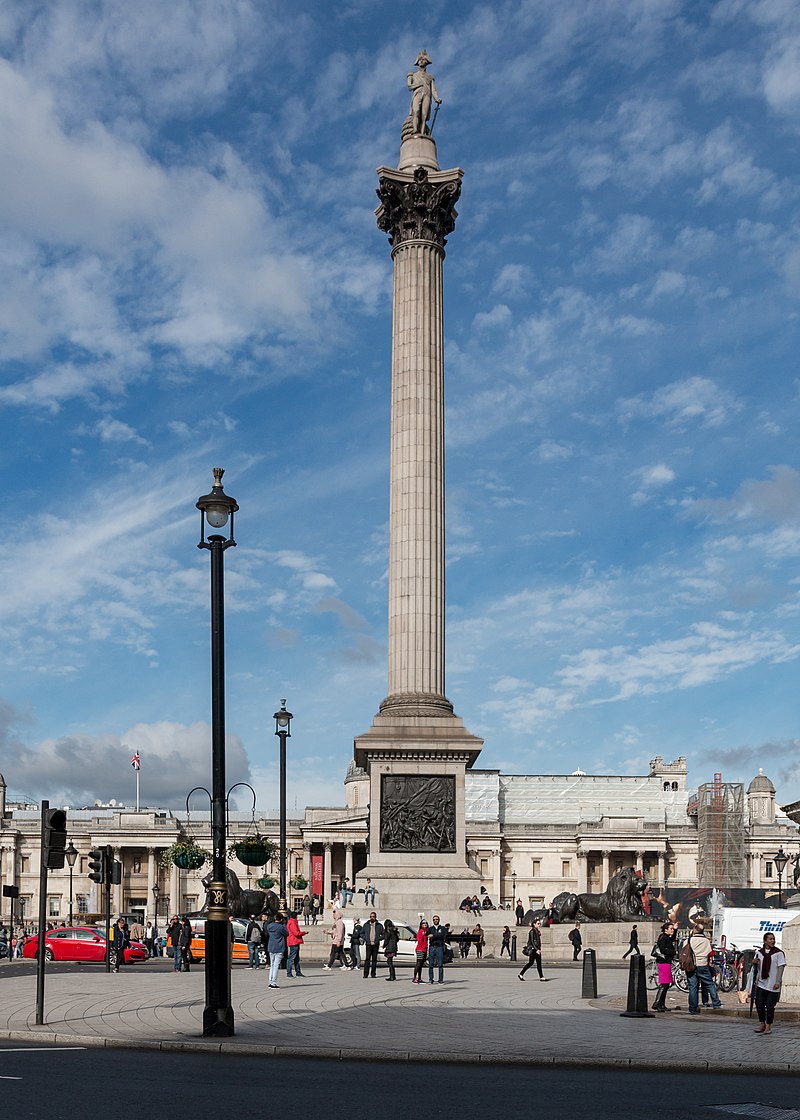
Trafalgar Square, London, England:
In the version of 1990s London portrayed by Dan Morgan in The Country of the Mind (1975), in which airborne cabs fly about the capital,
Nelson's Column loomed briefly in the right hand window as the cab dropped out of the traffic pattern and made a neat landing on a rooftop terminal at the south-east corner of Trafalgar Square. He paid the driver and took an elevator down to the pedestrian level...
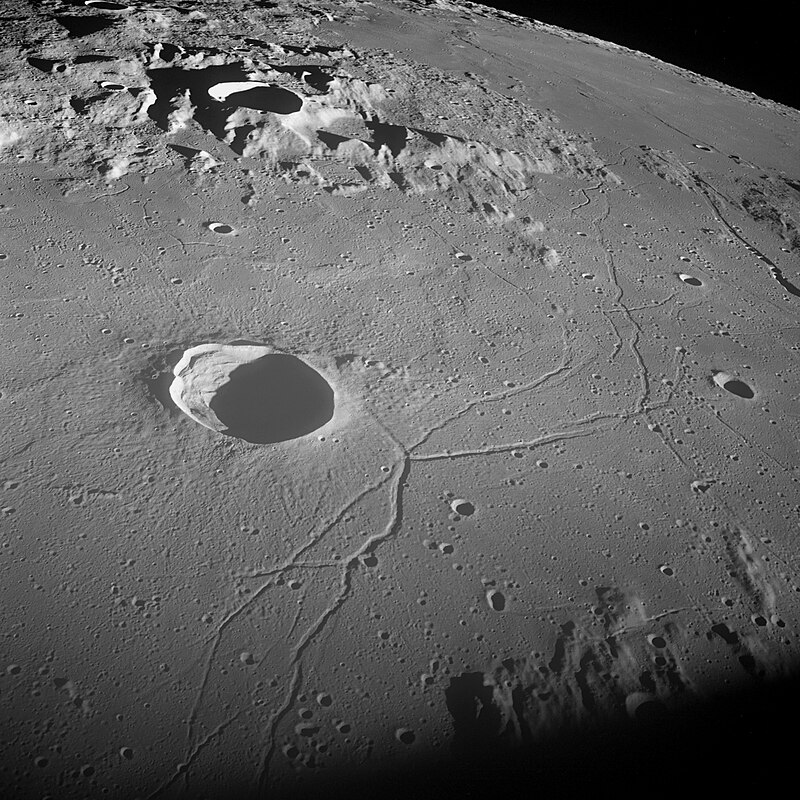 from Apollo 10
from Apollo 10Triesnecker
The crater and the rilles of that name are in the Sinus Medii. The area gets a mention in Earthlight, the 1955 novel by Arthur C Clarke. The protagonist, counter-espionage agent Sadler, is riding the monorail back from Hyginus Cleft to Central City.
He rode the spur-line back to Central City, over the incredibly broken terrain past Triesnecker. For almost all the journey the monorail track was accompanied by the pylons passing their loaded buckets out from Hyginus, and the empty ones back...
 Trivium Charontis / Cerberus form the dark thin triangle in the middle of this chart-fraction blown up from the NASA 1971 albedo features map
Trivium Charontis / Cerberus form the dark thin triangle in the middle of this chart-fraction blown up from the NASA 1971 albedo features mapTrivium Charontis:
Means "Crossroads of Charon". Latitude 19.7, longitude 162.
In The Sands of Mars (1951) by Arthur C Clarke, this is the location of the smaller of the two Mars settlements, Port Schiaparelli.
The second city of Mars held less than a thousand people, living under two domes on a long, narrow plateau. This had been the site of the original landing on Mars, and so the position of the city was really an historical accident. Not until some years later, when the planet's resources began to be better known, was it decided to move the colony's centre of gravity to Lowell and not to expand Schiaparelli any further.
The little city was in many respects an exact replica of its larger and more modern rival. Its speciality was light engineering, geological - or rather areological - research, and the exploration of the surrounding regions...
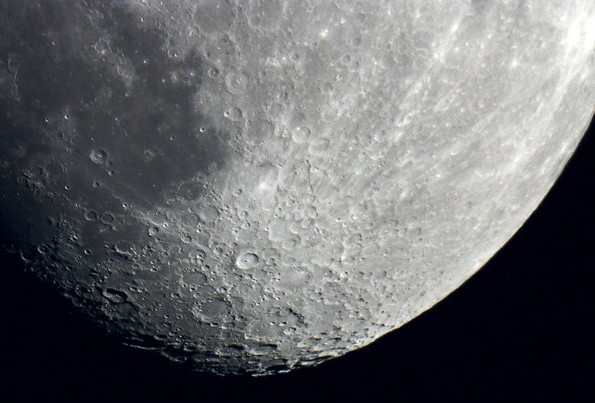
Tycho (crater):
This place is quite heavy with literary associations.
It's the scene of Trouble with Tycho (1961) by Clifford D Simak., in which prospectors come up against a strange form of life.
You
stand up on the rim and look down and there is Tycho, spread out like a
map before you, wild and savage, raw and cold and hard, like the
entryway to hell...
This same crater is also the birthplace and home of Captain Future, whose parents, Roger and Elaine Newton, fled there to escape the villain, Victor Corvo.
...Upon
the moon, beneath the surface of Tycho crater, they built their
underground home. There a son was soon born to the man and woman - a
red-haired baby boy they named Curtis...
Edmond Hamilton, Captain Future and the Space Emperor (1939, 1967).
Tycho crater is also "the site of the buried Luna City" in Isaac Asimov's The Singing Bell (Fantasy and Science Fiction, January 1955).
The "Tycho Magnetic Anomaly" in Arthur C Clarke's 2001: A Space Odyssey
(1968) - both the book and the concurrent movie - is strong magnetism
which turns out to be caused by the alien monolith buried beneath the
crater's floor.
In Heinlein's The Moon is a Harsh Mistress (1966), Tycho Under is one of the more vulnerable lunar settlements,
a big natural bubble cave... roof only metres thick... would not take much of a bomb to crack Tycho Under.
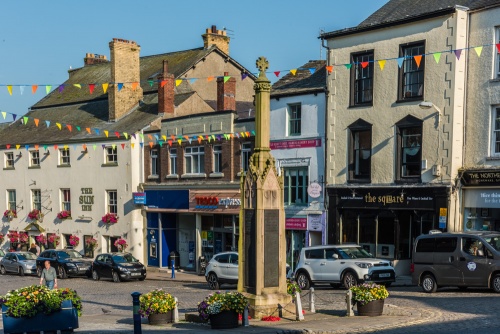
Ulverston, Lancashire, England:
[note: Ulverston is in Lancashire-beyond-the-sands, that region of Lancashire which after 1974 was put into "Cumbria", for those who take notice of such impertinences. I've been a few times to this fine old town.]
"...There I was... sat there in The Globe in Ulverston, downing a pint of Hartley's best... Used to take the bus through to Ulverston every Thursday, 'cause it's market day and the pubs stay open right through... Next thing I knew I was awakening up in this very room... just where you are now..."
Thus a character named Thwaites tells Ray Jerome, protagonist of Bob Shaw's 1984 novel Fire Pattern, of his sudden translation into a body on Mercury.
Urbana, Illinois, USA:
"I am a
Hal Nine Thousand computer, Production Number 3. I became operational
at the Hal plant in Urbana, Illinois on January 12, 1997..."
Arthur C Clarke, 2001: A Space Odyssey (1968)]
Vallis Alpes - see under Alpine Valley
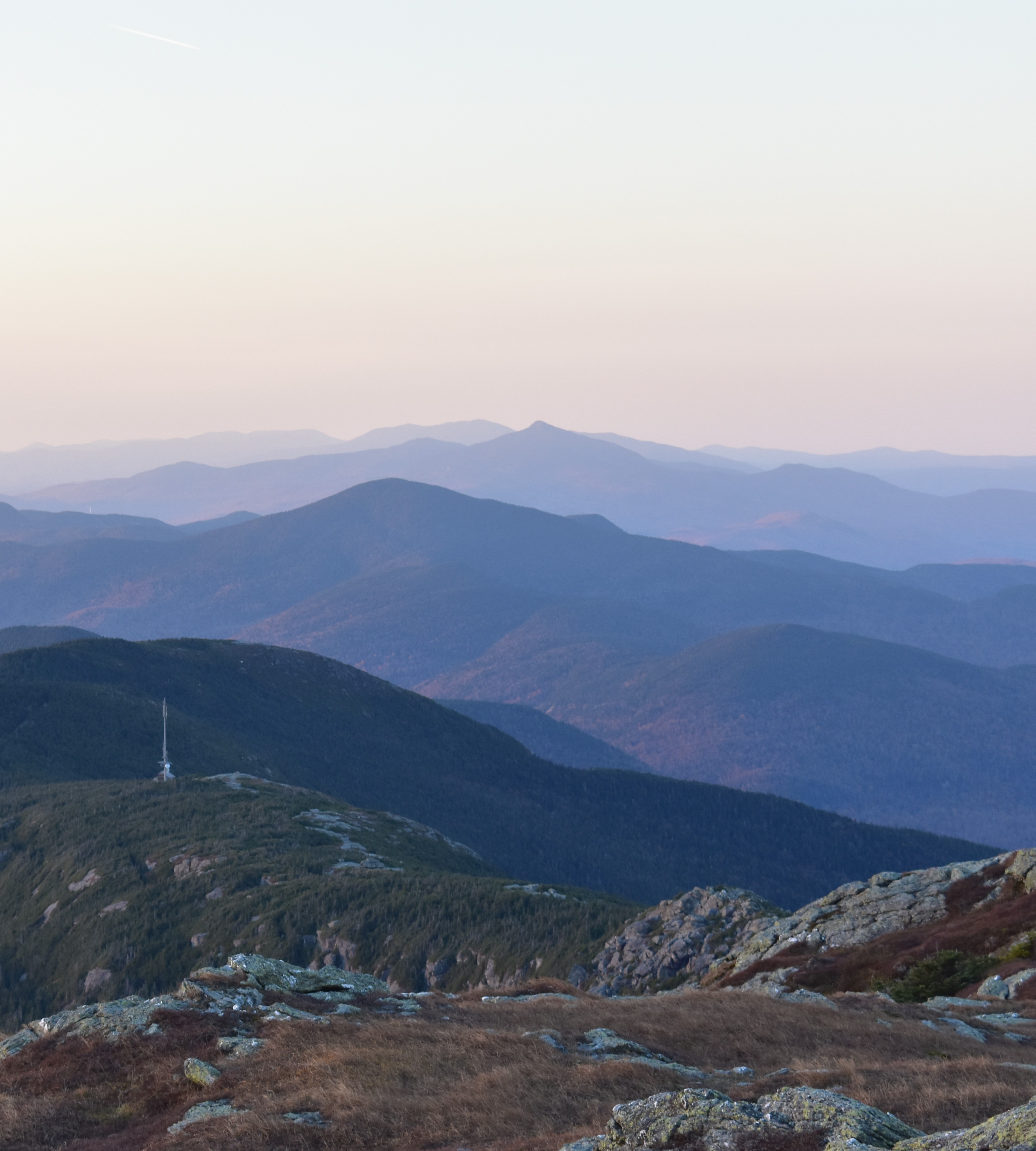
Vermont, USA:
The state is the setting for The Whisperer in Darkness (Weird Tales, August 1931), the science-fictional horror novella by H P Lovecraft.
The quaint, sightly village of Newfane, reached in less than an hour, was our last link with that world which man can definitely call his own by virtue of conquest and complete occupancy. After than we cast off all allegiance to immediate, tangible, and time-touched things, and entered a fantastic world of hushed unreality in which the narrow, ribbon-like road rose and fell and curved with an almost sentient and purposeful caprice amidst the tenantless green peaks and half-deserted valleys. Except for the sound of the motor, and the faint stir of the few lonely farms we passed at infrequent intervals, the only thing that reached my ears was the gurgling, insidious trickle of strange waters from numberless hidden fountains in the shadowy woods...
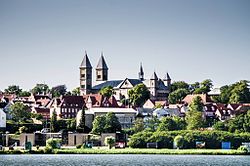 Viborg's cathedral seen from the lake
Viborg's cathedral seen from the lakeViborg, Denmark:
Kentuckian anthropologist Malcolm Lockridge, caught up in a time-war, comes to Viborg in the 1530s in the company of a girl from the far further past, in The Corridors of Time (1965) by Poul Anderson.
In awe, the Neolithic girl asked, "Is the Knossos they tell of as great as that?"
Despite weariness and unease, Lockridge had to grin. To his eyes, sixteenth-century Viborg was like the crossroads town where his parents used to shop. Much prettier, though, especially after two days of heathland. And it promised snugness, now when the last sunlight speared through rainclouds rising blue-black on a wind that flapped his cloak and wistled of winter.
Past the lake, he glimpsed through an oak grove (the beeches had still not driven the king tree out of Denmark) the warm brick hue of an abandoned monastery. Hard by, the city walls retained some green in the grass that covered their lower embankments. The same tinge was given by moss to such of the high-peaked thatch roofs as he could see. Spare and graceful, the cathedral's twin towers reached for heaven.
"I think Knossos may be a little bigger," he said.
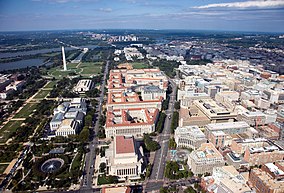
Washington, D.C., USA:
Congressman Wes Dawson is euphoric as he contemplates being allowed into space to meet the alien vessel which is approaching Earth, in Footfall (1985) by Larry Niven and Jerry Pournelle.
Wes strolled quickly through the Federal Triangle and along Independence Avenue. He'd done that often, but he still tended to gawk at the great public buildings along the way. It was all there. Government granite, magnificent buildings in the old classic style, built to last back when America had craftsmen able to compete with the great builders of old Greece and Rome...

Westminster, Middlesex, England:
The political nerve-centre of Britain has become extremely security-conscious in the 1990s, in Dan Morgan's The Country of the Mind (1975).
The twenty-metre high grey walls of the Westminster Citadel enclosed a rectangular area bounded on the north by Trafalgar Square and Northumberland Avenue, and on the south by Horseferry Road. Its western border cut through part fo what had once been St.James's Park, and on the east the wall followed the line of the river bank, from the Victoria Embankment to Millbank. A fortress enclave within the city, it contained most of the institutions of government including the new Houses of Parliament and all the major ministries, as well as living accommodation for four thousand people. Another five thousand Civil Servants of various grades commuted daily from other parts of the city, entering the Citadel through one of the four gates...
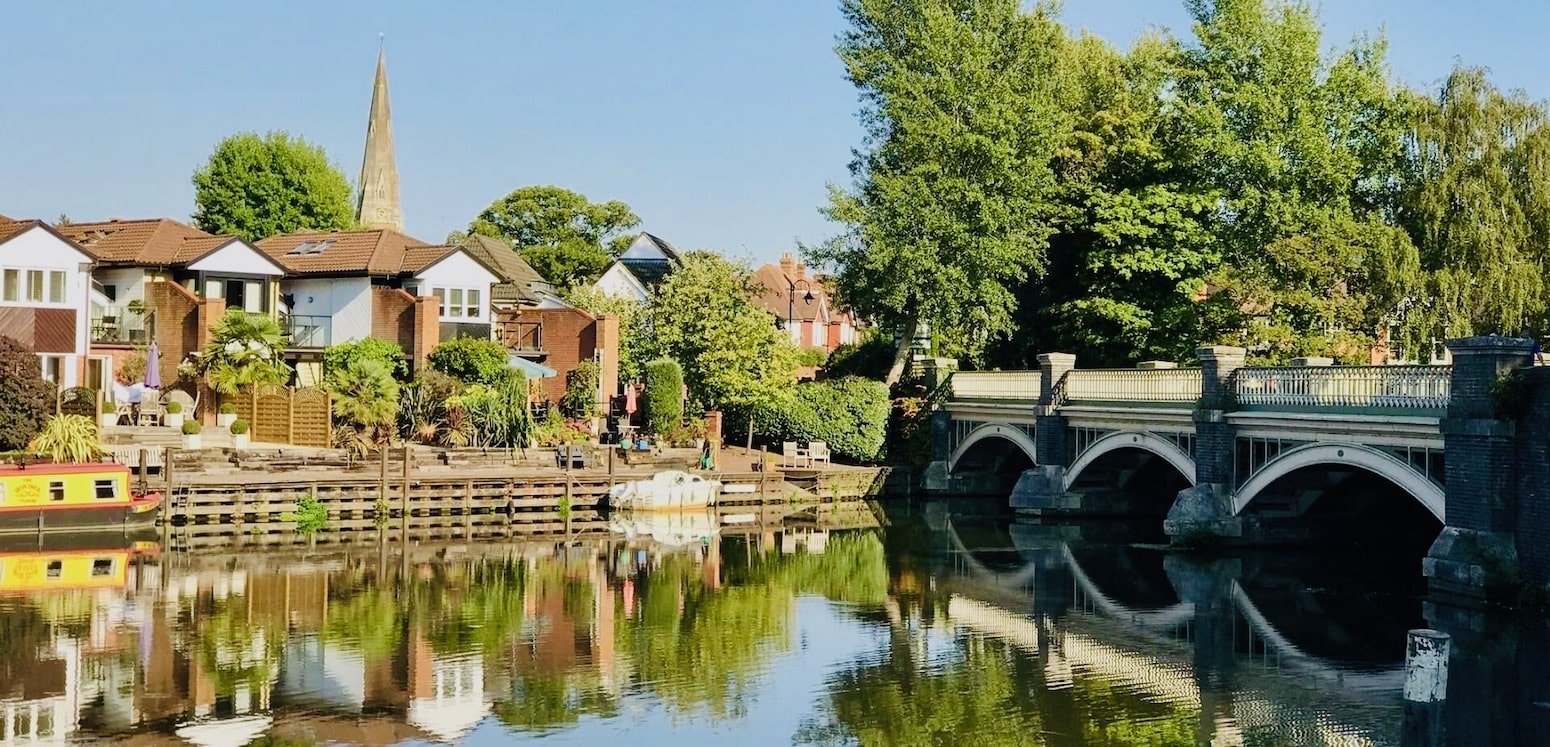
Weybridge, Surrey, England:
Suffered in the Martian invasion described by H G Wells.
Further on towards Weybridge, just over the bridge, there were a number of men in white fatigue jackets throwing up a long rampart, and more guns behind.
"It's bows and arrows against the lightning, anyhow," said the artilleryman. "They 'aven't seen that fire-beam yet..." The War of the Worlds (1898).
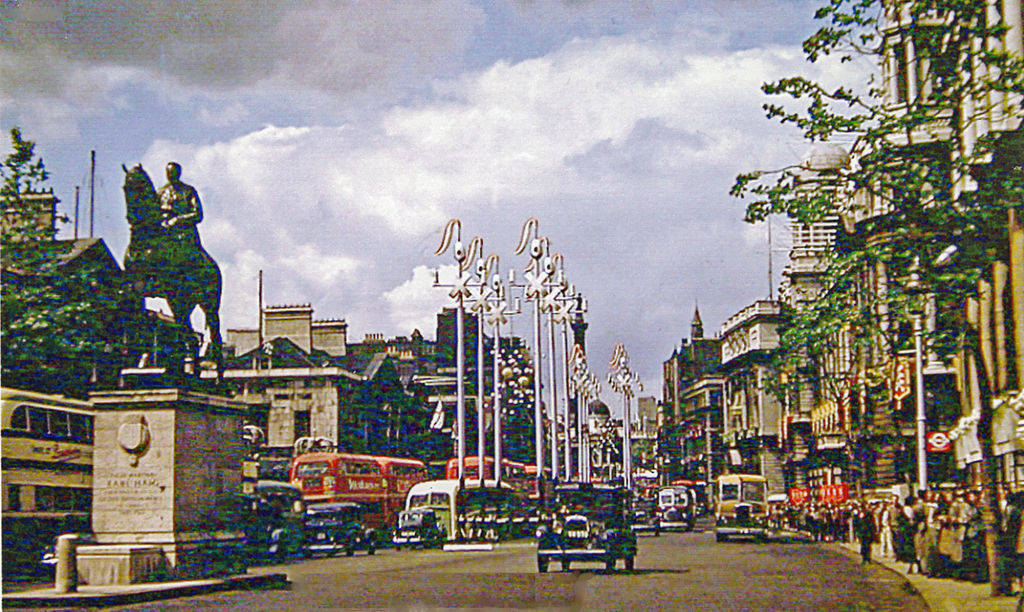 in 1953
in 1953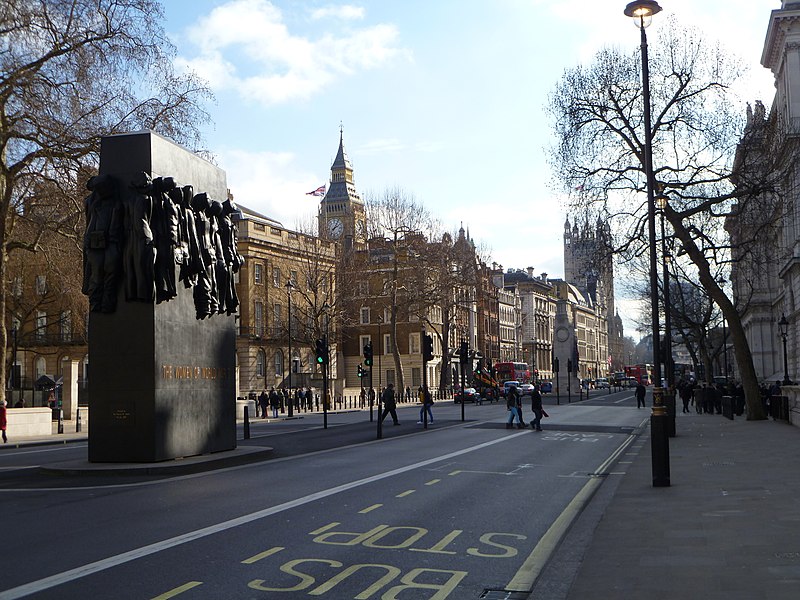 in 2012
in 2012Whitehall, London, England:
From the climate-warfare novel White August (1955) by John Boland:
...The Prime Minister had also decided on new quarters for himself. A bedroom and study had been fitted out for him, just off the War Room, one hundred and forty feet below street level in Whitehall. His study opened directly off the huge map room, whose walls were covered by gigantic maps of every country and every sea and ocean in the world. On the opposite side of the map room a steel lined door led to the communications room...
...Warburton returned to the map room and walked round the gigantic plotting-table. The table, fifty feet by forty feet, had an outline of the British Isles upon its glass surface. This was the room from which the Battle of the Atlantic had been fought in World War II. Now it was destined to be the nerve-centre of a new, more deadly struggle...
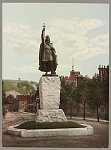 the King Alfred statue, High Street, Winchester
the King Alfred statue, High Street, WinchesterWinchester, Hampshire, England:
Luke Perry is the headstrong heir-apparent to his father who rules the town in the post-disaster novel The Prince in Waiting (1970), volume one of a trilogy. Author John Christopher, in narrating Luke's story, allows us snapshots of Winchester in that future era.
Winter ended at last in a thaw accompanied by rain-storms which made the river flood its banks; the waters rose at one point to lap against the block of stone in the High Street which still carried the broken legs of what had been a statue - of a great Prince of ancient times, it was said...
In the same novel, what are presumably the remains of the Cathedral are described simply as The Ruins.
[Personal note: I saw the Alfred statue and visited the Cathedral when looking around Winchester in the late 1980s, on the occasion of an unsuccessful job-application.]
The same author, in his climate-disaster novel The World in Winter (1962), briefly describes the town as the Nigerian expedition passes through:
...The squadron pushed on in the afternoon, north-east in the direction of London. They followed the Itchen valley to Winchester, where they saw the first signs of human life in England. Figures moved across the snow at the edge of the town. They fled to the cover of the buildings when Mutalli diverted the squadron towards them...
Woomera, South Australia:
Launch site of the first manned space-rocket (a sub-orbital flight) in Hugh Walters' Blast Off At Woomera (1957) and of the first manned rocket (to Mars) in Rex Gordon's No Man Friday (1956). See also The Old Space Program.
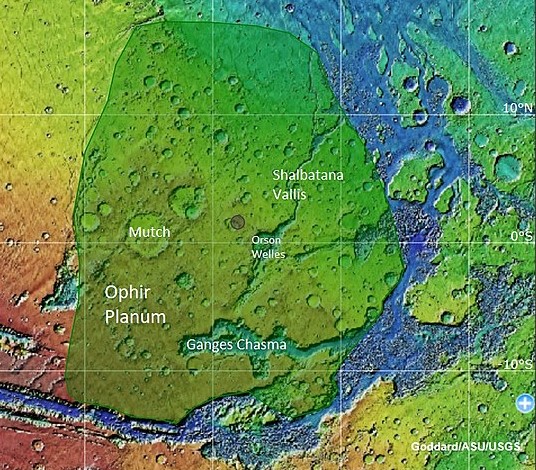
Xanthe:
In The Sands of Mars (1951) by Arthur C Clarke, this region of Mars is mentioned as a natural resource of magnesium for the colony:
"...The best source of that's the old sea bed: there are some salt flats a hundred metres thick out in Xanthe and we just go and collect when we need it."
Note: I've been trying, and failing, to find evidence to identify the "Xanthe" of the above quote with the "Xanthus" of Weinbaum's A Martian Odyssey - the place where the narrator meets the barrel-creatures. "Xanthus", an old telescopic albedo feature, is given online as being at 45 South, 125 East; Xanthe Terra at 3 North, 312 East. Not much relation.
Yarborough, Lincolnshire, England:
In the second volume of Dan Morgan's tetralogy about a community of telepaths, a working-class journalist has problems with his post in-laws.
Jerry Coleman eased his foot off the accelerator, as he recognised the familiar, tree-lined avenue. London Road was traditionally the 'better end' of Yarborough. Most of the big houses that stood on either side of the highway behind tall hedges were forty or fifty years old, built in the days of cheap domestic labour and gracious living for the privileged few. This was the secure, upper middle-class environment in which Sue had spent her childhood, and as such she was naturally at her ease here. He, on the other hand, found the very sight of these houses an inhibiting influence. In such surroundings his accent thickened, his limbs seemed to become automatically oversize, and he was once more the engine driver's son from the council houses on the wrong side of the gas works...
- The Several Minds (1969)
